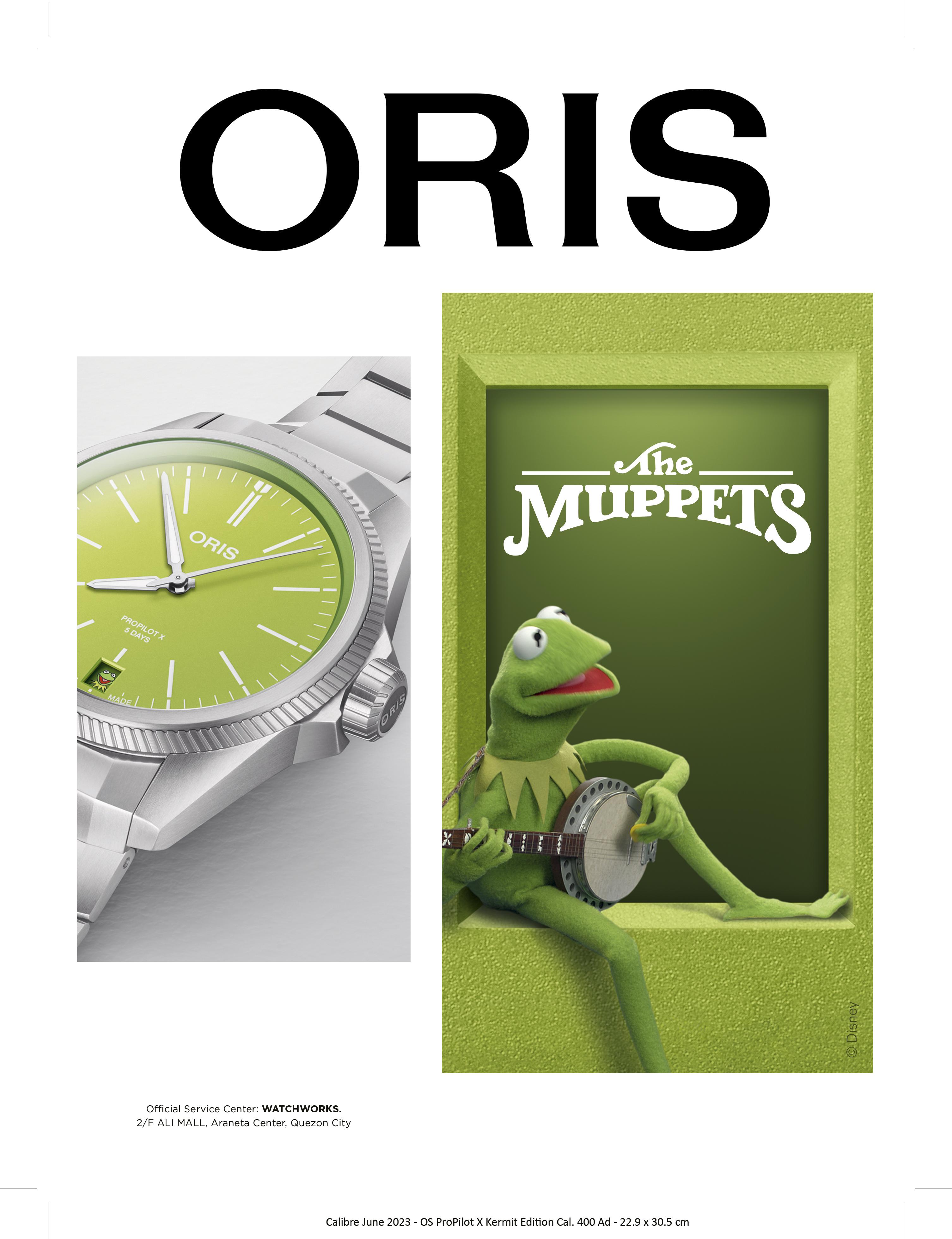





“ONCE I DREAMED TO BECOME THE FASTEST DRIVER. TODAY, I AM A DRIVER OF CHANGE.”
LEWIS HAMILTON, 7 TIME FORMULA 1 TM WORLD CHAMPION







“ONCE I DREAMED TO BECOME THE FASTEST DRIVER. TODAY, I AM A DRIVER OF CHANGE.”
LEWIS HAMILTON, 7 TIME FORMULA 1 TM WORLD CHAMPION

Maximum performance and versatility: when it comes to chronographs, we have been setting ourselves the highest standards for more than four decades. Like with the 69000 caliber family, which we developed with an uncompromising focus on robustness and durability. Because only those who keep surpassing themselves can become the reference for others.

 IWC PILOT’S WATCH CHRONOGRAPH 41 TOP GUN
IWC PILOT’S WATCH CHRONOGRAPH 41 TOP GUN
Arecent issue with a vintage watch has gotten some mainstream attention because of what is being called an auction sale of a fraudulent or fake watch. This is unfortunately not as rare an occurrence as we would wish, whether by an auction house or what some people call a gray market seller of vintage or used watches.
Now, we think secondary markets are a key part of the financial and economic world, and by nature there is nothing intrinsically wrong with them. However, unlike in cases of other more prevalent secondary markets like the stock market or real estate or other securities, products like watches have very specific individual identities. They are not similar products. Think more of art. Or cars.
Particular recent discussion is on a watch that seems to have been put together by taking pieces of other watches. This isn’t particularly unusual to be honest. Remember that watches were never really meant to be the “collectibles” they have become, they were meant to be tools. And even with the highest level of watch maintenance practices, if a better product comes along the service center would be inclined to replace the old one with the better one. This also happens in other industries like cars and accessories and such. Nowadays though, those that know tend to stipulate no changes if they are looking for a perfectly preserved piece.
Some concerns that were brought up for this watch were because they were able to trace the vintage dial with particular marks and scratches with a watch previously sold and for which there were photos available online. However certain other details weren’t matching. The level of patina seemed to have changed inconsistently. And that is what we are focusing on here.
There have regularly been established watch sellers who talk about how they would “age” a watch because that is what the client wanted, or what potential clients were looking for. This wasn’t really as gray an area before as it is now because quite frankly there was more knowledge going into buying these watches before. Conversely, there is more access to information now than there was before.
How do you deal with all this? Remember that you are always buying the seller before you are buying the product. You need to trust them. And you need to educate yourself because in this world don’t expect the shop selling to you to do that. Unless you seriously know them, these days are gone.
There is nothing wrong with buying a “mismatched” (an oversimplification) watch if you know what you are getting. And there are different levels of proper matching anyway. All original and untouched? Period correct parts but changed? Brand correct? All of these have their own buyers and detractors, and they aren’t even always fraudulent. They are just the practice of the time by the person who at that
time was working on the watch. This is similar to things like restoring cars, or art pieces, or buildings. This isn’t as simple as a reference number and the trend that everyone is talking about at the moment.
But then, nothing really is. When things look simple and easy to people it is usually a sign that you may not know as much as you think. The enjoyment isn’t in the payoff, it is in the experience.
Carl S. Cunanan Editor-in-chief



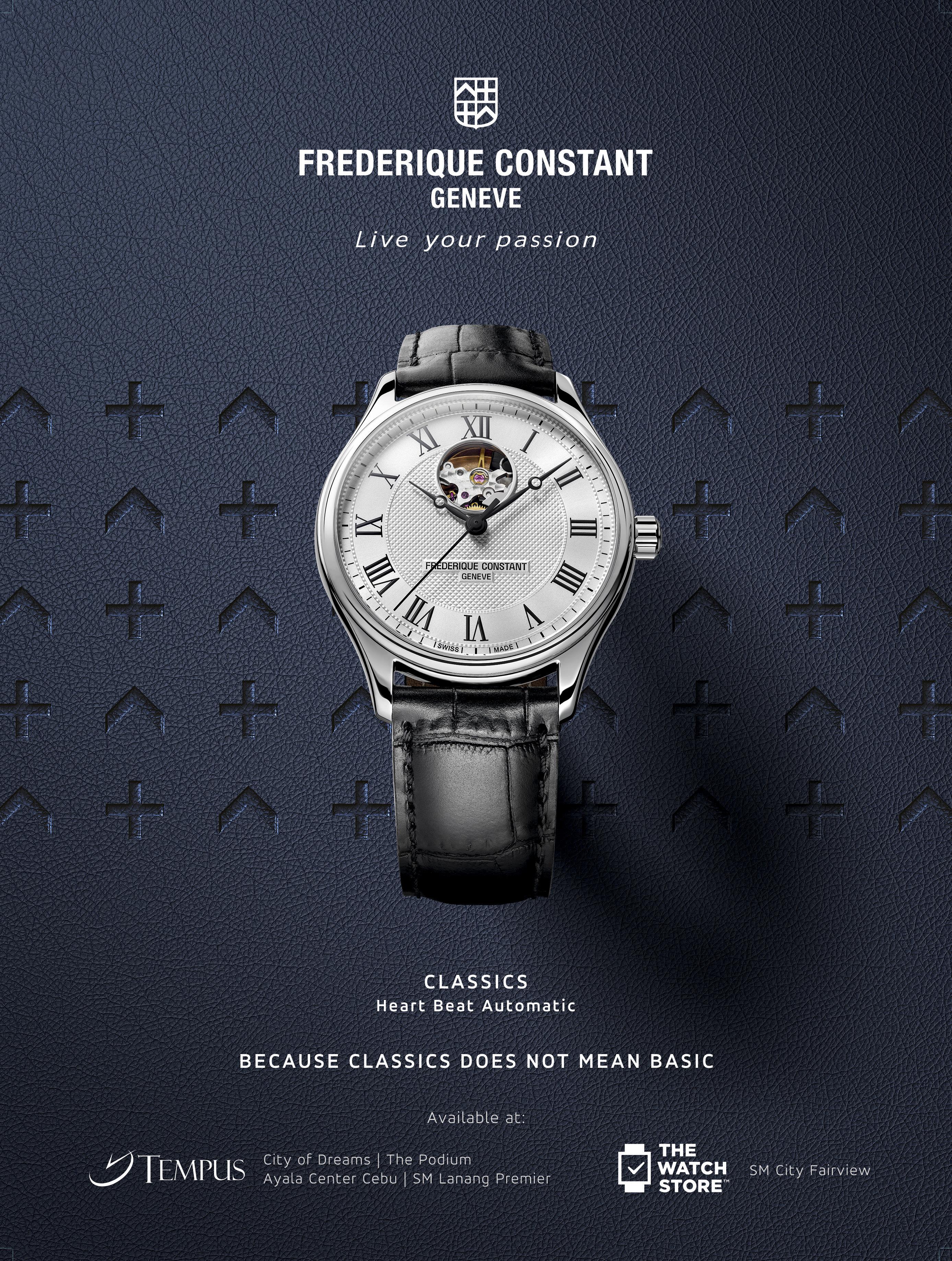
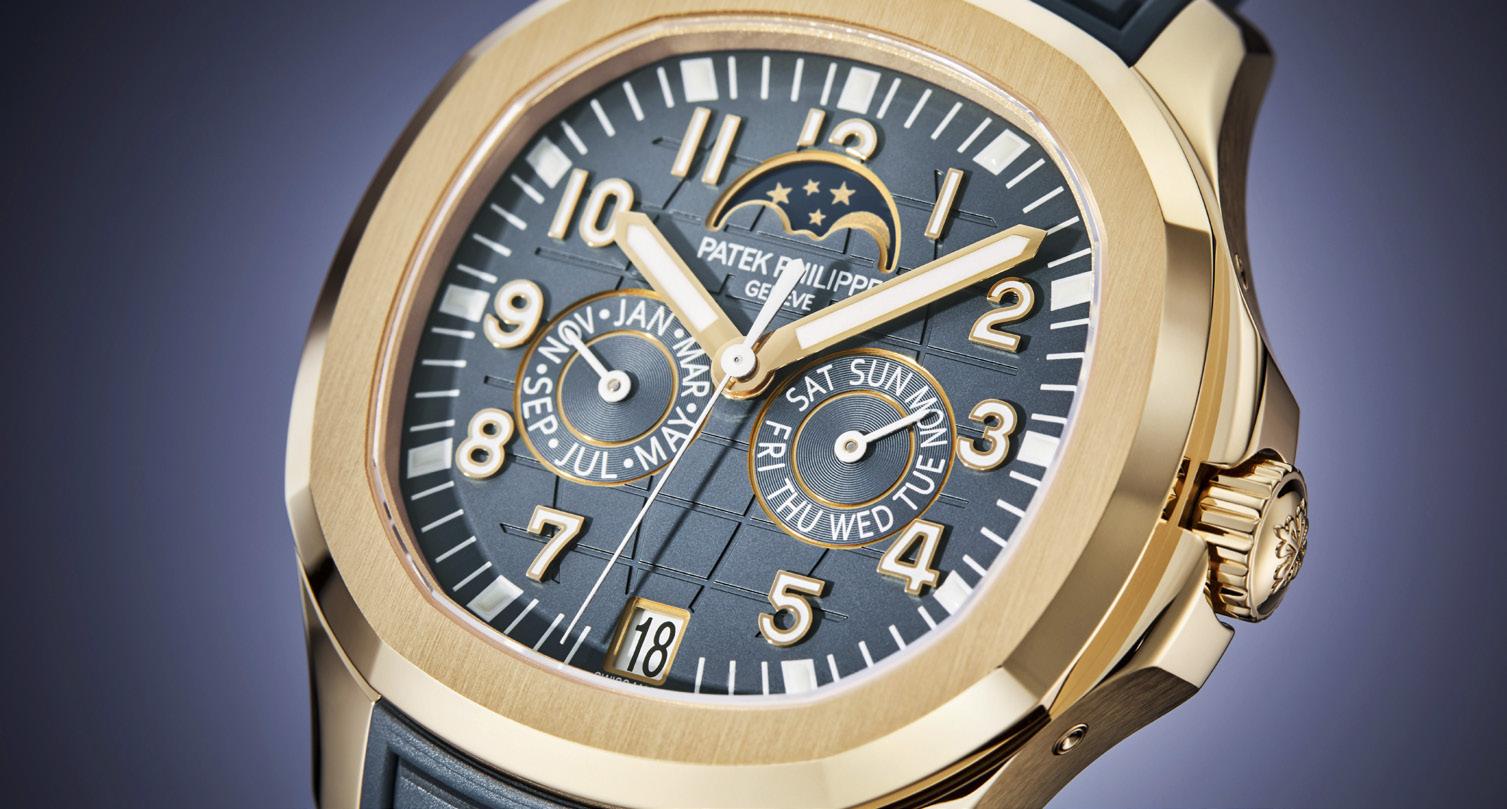
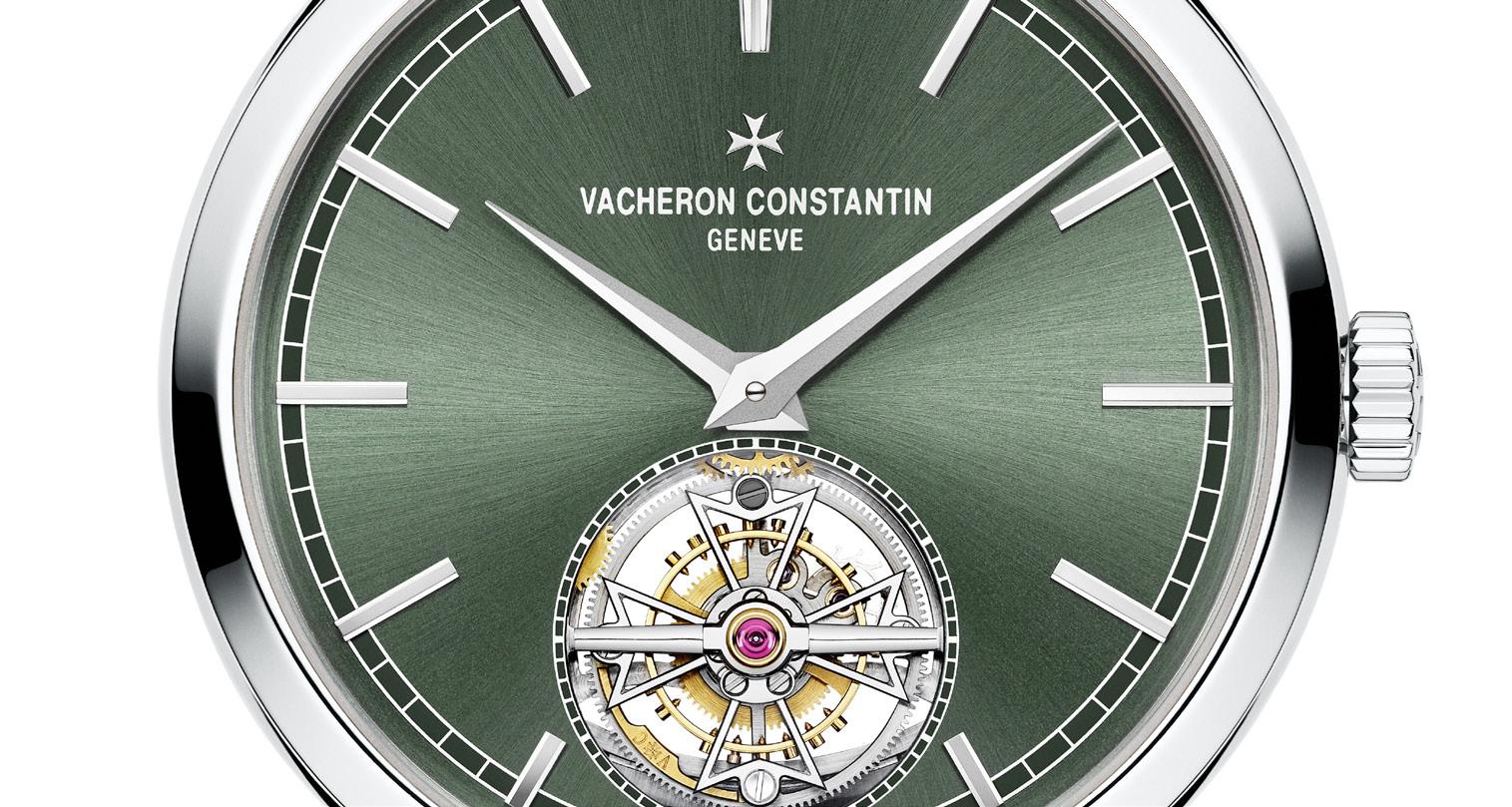

The new Lexus IS is the first Lexus model that was born and bred at the Shimoyama Technical Center Test Track — where the toughest and most challenging roads in the world have been recreated.
Imagine a road course that duplicates every possible kind of on-road scenario in the world. One that has every type of corner radius, every conceivable bank angle, and every kind of elevation change that you can possibly encounter when behind the steering wheel. A road where vertical changes are so severe and abrupt that finding the proper suspension damping setting is critical. In a place like this, the stability and handling of a car would be put to the test.
One such course already exists, and it is the historic Nürburgring Nordschleife in Germany — an automotive Mecca where manufacturers test their newest performance models. Lexus is no stranger to the Nürburgring Nordschleife. The company has developed a number of its iconic models on that hallowed road course — and it has even raced there. This is proof that Lexus continues to intensify its dedication toward building ever-better cars by honing them thoroughly under exacting driving environments.
The creation of the all-new Lexus IS is no different, except this time, the model was bred on a test track that Lexus calls its own. Based on in-depth testing and racing experience on the Nürburgring Nordschleife, which is famous throughout the world for its gruelling driving conditions, Lexus has designed its own challenging test course in Japan’s Aichi Prefecture that takes advantage of local topography and features a roughly 75-meter change in elevation between its highest and lowest points — as well as a wide range of curves and corners. This is the Shimoyama Technical Center Test Track — where the Lexus IS was born. Modelled after the Nürburgring, this test course is evidence of the company’s passion for performance.
“With the aim of making ever-better cars, we have continued to make various efforts in “feeling the road” and “conversing with cars” through driving tests around the world, including our Five Continent Drive Project and the Nürburgring 24 Hours endurance race,” said Lexus Master Driver Akio Toyoda. “Based on such experiences, we have replicated a variety of roads in the world at the new test course. In addition to conducting driving tests all over the world, and with the replication of severe driving conditions at the new test course, we intend to thoroughly hone every one of our models and develop the types of cars that epitomize the true joy of driving.” The Lexus IS is the very first of these
cars to emerge from the Shimoyama Test Track.
Utilizing the demanding road course, every performance aspect of the IS was finely tuned, from the engine, transmission, chassis, suspension, and safety systems. The F Sport variant has a 300hp, 380Nm naturallyaspirated V6 engine and eight-speed automatic transmission, while the IS 300h is powered by a 2.5-liter inline four-cylinder hybrid power plant mated to a Lexus E-CVT intelligent transmission. The IS comes with the LSS+2 — a suite of the latest Active Safety features — such as the Dynamic Radar Cruise Control, Lane Tracing Assist, and the Automatic High Beam. The F Sport model comes equipped with the upgraded Pre-Collision system which detects oncoming vehicles and pedestrians, even when turning left or right at intersections. When the engineering, development, and design is powered by passion — as is the case with the

Lexus IS — the path toward reaching new horizons and constant improvement is made even clearer. This instills confidence in the driver and gives him full control on the straight paths and total precision through even the sharpest turns.


When the Shimoyama Test Track becomes fully operational, it will employ 3,000 personnel. However, even during the recent development of the new IS model, 50 test drivers have already made the technical center their second home. It is obvious that the passion to build better cars has led to the creation of this unique road course, which in turn has helped sharpen the IS into the finely tuned driving instrument that it is.
This is the spirit of ‘omotenashi’, where a customer’s needs have been anticipated long before they realize it themselves. That is the kind of hospitality that you would only expect from Lexus. Experience it for yourself with the IS sport sedan.






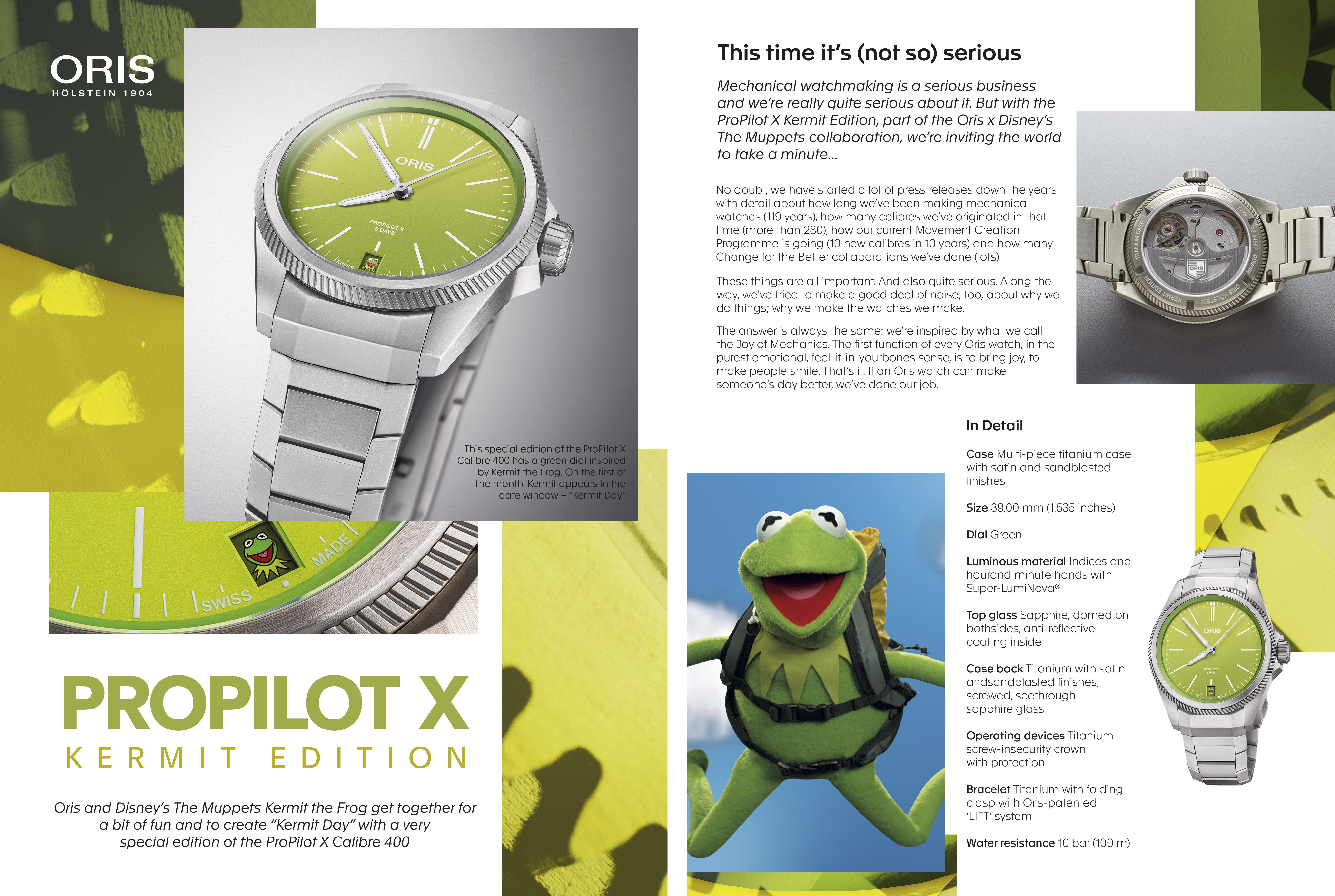

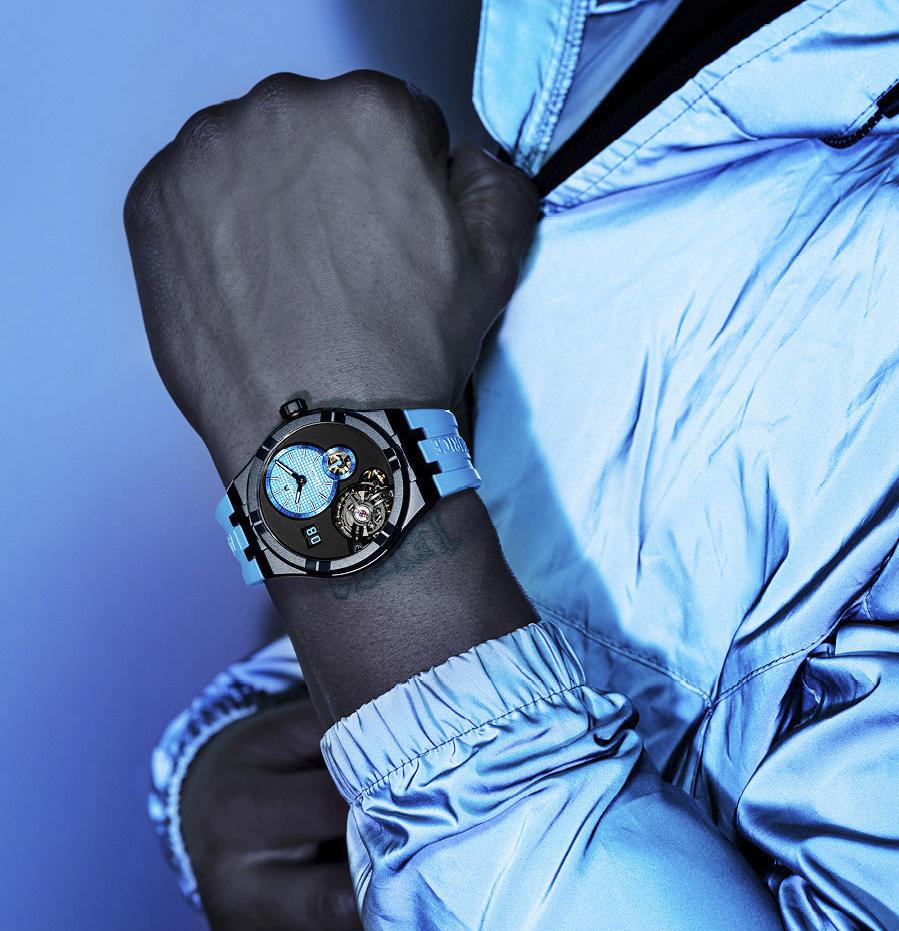

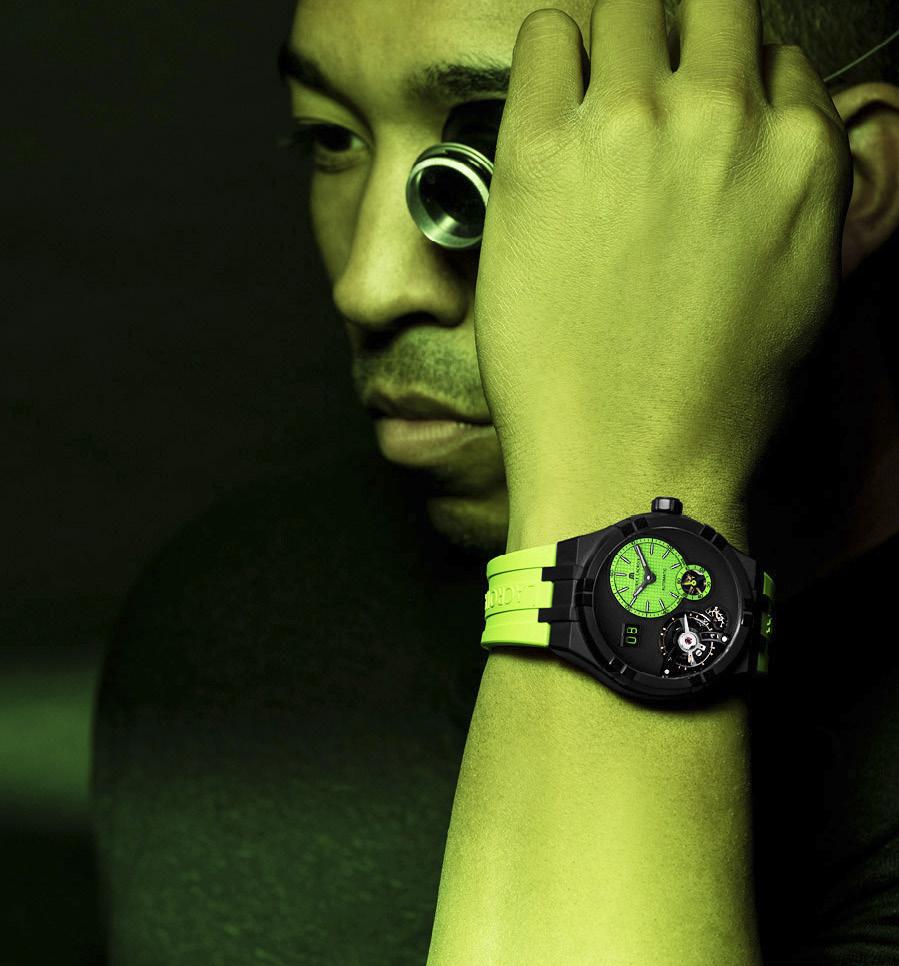




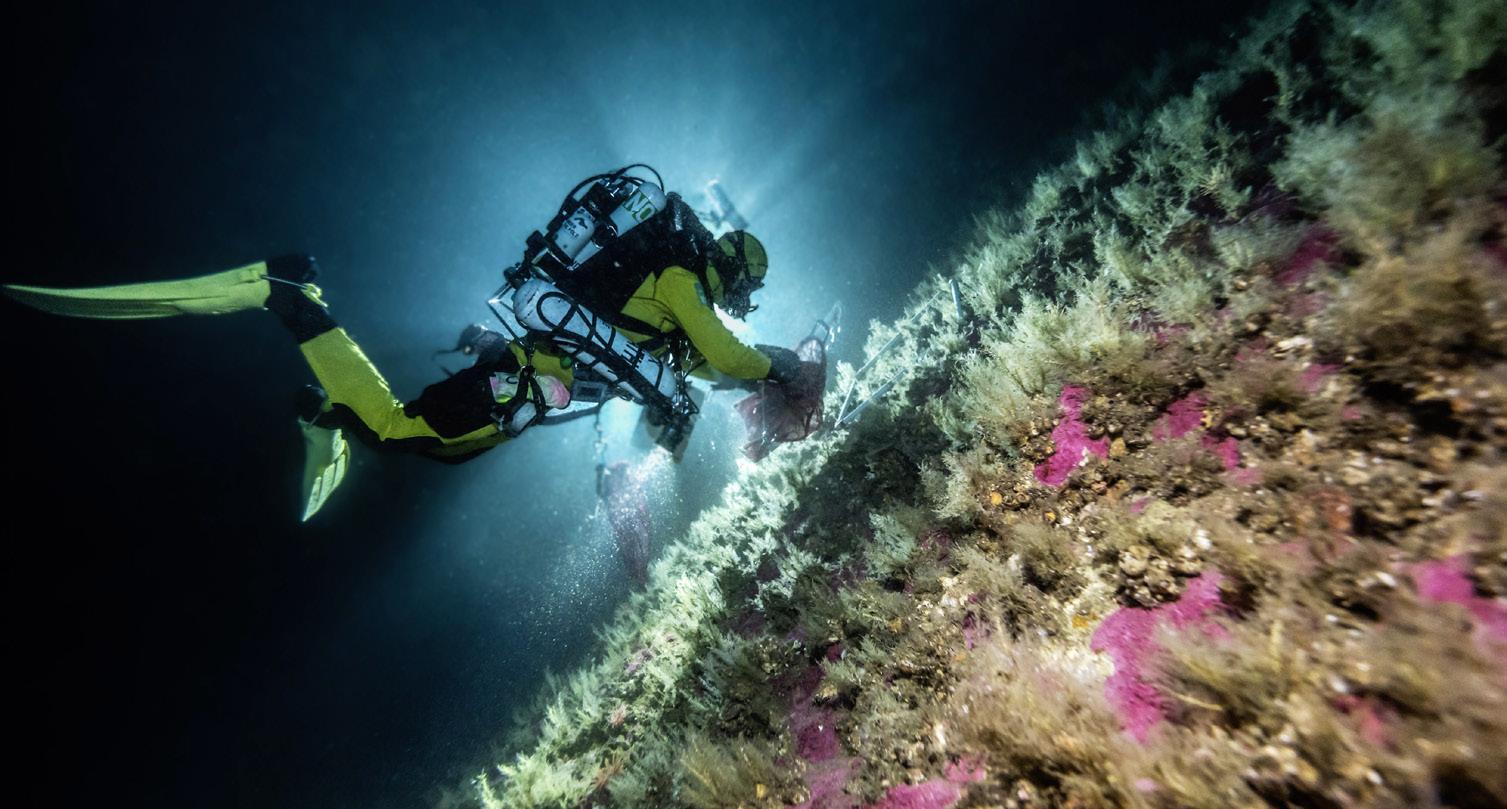
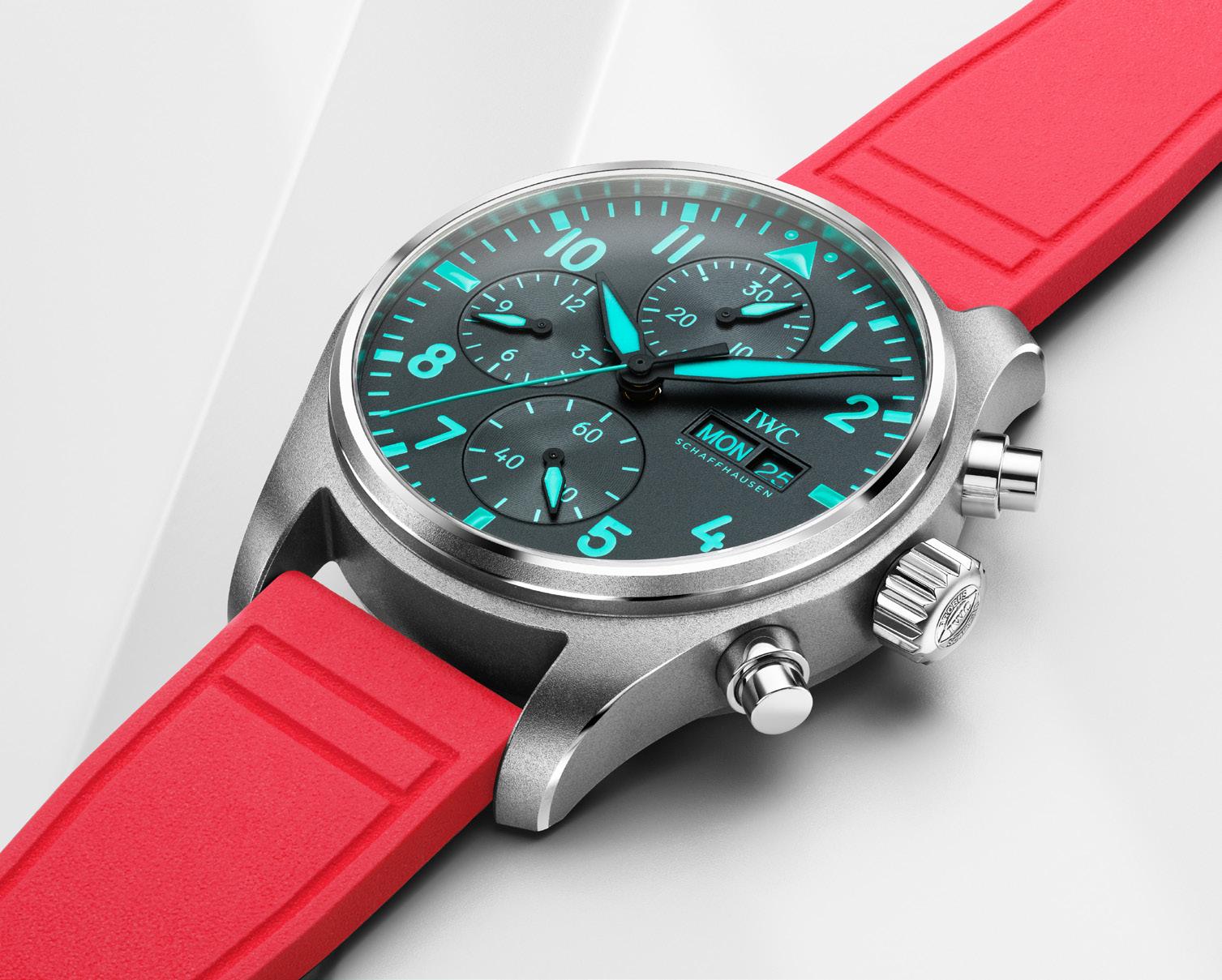

Carl S. Cunanan
Editor-In-Chief
Mayette
C! Publishing and Media Group, Inc. Publisher
Executive Editor
Senior Editor
Hernan C. Mapua
Collections Editor
Jason S. Ang
Associate Editor
Kit O. Payumo
Senior Staff Writer
Alberto E. Casal
Editor-at-Large
Bryan Martin B. Zialcita
Design Director
Charie L. Biaden
Senior Designer
Mark David A. See Designer
Mary Ann E. Marcelo
Contributing Writers
Katherine S. Cunanan
Jose Martin V. Ursúa
Leonard Vincent L. Ho
Edrich Santos
Dominique O. Cerqueda
Contributing Photographer
Keith Sundiang
Advertising Traffic Manager Mary Jane O. Salazar
Joseph Peter C. Calimbas Chairman Michael L. Lhuillier
Account Managers
Malyn L. Bautista
Hiroshi D. Paderagao
Managing Director
Paolo M. Puyat-Martel
Board of Directors
Michael L. Lhuillier
Paolo M. Puyat-Martel
Carl S. Cunanan
Kevin C. Limjoco
Chief Operating Officer
Cecille Khristine D. Buenviaje
Vice President
Mayette L. Asis
Senior Accountant
Merline B. Urdas
Credit and Collection Officer
Mary Ann M. Benito
Legal Counsel
Paredes Garcia & Golez Law Office
@calibremagazineph
Calibre Magazine PH

facebook.com/calibremagazineph
twitter.com/calibremagph
I’ve been to Japan for both business and pleasure many times over the last 7 years. Since my first trip there back in 2016, it has gradually moved its way up to the top of my list of favorite countries to visit for vacation. Last week, I was fortunate enough to visit again and be a normal tourist for a whole week in a post-pandemic Japan.
My trip last week was a particularly special one since I was with family, and nothing beats spending time in one of the most amazing places on earth with two of my favorite people in the world. And as a bonus - the whole country still happens to be a great spot for watch hunting.
It’s not exactly a secret that there are a lot of 2nd hand watch stores in Japan. In Osaka, the whole stretch of Shinsaibashi is peppered with pre-owned luxury goods stores which also includes watches, bags and other highvalue items. For several years, these stores were my primary destination each time I would visit Japan.
This time around, I found myself visiting these very same stores again, but in a different
capacity. Instead of me actively searching for bargains, I was just a tour guide to my family who also wanted to explore this magical place where reasonably priced grail watches were supposedly in abundance. Though prices have risen compared to 4 or 5 years ago, there were still bargains to be found if you look hard enough and steer away from the usual hypedup models.
As per usual — BIC Camera and Don Quijote also had some gems hidden in
plain sight. Some very desirable brand-new timepieces were being sold at a discount, and I couldn’t help but still be amazed at the variety of watches available at these ‘common’ malls which could be found in practically any big city in Japan.
This trip to the ‘Land of the Rising Sun’ was for the nth time already, and as usual, it didn’t disappoint. It’s still a place where good food, great sights, and amazing watches can be found.
Bryan Martin B. Zialcita Editor-at-Large
“THIS TRIP TO THE ‘LAND OF THE RISING SUN’ WAS FOR THE NTH TIME ALREADY, AND AS USUAL, IT DIDN’T DISAPPOINT. IT’S STILL A PLACE WHERE GOOD FOOD, GREAT SIGHTS, AND AMAZING WATCHES CAN BE FOUND.”

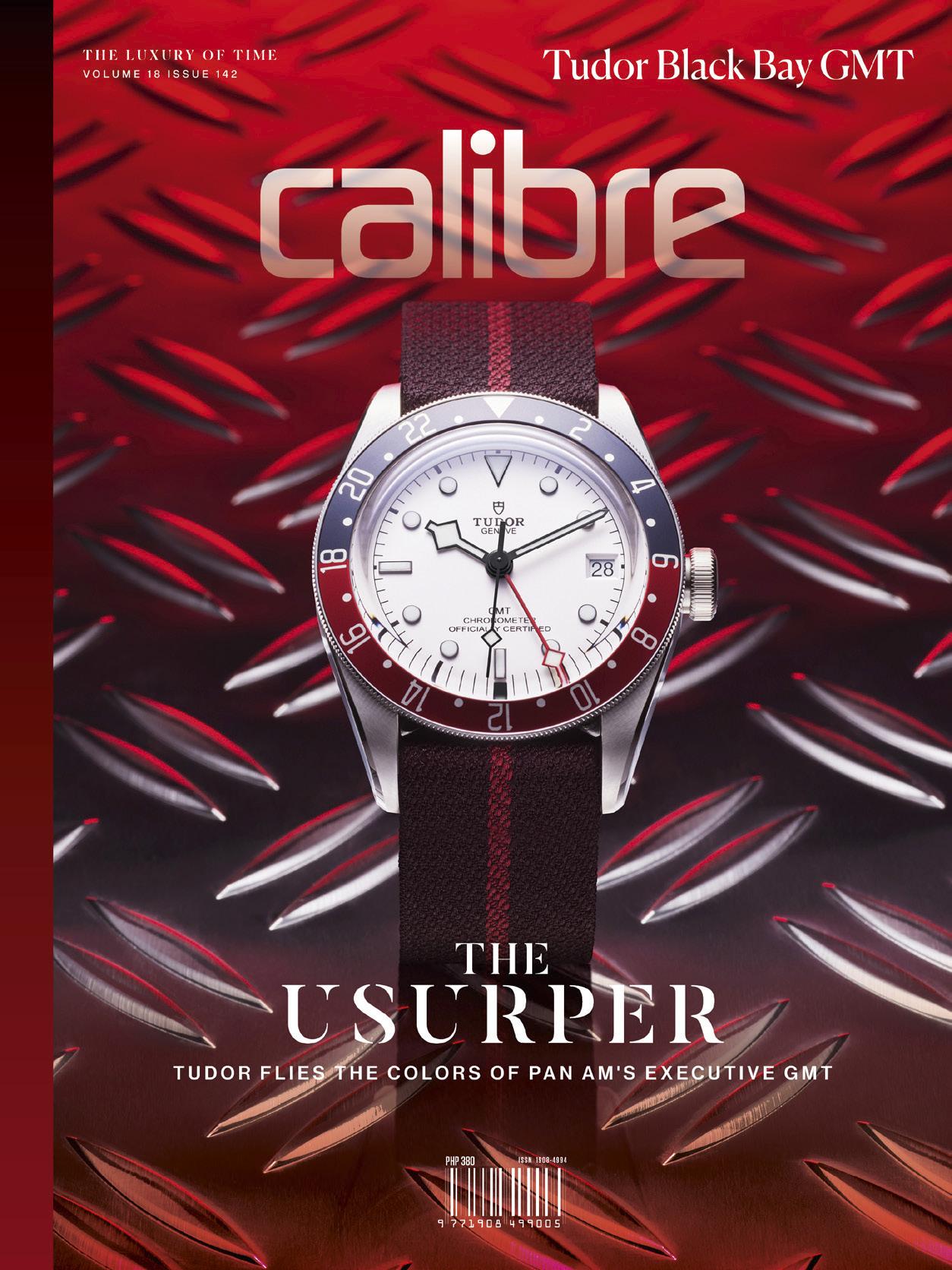
It all began at the end of 2021. Watchfinder released a video with the clickbaity title of “Expert Reacts to the Utterly Insane LV Tambour Carpe Diem.”
Before it, nearly all videos on this YouTube channel conformed with the “Talking Hands” format: The camera looks down on a workbench, a pair of hands manipulates the subject of the piece, dramatic music plays in the background, and a soothing RP English accented voice narrates the proceedings. These are terrific videos (“content”), smartly written and professionally produced, but they often feel a bit overly serious for my tastes. It’s as if I were watching Christopher Nolan’s latest, and needed to take notes over multiple viewings.
This Tambour video, dated 17 November 2021, started with the now familiar introduction of the US Marines Hymn, interrupted by a record scratch. The disembodied voice of the Talking Hands (Andrew Morgan) introduced his previously silent companion behind the camera (Tom) and it was immediately clear that this would be a much less formal and structured affair. Similarly apparent was the chemistry between the two and the quality of their banter. The new format was neither a review nor an essay, but rather a breezy back-and-forth similar to the chats that friends would have over a cup or a pint. Until very recently, neither man appeared on camera, with each instead represented by a picture of a microphone: a Shure for Andrew, and an RCA for Tom. With 165 in the can at the time of writing, each episode is typically 20 to 30 minutes long, and encompasses discussions into brands or
genres, reviews of novelties at Swiss watch fairs, interviews with industry figures and other media personalities. My personal favourites are the contests: Andrew (as the learned and passive-aggressive expert) challenges Tom (playing the role of the innocent, affable watch novice) to, say, match a selection of $200 watches against his choices. Whether the exercise results in genuinely new purchasing ideas for the viewer, or nothing but laughs, I consider viewing them time very well spent.
It’s the tone and humor of each episode that really resonate. British wit, dry as cotton balls yet dripping with sarcasm, is mixed with more rapid-fire and juvenile sensibilities informed by The Simpsons circa 1994. The jokes are never predictable either in their setup or rhythm, but let’s not turn this into a dissection of funny. Either it works for you or it doesn’t. For me, it’s a direct hit. The ribbing is mostly good-natured and respectful, though both presenters will occasionally land a body blow. Andrew will hem and haw, and circle a target for ten minutes before delivering a 3-word demolition. Tom, to extend the martial metaphor, is more adept at sniping from a distance with seemingly innocuous comments that are, on reflection, no less devastating. Both are knowledgeable on the topics they cover, and contextualize them against the broader popular culture (as understood by thirty- or forty-somethings, at least!). Yes, I can nitpick some statements that Andrew makes about vintage subjects, but they generally do their homework.
The show is a much-needed tonic to coverage that has been far too worshipful and credulous. Over the past few years, I found my interest in new releases waning, partly due
to Covid lockdowns, and partly due to this endless attempt to gin up interest in more of the same. Andrew and Tom’s blend of respect and irreverence are refreshing. The watch industry absolutely needs a poke in the eye every now and then, especially in our postMoonSwatch, post-Tiffany Nautilus world. Our horological fascination is at various times ridiculous or glorious, achingly beautiful or nauseatingly tacky. I strongly recommend the Watchfinder podcast as a celebration of all of the above.
Final note: Despite multiple requests, the duo have rejected all naming suggestions (mostly groan-inducing watch puns) and the show is prosaically referred to as “Watchfinder Podcast.” Personally, I think they should take a page from motoring journalist Jonny Smith and start with “Watch Perverts” before sheepishly changing to “The Delrin Brake Show.”
Jose Martin V. Ursúa Contributing writer
Rolex Oyster Perpetual Yacht-Master 42
Once upon a time, famed British competitive sailor
Sir Ben Ainslie was photographed with a prototype Yacht-Master 42 titanium strapped to his wrist. That was several years ago, and the Rolexfaithful have wondered if the most famous watchmaker in the world will ever fulfill the promise of the mythical Yacht-Master in titanium ever since.
This year, the House of Wilsdorf finally made good on its promise. Making its debut at Watches & Wonders 2023, the new Oyster Perpetual Yacht-Master 42 in RLX titanium took a discrete but dignified
stance while making an emphasis in the much-imitated tool-watch category.
Launched in 1992 specifically for navigating the demands and pressures of competitive sailing, the newest YachtMaster makes no qualms about its toolwatch vocation, and makes proper use of its lightweight armor to best serve the brand’s rich connection with the world of sailing.
Unlike other models of the House of Wilsdorf, the new Yacht-Master 42 in RLX titanium stands out with a matt, technical satin finish with a visible grain, a finish that extends to the sides of the middle case, the edges of the bracelet links and the sides of the clasp cover. The chamfered top edges of the middle case lugs, meanwhile, have a high-sheen finish, while the crown guards are highly polished.
RLX titanium is a grade 5 titanium alloy specially selected by Rolex. Like all titanium alloys, it is especially lightweight and is noted for its mechanical strength

and corrosion resistance. This makes the new Yacht-Master 42 equally at home out of the water as well, making Rolex’s latest tool-watch exceptionally qualified to handle any land borne activity you can throw at it.
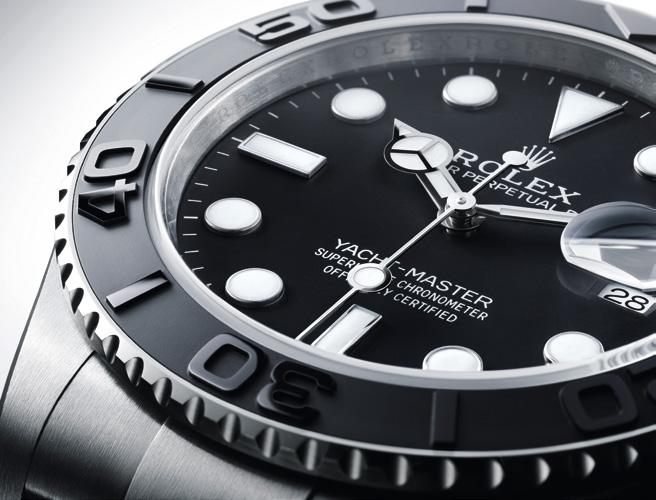

Then there’s the new bidirectional bezel, which sets the new Yacht-Master 42 even further apart from its ilk. The bezel with a knurled edge is fitted with a 60-minute graduated Cerachrom insert made of a distinct matt black ceramic, the raised graduations and numerals of which make it even more noticeable by first being moulded into the ceramic and then polished to create an evident visual contrast.
As usual, the 42mm Oyster case of the new watch is a paragon of robustness and reliability. Its middle case is crafted from a solid block of RLX titanium while its case back is hermetically screwed down and edged with fine fluting. Best of all, its Triplock winding crown screws down securely against the case and is fitted with a triple waterproofness system guaranteeing waterproofness to a depth of 100 metres (330 feet).
As before, this latest version of the Yacht-Master 42 is powered by the calibre 3235, a self-winding movement that has been driving the model since its launch in 2019. The movement benefits from the brand’s technical prowess and incorporates a patented Chronergy escapement made of nickel-phosphorus; a blue Parachrom hairspring; and high-performance Paraflex shock absorbers, which increases the movement’s shock resistance.
Like all Rolex watches, the new YachtMaster 42 is covered by the Superlative Chronometer certification and is matched with an Oyster bracelet also in RLX titanium. Known for its enhanced robustness, the bracelet is equipped with an Oysterlock folding safety clasp; the Easylink comfort extension link; and patented ceramic insets inside the links for enhanced flexibility and longevity, two words that, come to think of it, perfectly encapsulate the new Oyster Perpetual Yacht-Master 42.
Maurice Lacroix recently launched the AIKON #tide, an environmentally friendly watch made of ocean-bound upcycled plastic. The bezel, case, caseback, crown, and buckle are all made of this composite material, which is twice as hard and five times more resistant than standard plastic. It also has a carbon footprint significantly less that the production of virgin PET. Indeed, it takes 17 bottles to make one AIKON #tide together with its tailor made packaging resulting in 17 fewer plastic bottles polluting our oceans.

Designed specifically for members of Gen Z, the AIKON #tide was created to be urban, accessible, and success-driven. Indeed, the watch was a shoe in for their fast-paced and dynamic lifestyle. Which is why it was no surprise when the brand announced its partnership with one of the fastest growing sports in the world: FIBA 3x3 basketball.

From the streets to the Olympics, 3x3 basketball is a variation of the game in a half-court setup and is played with six players total, three-a-side, and with one backboard. Indeed, according to an ESSEC Business School study commissioned by the International Olympic Committee, 3x3 basketball (which made its Olympic debut for both men and women at Tokyo 2020) is the fastest growing urban team sport in the world…, which fit perfectly with Maurice Lacroix’s brand of urban sensibilities.
Sharing the same qualities as the other models of the AIKON #tide family, these FIBA 3x3 Special editions unites the brand’s most innovative model with the fast-paced sport discipline of 3x3
Maurice Lacroix gives us a basketball themed watchbasketball. Brimming with energy, the special edition AIKON #tide FIBA 3x3 is housed in a 40mm case, and features a flat sapphire crystal, as well as a quartz movement to deliver clarity and precision in the high impact world of 3x3 basketball.


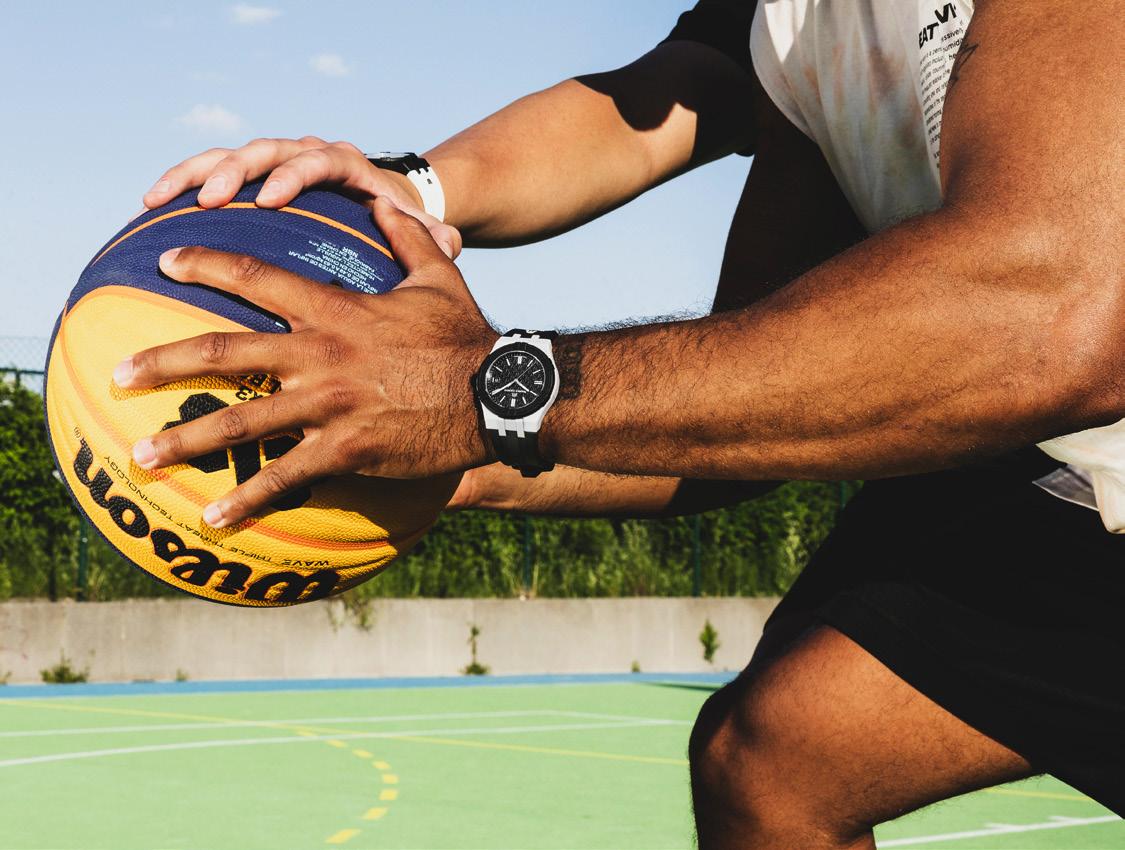

Following the inaugural versions of the AIKON #tide color aesthetic, Maurice Lacroix is back with another eye popping creation, this time inspired by the official Wilson basketball of the FIBA 3x3 World Tour.
Indeed, one of the main aesthetic benefits of ocean-bound upcycled plastic, is its ability to be colored in any hue imaginable, and this new model doesn’t disappoint with wildly colorful hues in blue, yellow and orange all in one watch! Best of all, its dial is adorned with the FIBA 3x3 logo which also appears on the caseback.
This colorful edition is joined by two models that are as monochromatic as the main model is colorful. Ideally suited for court-dwellers, these two models are available with black or white dials with contrasting or coordinated case bodies and straps. Again, the dials incorporate the 3x3 logo arranged in an elaborate motif, which is repeated on the caseback. And consistent with the brand’s environmentally conscious position, all three models of the AIKON #tide FIBA 3X3 is presented in a color coordinated mug, which can be used again and again.
In the end, know this: whichever special edition model you ultimately choose to wear, you will not only look cool but you will have contributed to cleaning up our oceans, and helped in the betterment of our world.
IWC makes its presence felt in Miami with vibrant pink.
Formula One is a sport like no other. It combines elite teamwork, cuttingedge technologies and innovation, high-performance management, and exceptional driving skills. IWC Schaffhausen became the official engineering partner of the MercedesAMG PETRONAS Formula One™ Team back in 2013. This year marks the tenth anniversary of that partnership.
As automobile racing’s elite gather in Florida for the second Miami Grand Prix™, IWC proudly presents the Pilot’s
Watch Chronograph 41 Mercedes-AMG PETRONAS Formula One™ Team watch with a Miami Pink rubber strap.


The chronograph is the first official team watch IWC has produced for its partner and pays tribute to the passion and determination of the team’s designers, aerodynamicists, race engineers, strategists, and mechanics. The pink strap perfectly matches the team’s appearance at the Miami International Autodrome, where eyecatching pink details will be featured on the gloves and shoes of Lewis Hamilton and George Russell. The team watch on the pink strap will also be worn by team members present at the race in Miami.
The Pilot’s Watch Chronograph 41 Mercedes-AMG PETRONAS Formula One™ Team is crafted from grade 5 titanium. IWC pioneered this material in the watch industry during the 1980s, when the company introduced the first wristwatch with a titanium case and bracelet. Titanium offers the highest strength-to-density ratio of any metal. It is about 45 percent
lighter than steel and is widely used in automotive engineering to manufacture components that are subject to extreme stains, such as engine valves. Titanium is also corrosion-resistant and hypoallergenic, making it friendly to the skin.

The chronograph is powered by the IWC-manufactured 69385 calibre movement. This robust chronograph movement in a column-wheel design comprises 242 parts and can be viewed through the sapphire glass back. Its bi-directional pawl winding system builds up a power reserve of 46 hours in the mainspring and has a frequency of 28,800 vph.

Another version of this watch comes with a green rubber strap that comes bundled with a black calfskin strap. The new reference on the Miami Pink rubber strap comes in a bundle with the green strap and can only be purchased online on IWC.com and in the Miami boutique for a limited time. The straps can be changed quickly and easily, thanks to the integrated EasX-CHANGE® system.


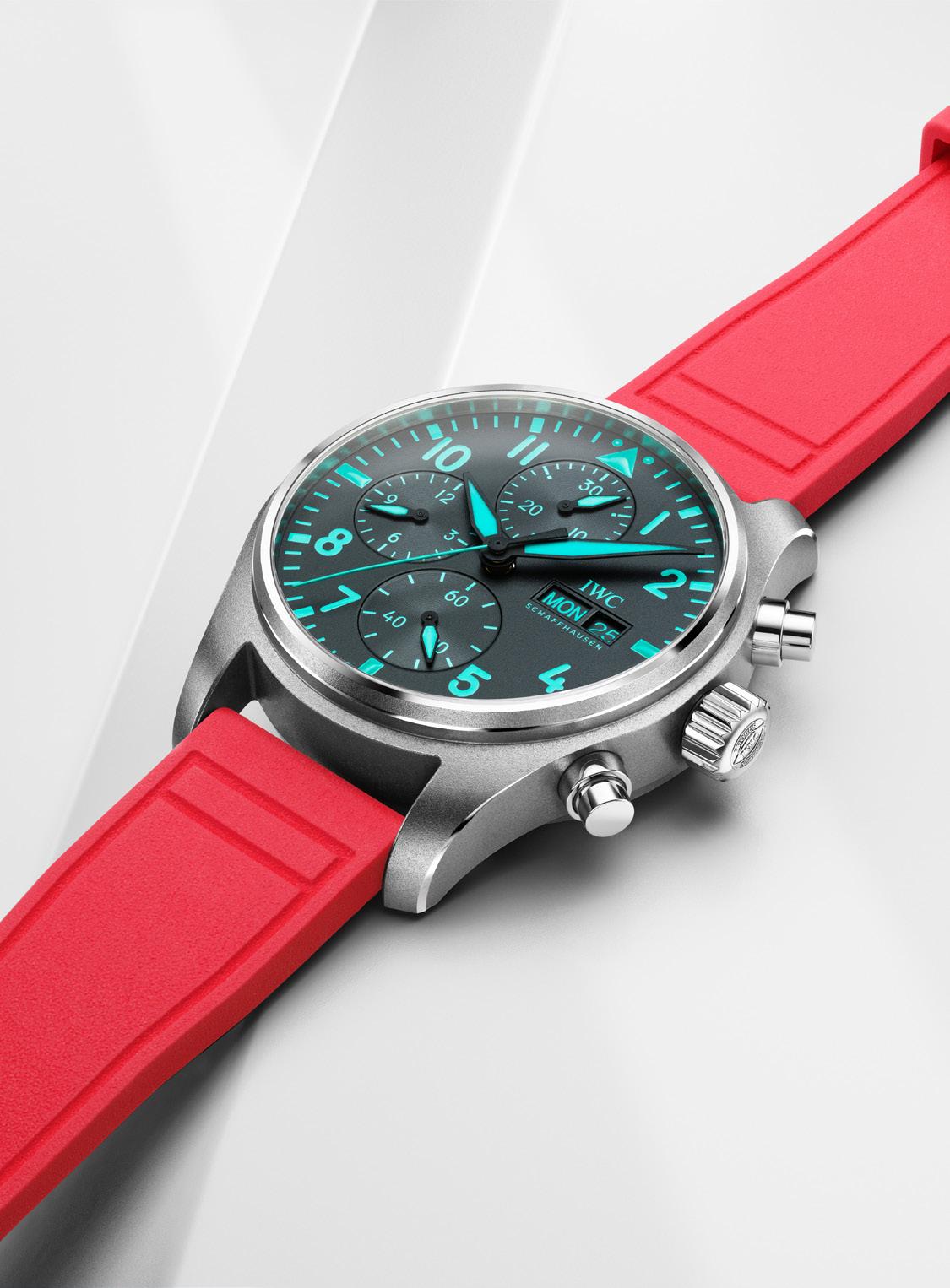
Cartier gives us the jewelry watch par excellence




The story of the Baignoire watch began in 1912 when Louis Cartier took the traditional round watch shape and stretched it out. This culminated in two straight parallel lines closed by two curves, which, not coincidentally, formed the shape of a “baignoire,” which is “bathtub” in French. Its aesthetics would continue
to evolve over the years until finally coming to its familiar slightly curved oval shape with a dial stamped with Roman numerals and bordered by gold gadroons in the late 1950s.
This year, through a new ratio of proportions, the Baignoire has been both miniaturized and amplified with a larger bezel in line with the chunky gold metal trend seen recently in fine jewelry. The gadroon has also been expanded into a bangle, which encircles the delicate dial in gold. Pure and accurate in both line and proportion, the new Baignoire is worn as a piece of jewelry and joins the other Cartier jewelry watches par excellence like the Panthère de Cartier watch.
Lou Doillon, the French-English singer, musician, actress and model, has become the latest face of the French powerhouse and is seen wearing the new Baignoire, which has been entirely reworked to become Cartier’s latest jewelry watch.
“Cartier has been a part of both my family and me for a long time. To celebrate love and special occasions! For my eighteenth birthday, my mother gave me a Baignoire watch. Cartier, the elegance and chic of the sapphire, the sobriety of the dial, the timelessness of the form.” – Lou Doillon
Two models are available upon launch: a 24.6mm “Mini” model and a 31.4mm “Small” model. The former takes its emblematic oval and transforms it into a bangle either in rose, yellow or white gold. And since it was borne of Cartier’s design culture, the mini model can be combined endlessly with other iconic Cartier creations.
The latter, on the other hand, celebrates pure elegance with a lessis-more approach. More watch-like than jewelry, this model takes the yellow gold shine of its bezel to contrast with its black patent leather strap to create a more refined “couture” offering. Both models can be matched with patent leather straps and come in models that are fully encrusted with diamonds. The small model is also available with bracelets in either yellow or white gold.
“As Cartier was a jeweller before being a watchmaker, a Cartier watch blurs the boundaries between these two founding crafts and makes it possible to capture the best of both,” muses Marie-Laure Cérède, creative director of jewellery and watchmaking. “This combination has resulted in the sleek and sophisticated design of the mini Baignoire. The combination of a beaded bracelet with a pure line and a miniature dial without any attributes gives this aesthetic reference to our heritage a sublime touch. The mini Baignoire becomes a piece of jewellery.”
The new Baignoire made its debut at the recently concluded Watches & Wonders 2023, and with fashion and watch enthusiasts alike waxing lyrical about it, expect Cartier’s latest jewelry watch to join the ranks of the French powerhouse’s most popular timepieces.
TUDOR presents a brand new state-of-the-art facility



Completed in 2021 after three years of construction, the brand’s new watch Manufacture located in Le Locle Switzerland is where every TUDOR watch now calls home. As regular Calibre readers probably already know, Le Locle is a Swiss town situated in the Jura Mountains that has become known as the cradle of Swiss watchmaking. With a population of 10,000 the town is known for its watchmaking-typical town planning and together with neighboring town, La Chauxde-Fonds, has been placed on the UNESCO World Heritage list since 2009.
Indeed, Le Locle has grown in leaps and bounds and has successfully made the transition from artisanal production by a cottage industry to the more concentrated factory production of the late 19th and 20th centuries. Representing a remarkable example of a mono-industrial manufacturing town dedicated to watch manufacturing, Le Locle is alive with well preserved, and in some cases, historical factories that are still fully operational today. The new TUDOR Manufacture only adds to this living and breathing town and starts a new chapter in the region’s legacy in watchmaking.
Located next to a Rolex facility, which was inaugurated in 1970, the signature TUDOR red building may have been completed in 2021, but was only officially inaugurated this year in March during the Watches and Wonders 2023. The modern facility spans over four levels totaling 5,500 square meters and, for the first time, is physically connected to the neighboring Kenissi Manufacture, the TUDOR movement facility founded in 2016. This has led to TUDOR fully integrating the development and production of high-performance mechanical calibres and consequently, has fully mastered the manufacturing of strategic components guaranteeing their quality. And since every TUDOR watch is assembled and fully tested to TUDOR’s superior standards in Switzerland, this new facility, ensures the exceptional quality of every TUDOR timepiece.
Decked out in TUDOR red, the façade and windows give the building its signature look with
bright red on the TUDOR Manufacture side and silvery grey on the Kenissi Manufacture side. This ensures visual continuity. Further, the new TUDOR Manufacture uses energy efficient Sage Glass-equipped bay windows, which automatically regulate the amount of light transmission depending on the level of natural light. The system uses light transmission to help regulate energy consumption. In fact, a large part of the power used by the building is generated by solar panels on the roof, with the remaining power coming from the Swiss power grid, which is generated by renewable energy sources.
Best of all, the new facility was designed to be in perfect harmony with its surrounding environment. Careful attention was paid to not upset the flow of the Bied river for example and all patches of grass are only cut once a year around the area. All plants chosen for the property are also endemic to the Jura region so as
to not upset the biodiversity of the area.
The final touch comes with the choice of furniture, which are also colored red, black, and grey just like the outside of the building. The idea was simple: create visual harmony throughout the space by matching the minimalist aesthetics with coherence. This has resulted in visually stunning furniture that is also ergonomically comfortable and safe for all in the workplace.
The TUDOR Manufacture Le Locle represents a new era for the brand. Careful consideration has been given to every single aspect of its design and construction: from the work benches the watchmakers work on, all the way to the plants that grow in the open spaces around the Manufacture, everything is geared for the watchmaker to make the best possible luxury watch at the best possible price. The development of this Manufacture is part of that mission, and will serve TUDOR for years to come.
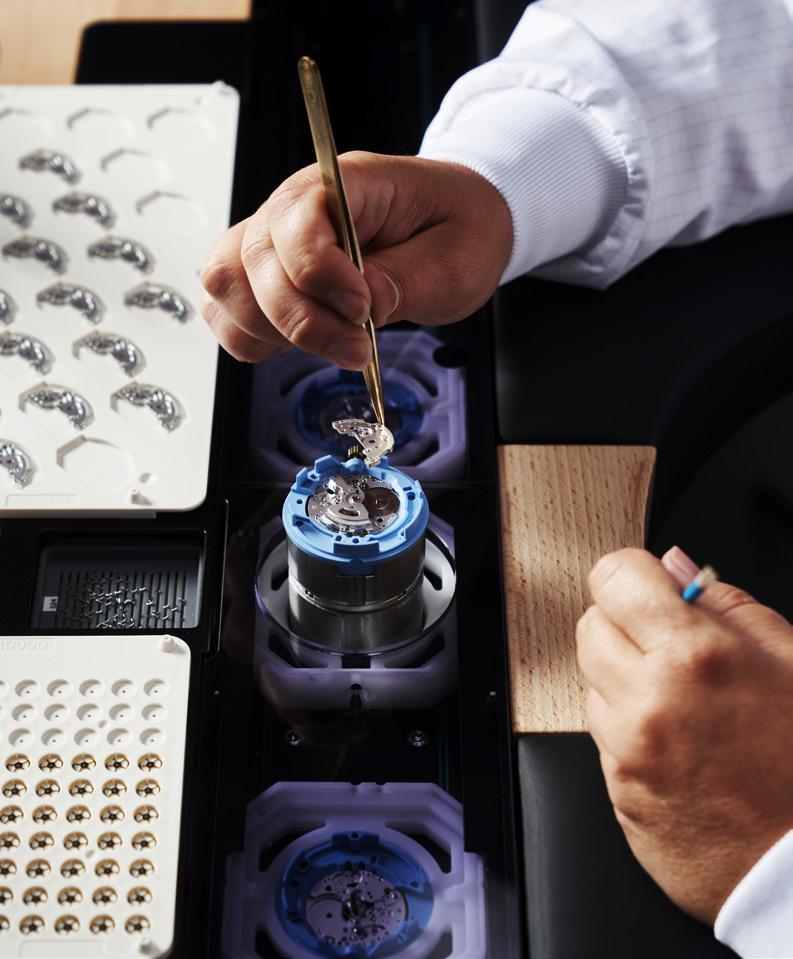

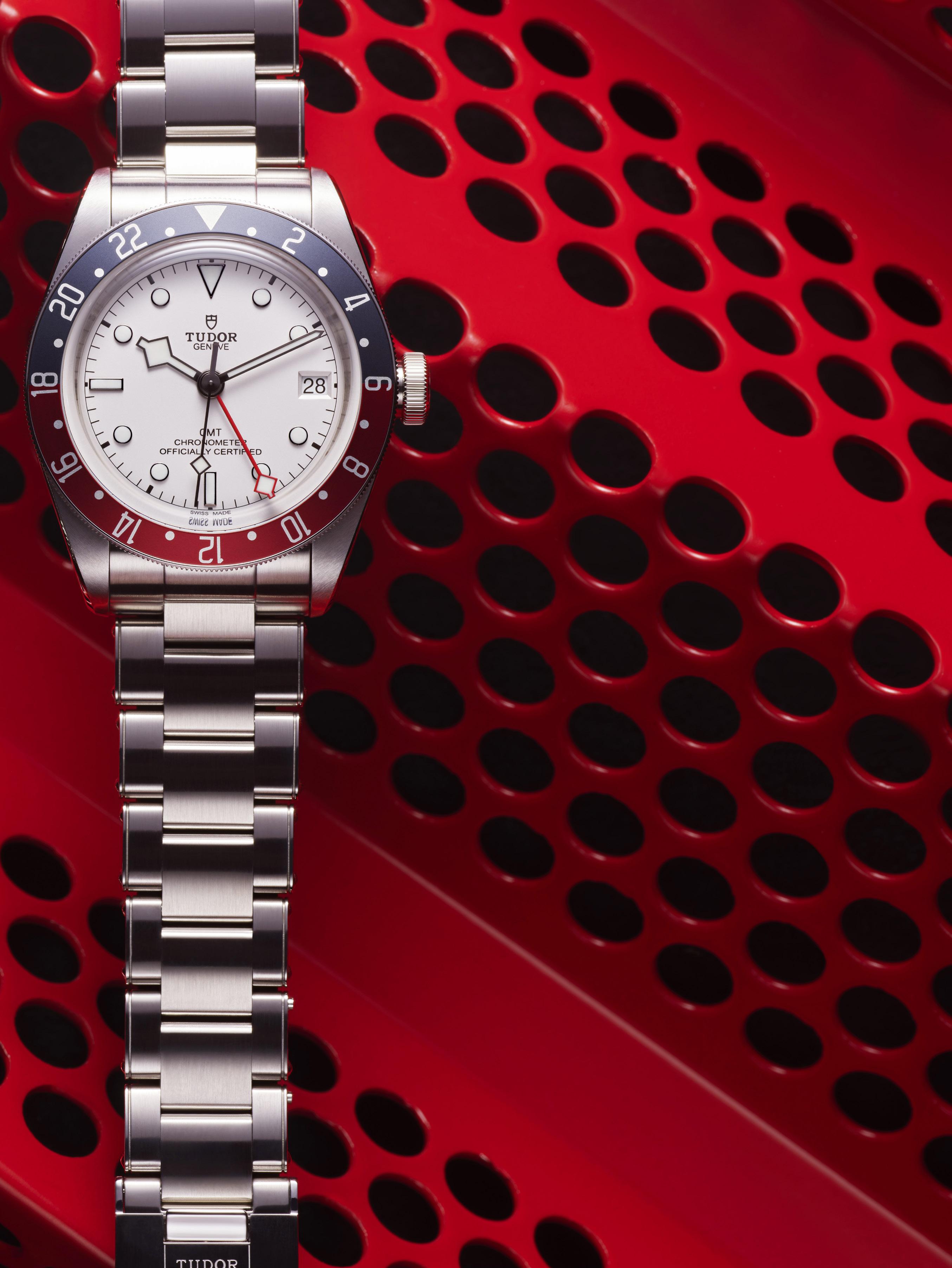
erhaps the most enduring image of 2003’s Catch Me If You Can is Leonardo DiCaprio, dressed as a Pan Am pilot, strolling into an airport flanked by a bevy of pretty stewardesses in pale blue uniforms. This is a dramatization of the exploits of con man Frank Abagnale, visually distilled as only Steven Spielberg can. It is unclear which watch is on Leo’s wrist in that scene, but if it were shot today, then the Tudor Black Bay GMT would be an appropriate choice. Like the great pretender Abagnale sporting counterfeit wings, Tudor has taken on the guise of the Rolex GMT-Master, and usurped its glamour and heritage.
For those who are not well-versed in the history of one of Rolex’s most enduring watches, here is an abridged version: Pan American World Airways was one of the 20th century’s titans of civil aviation, and the de facto national carrier of America. At the dawn of the Jet Age, Pan Am asked Rolex to design a watch for its pilots that could track multiple time zones. The result was the GMT-Master. Unveiled two years before the Boeing 707’s first flight, it evolved over the
Pdecades to become an icon, instantly recognizable thanks to the red/blue bezel that led to the “Pepsi” nickname. However, the lore behind the white-dialed variant is a bit hazier. Pan Am boss Juan Trippe allegedly requested a limited run of distinct GMT-Masters to satisfy executives that leered enviously at their pilots’ wrists. Vintage Rolex collectors are divided on the veracity of this story, and whether any of these albino GMTs (some of which have been scrutinized under microscopes) are genuine.
With its latest Black Bay GMT (Ref. 79830RB-0010) Tudor sidesteps the question of lineage. In the 1950s, Tudor — still very much in the shadow of its big brother Rolex — did not even offer a GMT model, so there is no original that needs to be honored, let alone authenticated. As if by magic, what was once up for debate is transmuted into a whimsical nod toward days gone by. Tudor’s usurper has taken the kernel of another watch’s legend, and creates a new heritage that starts right now. After all, many companies have appropriated the look of the Pepsi GMT. Why not Tudor, which is at least part of the Wilsdorf family? This Black Bay GMT is identical to the version that was released to much fanfare in 2018, save for that white dial. That 2018 GMT was itself a modification of the ubiquitous Black Bay, a tremendously successful model that has come to define Tudor since its introduction in 2012. Since then, Tudor has mined that seam of watch collectors who love vintage Rolex styling, but not contemporary Rolex prices.




Tudor identifies the dial under the domed sapphire crystal as opaline, specifically referring to a milky white appearance. Under direct lights, the gentle shine of its similarly domed surface is evident. Dial markings and text are identical to those on the regular Black Bay GMT, except inverted white-to-black. The hour plots and handset are carried over unmodified. The luminescent material remains an as-new shade of white rather than the yellowed vintage so often employed on retro-inspired pieces. A secondary time zone is indicated by the red snowflake hand, which points to numerals on the bezel framing this executive-class dial. Taken in isolation, Tudor’s red-and-blue aluminum insert forges a stronger visual link to the classic GMT-Masters of the 50s and 60s. Tudor’s execution of the Pepsi bezel is arguably more visually appealing than Rolex’s, thanks to more classic proportions and deep, vivid hues: Denim blue and terracotta red, rather than the murkier tones of the GMTMaster’s ceramic insert.
The 41mm stainless steel case is, unsurprisingly unchanged from the black-dialed GMT, and a familiar shape to fans of the Black Bay range. Save for its sharp, mirror-like bevels, its entire surface is sensibly satin-finished. Even the bracelet eschews the polished mid-links inexplicably found on its Rolex counterpart. An airline executive ought to be able to desk-dive without stress! The darker bezel colors, lack of crown guards, and overall utilitarianism on display gives a stronger family resemblance to the original GMT-Master Ref. 6542 — at least, when viewed directly from above. But if the Black Bay GMT’s head-on dial/bezel ratio is a delicate throwback, then the case/bezel proportions of its profile is something more slab-sided and modern.
At 14.5 mm, it is significantly thicker on the wrist than the current GMT-Master II, at only 12.1 mm, despite its visual bulk. Since its inception, thick flanks have been a common genetic trait of the Black Bay family. While recent models have slimmed down a few millimetres due to updated movements, more complications to the base movement have led to new vertical expansion. It is not as immediately chunky as the 39mm Black Bay Pro, but the GMT can be a bother to cuffs and door frames alike. A trip to the Tudor Boutique for a test drive on the wrist would be prudent. However, an upside of the beefier case is the Black Bay GMT’s 200m depth rating — double that of the Rolex GMT-Master II.

Powering the Black Bay GMT is Tudor Cal. MT5652. This is essentially the same as the in-house MT5621 that was first introduced in 2015, but with the additions of date and GMT complications. It is an automatic movement beating at a smooth 28,800vph, and certified as a chronometer by COSC to a daily accuracy of -2/+4 seconds. A generous 70-hour power reserve means that the watch can go for a very long time
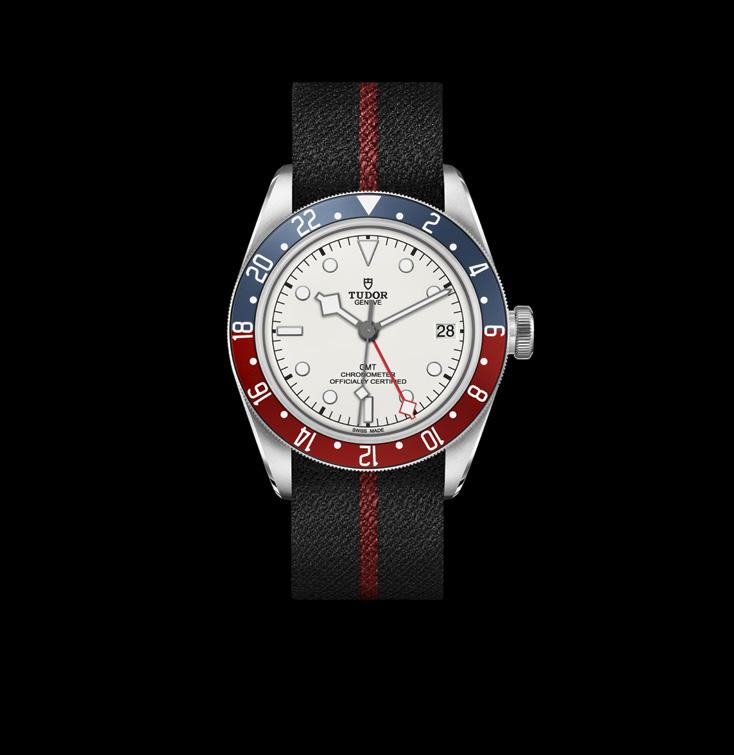
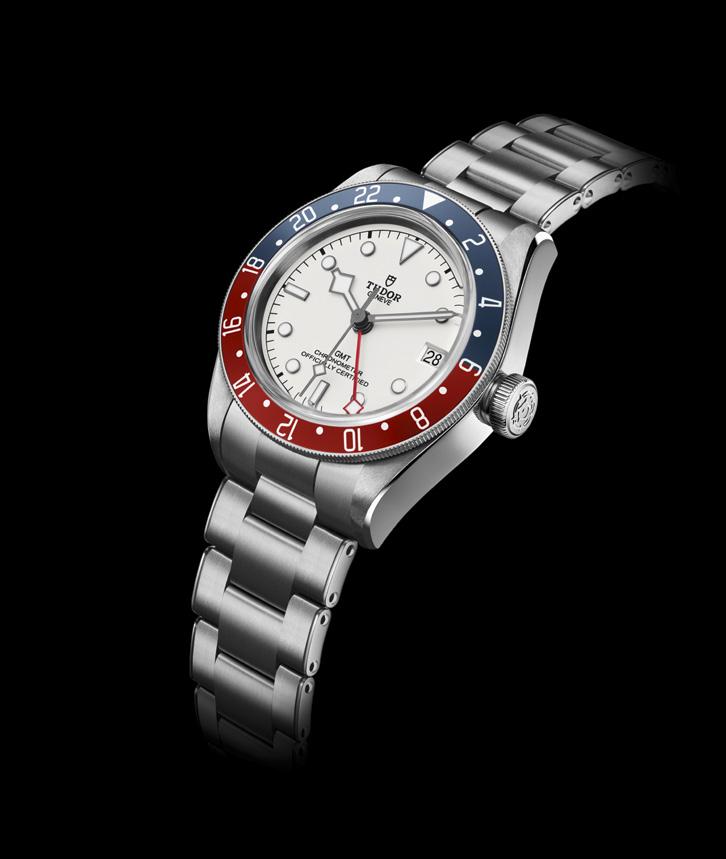
“Tudor continues to mine the seam of watch collectors who love vintage Rolex styling but not vintage Rolex prices.”
before the crown would ever need a winding. It is more likely that the GMT’s owner would touch the crown (bearing the Tudor rose, of course) not to restart a stopped watch, but to adjust the independent hour hand. This hand jumps in discrete increments between hours, ensuring easy transitions from one time zone to the next. With the caseback off, the movement is a triumph of function over form. The view is dominated by the balance bridge holding the silicon hairspring, and a half-moon rotor with cut-outs that are more intended to save weight than please the eye. The finish of the calibre’s plates is a mixture of sandblasted and straight brushed surfaces. Ultimately, all is hidden away by a solid Oyster-like caseback decorated with a thin ring of engraved text and Tudor shields.
As on the black-dialed Black Bay GMT, the primary means of attachment is a three-row, faux-riveted bracelet. It bears a resemblance to the Oyster bands of the 1950s and 1960s, but it is unfortunately much thicker than the originals. The clasp is an effective, simple fold-over design, but lacks the micro-adjustment found

on the Rolex Submariner, or the self-adjustment capability of the Pelagos. The alternative to the steel bracelet is Tudor’s take on the NATO: The Jacquard fabric strap from Julien Faure stands out with a distinctive texture, modern colors (shades of burgundy), and finely-finished metal hardware. Unfortunately, the third strap option — brown leather — has been dropped by Tudor, but the aftermarket will surely provide suitable options.
It bears repeating that this new Black Bay GMT is practically the same watch that was introduced at Baselworld 2018, and the same watch as the black-dialed model that continues to be sold today. They are dial variants, so whatever attracted or repelled on the earlier watch will probably continue to do so on this one. It should also be noted that these Black Bay GMTs sell for less than half the retail price of the very scarce and heavily marked-up Rolex GMT-Master II. Perhaps Frank Abagnale could offer some guidance: If you were stopped at an airport’s security checkpoint, would you say that you’re an airline pilot or an airline executive? Maybe the decision is as easy as black versus white.
“The Black Bay GMT's Pepsi bezel is arguably more visually appealing, thanks to its more classic proportions and deep, vivid hues of denim blue and terracotta red.”
Every issue, we try to bring the timepieces that we've seen at the shows and in different events we've attended both locally and overseas. These are the pieces that have caught our fancy and we hope they catch yours as well.
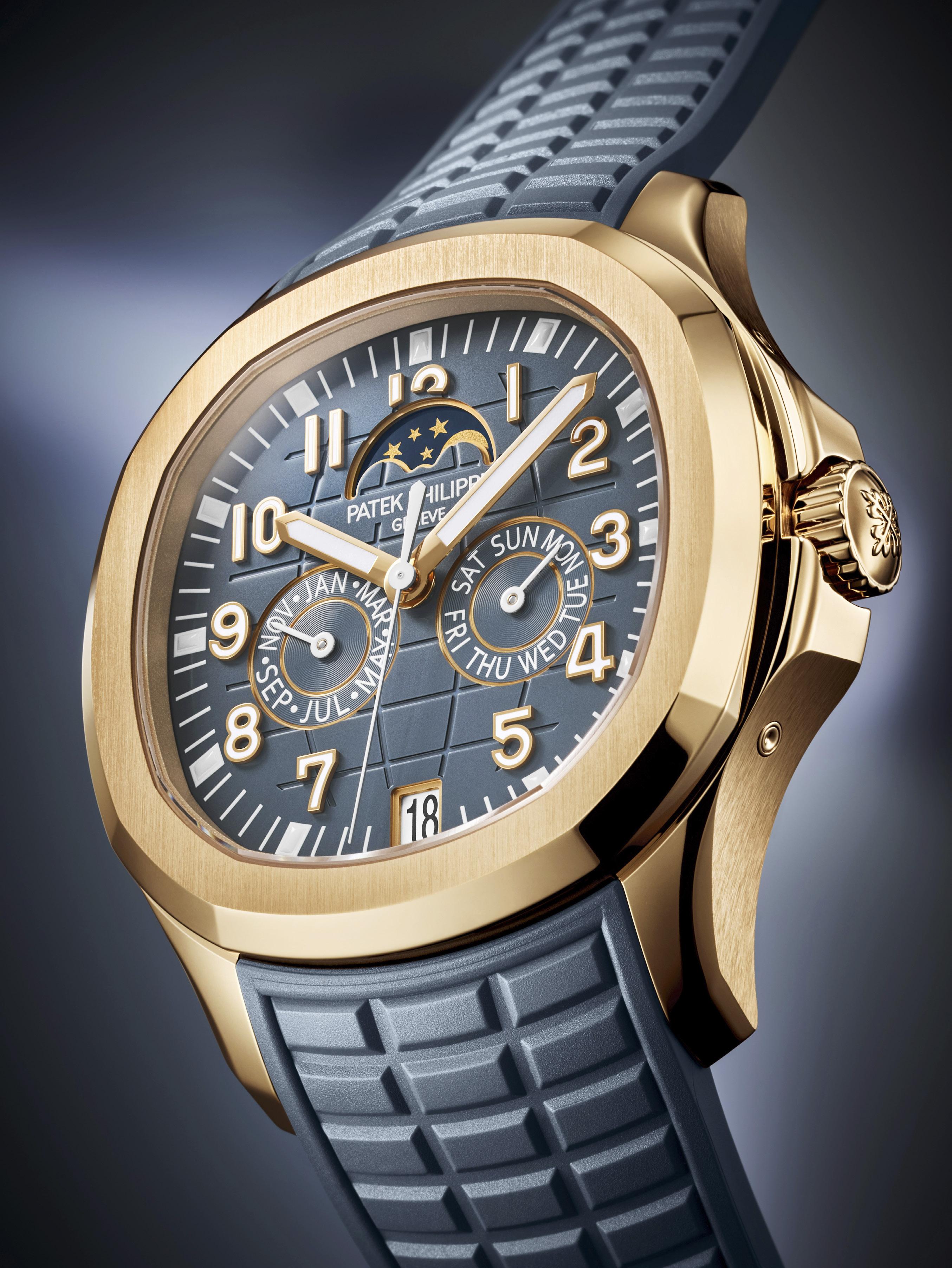
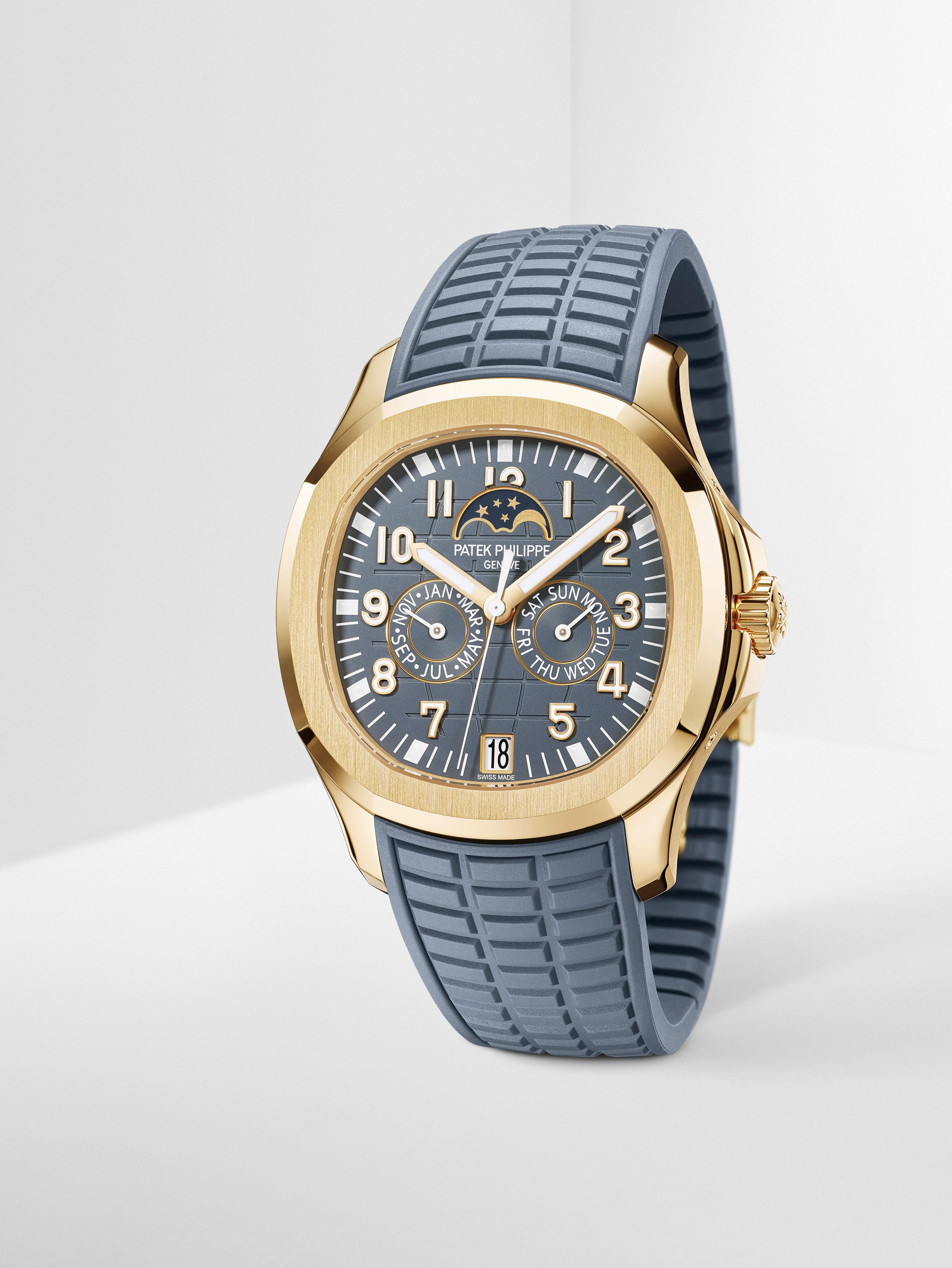

The ladies’ version of Patek Philippe’s popular Aquanaut collection called the Aquanaut Luce made its debut in 2004. Aimed specifically at the more feminine side of society with smaller wrists, the Patek Philippe Aquanaut Luce offers more compact case profiles, a wider variety of color combinations, and a full complement of gem-set references that blurred the line between wristwatches and jewelry.
Fully aware that a number of feminine buyers look for more than just “bedazzled” aesthetics when considering their wristwatches, however, Patek Philippe obliged us with the one-two punch of two advanced models that featured useful and easy-to-use complications useful in everyday life.
The first was the Ref. 5269/200R-001 Aquanaut Luce Travel Time, a very convenient and elegant ladies’ travel watch with an innovative quartz movement, while the second was the Ref. 7968/300R-001 Aquanaut Luce “Rainbow” Chronograph, the first chronograph model within the ladies’ collection equipped with the selfwinding caliber CH 28-520, which the watchmaker debuted in 2021 and 2022, respectively.
And while these watches didn’t stray from the collection’s well-worn gem-set aesthetic the watchmaker is still dead set on reinforcing
its “modern casual chic” segment with various complications that are useful in everyday life, which is why the watchmaker is giving the Aquanaut Luce another upgrade for 2023 with another convenient and easy-to-use complication. And may we say its all the better for it.
Another first for the collection, the Aquanaut Luce Annual Calendar Reference 5261R-001 benefits from (you guessed it) the watchmaker’s patented Annual Calendar complication, and it not only brings the brand’s advanced calendar complication to the feminine side of the Aquanaut collection, it is also the first model in the collection that (thankfully) resists the urge to include any diamonds or gemstones on its façade. This makes the Aquanaut Luce Annual Calendar a rare unisex release.
Indeed, there is nothing overtly indicative of this being a specifically ladies watch. Nothing from its 39.9mm in diameter by 10.94mm thick case crafted from 18K rose gold, and certainly not from its iconic Aquanaut design with its rounded octagonal shape enhanced by contrasting polished and satin finishes. The absence of any diamond or gemstone anywhere on the watch only reinforces this theory.
Typical of a Patek Philippe calendar watch, a series of small push buttons sit flush on the flanks of the case and are used to set the various displays of the movement’s calendar functions. Alas, this
reveals the Aquanaut Luce Annual Calendar main Achilles heel: only 30 meters of water-resistance, which is only good for the occasional splashing and unavoidable moisture contact that comes with daily use. Do NOT go swimming with this watch.
The Aquanaut Luce Annual Calendar features a dial with the collection’s signature embossed Aquanaut pattern, the “casual chic” style of which is reinforced by an elegant blue-gray color that is mimicked by its equally embossed rubber strap. This integrated composite strap with the Aquanaut pattern echoing that of the dial is fitted with a patented Patek Philippe fold-over clasp secured by four independent catches and stands out for its optimal comfort as well as its high resistance to traction, wear, salt water and ultraviolet rays.
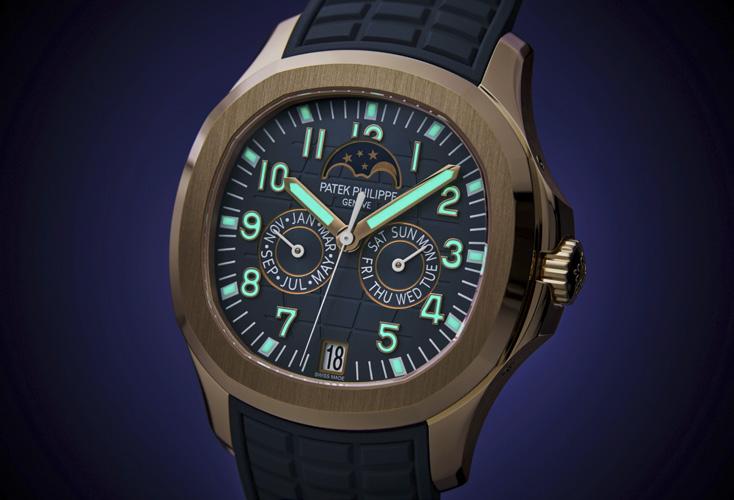
Best of all, this already distinctive dial is not only enhanced by bold, applied 18K rose gold Arabic numerals and baton-style hands, a minute track, and a seconds hand constructed from Pfinodal (an alloy made from copper, nickel and tin), all of which are swathed in white luminescent coating ensuring excellent legibility, but this is also where the watchmakers chose to create something distinctive for the Aquanaut Luce Annual Calendar
Powering the new Aquanaut Luce Annual Calendar Reference 5261R-001 is the new inhouse Calibre 266-330 S QA LU self-winding movement that features an interesting “twist” to its movement architecture. An “inversely” installed Annual Calendar module has translated into an asymmetrical dial display and finds the
two calendar registers sitting below the center line with the day display at 3:30, the month display at 8:30. Further, the moon phase with its moon in powdered gold and star inlay sits above the central hands cutting off the lower part of the 12 o’clock marker, instead of the 6 o’clock position where it normally sits with the rectangular date window.
The Patek Philippe Calibre 266-330 S QA is based on the caliber 26-330, which was introduced in 2019 in the Calatrava Weekly Calendar Ref. 5212A-001. And aside from boasting a complete day, date and month calendar that requires only one manual correction at the end of every February, and an extremely precise moon phase indication that only deviates one day from the lunar cycle in 122 years, it features several other technical innovations regarding performance and dependability. This includes a patented anti-backlash wheel to prevent the seconds hand from vibrating, as well as a patented clutch wheel that improves the efficiency and longevity of the self-winding function. The incorporation of a “stop seconds” function, which instantly stops the balance when the crown is pulled out, allows time adjustment to the nearest second.


Consisting of 319 components, the 34-jewel self-winding movement runs at a frequency of 28,800vph (4 Hz), which translates to a power reserve of up to 45 hours when fully wound. In addition to featuring a Gyromax balance wheel with a Silinvar hairspring (which is Patek Philippe’s proprietary silicon alloy), the Patek Philippe Cal. 26-330 S QA LU annual calendar movement is also fitted with a centrally mounted oscillating weight that is crafted from solid 21k gold and signed with the Patek Philippe seal.
As we’ve mentioned before, this is an Aquanaut Luce model not bedazzled with a gem-set bezel or with diamonds anywhere else on the case. This has not only resulted in a unisex model in a size, style and color way that men will also be interested in, but the absence of gemstones has also guaranteed a lower price point with the Aquanaut Luce Annual Calendar Reference 5261R-001 coming in at a fraction of the cost of the previous gem-encrusted Aquanaut Luce “Rainbow” Chronograph. A win-win proposition as far as we’re concerned.
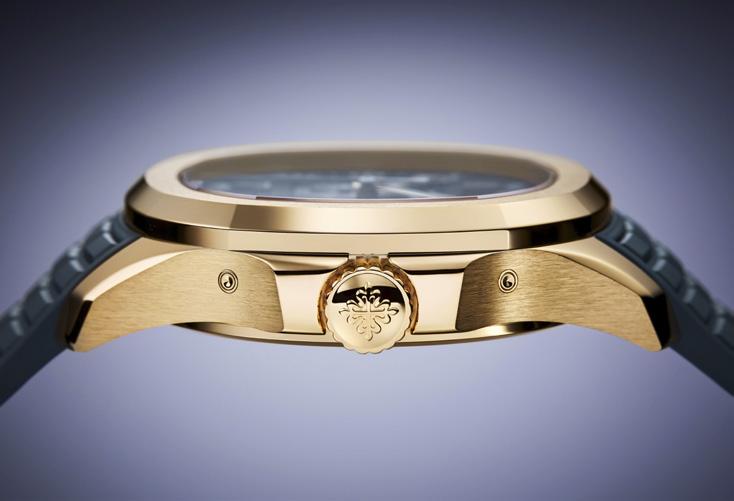
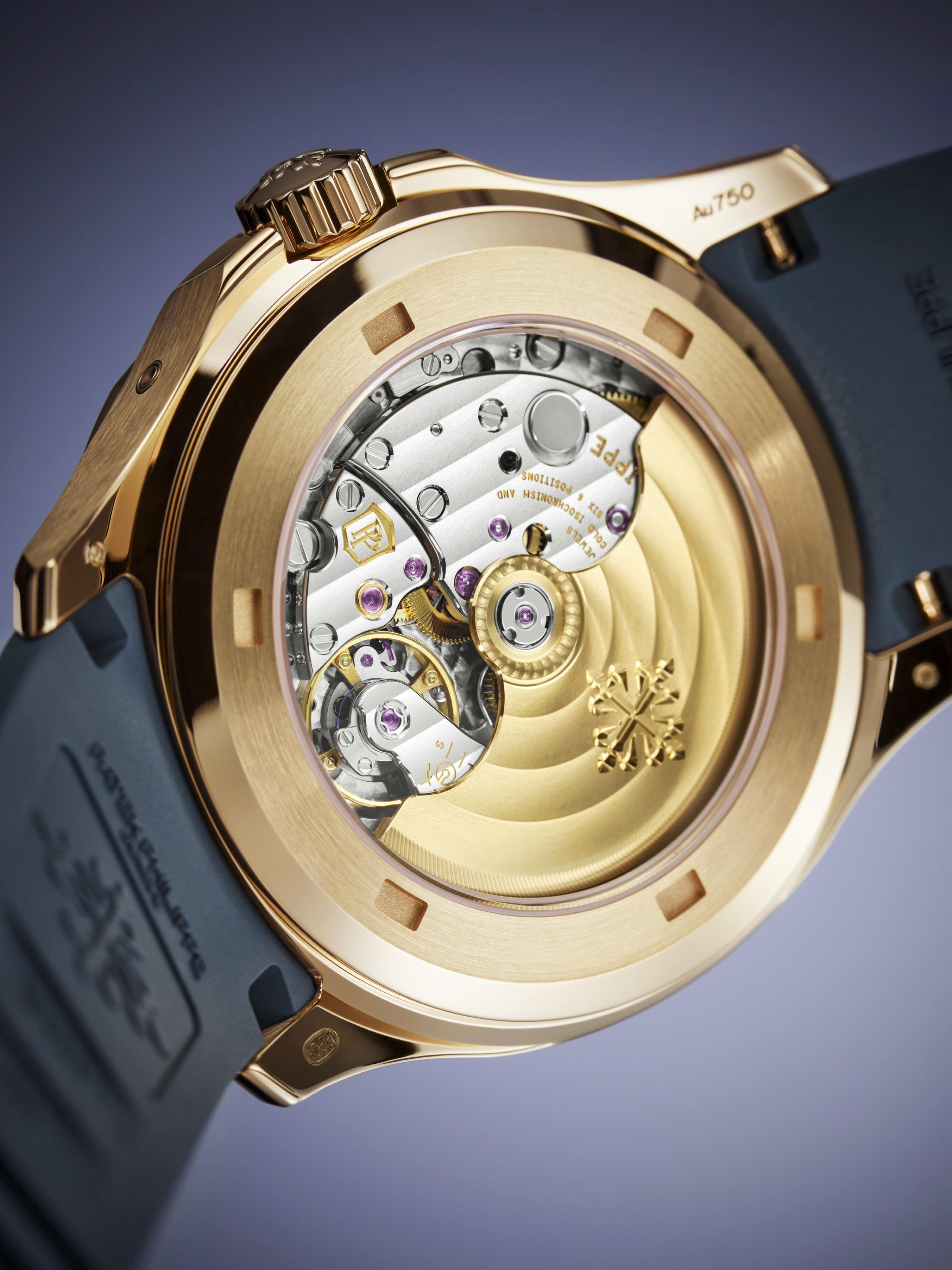
Words by Kit Payumo

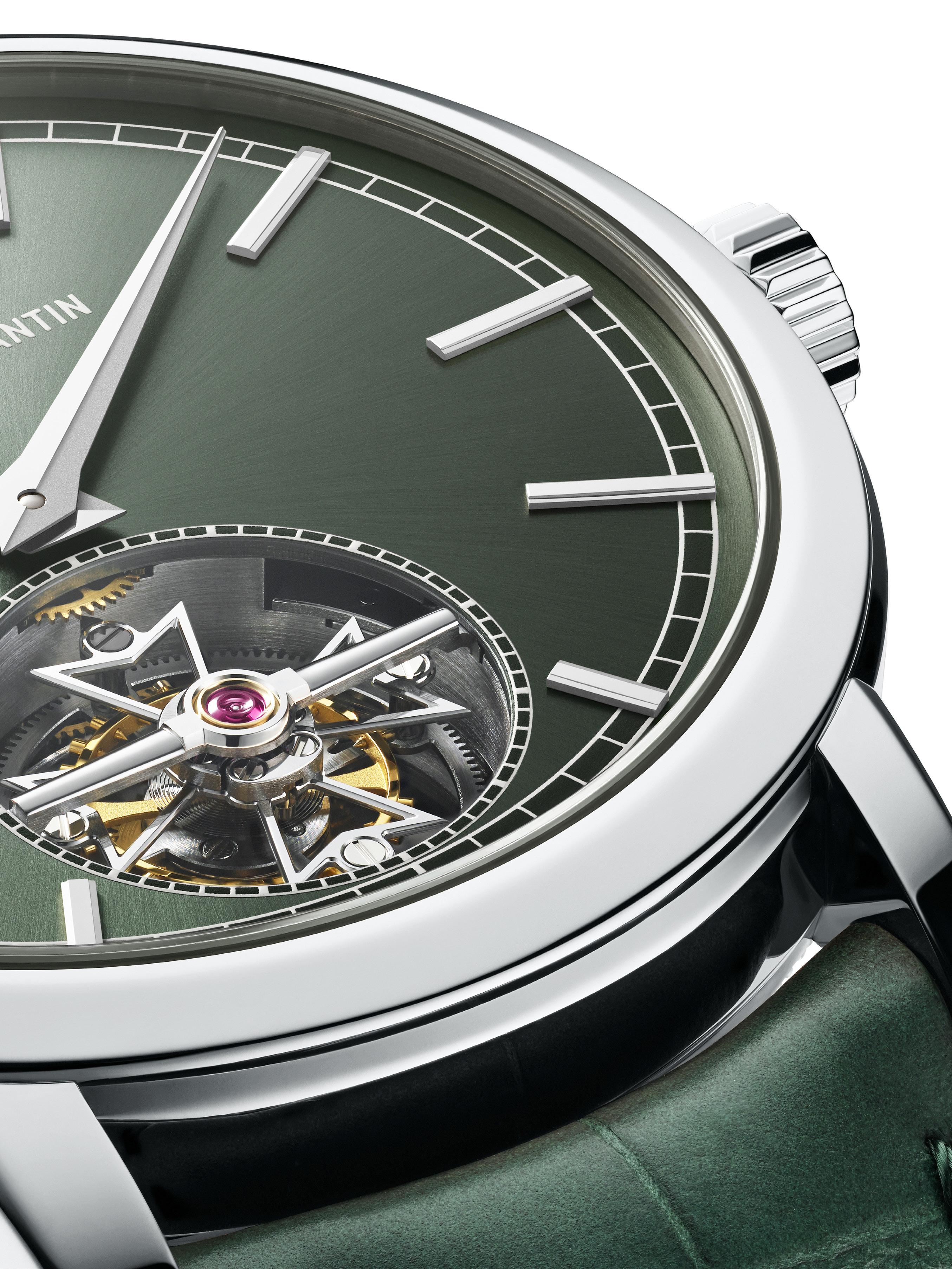
There are only a handful of watchmakers that can handle the oftenprecarious balancing act of melding classic design with contemporary elegance. Fortunately, Vacheron Constantin is one of those watchmakers. As many Calibre readers already know, the grandfather of all watchmakers in existence today is the world’s oldest watch Manufacture that has been in continuous production for nearly 270 years. That’s right, founded in 1755 Vacheron Constantin has faithfully perpetuated a proud heritage of watchmaking excellence and singular sophistication through generations of master craftsmen and decades of earned experience. And one of the direct results of that experience is the aptly named Traditionnelle collection.
“The Traditionelle collection embodies the full measure of Vacheron Constantin’s watchmaking legitimacy. It convey both history and tradition through precise stylistic codes corresponding to an aesthetic that remains timeless however complex the mechanisms.” — Christian Selmoni, Director of Style and Heritage at Vacheron Constantin.
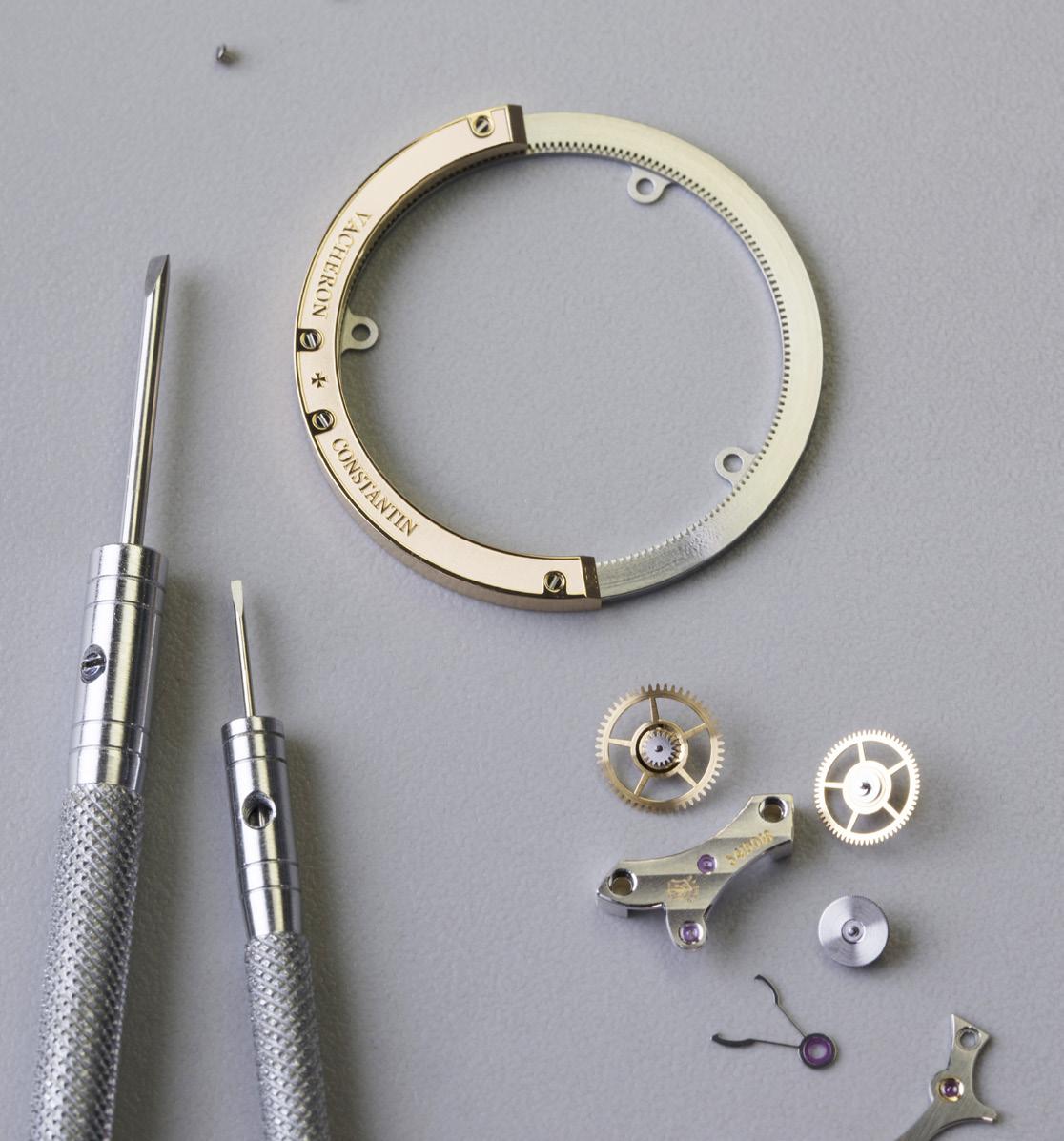
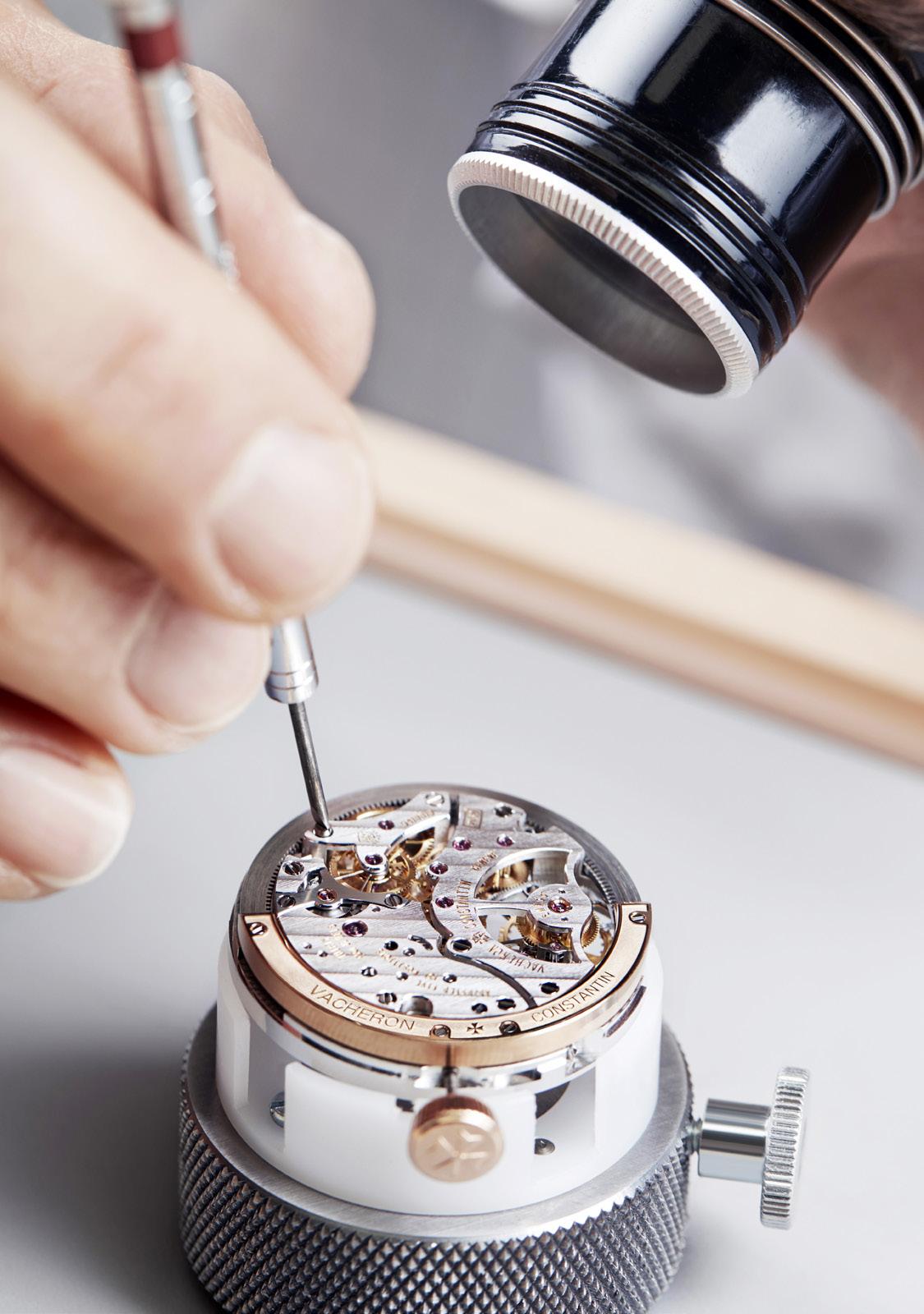
Once again throwing its hat into the green-dialring, Vacheron Constantin presented their latest surprise at the Watches & Wonders trade show this year: a wonderfully contemporary take on a very classic design, the new Traditionelle Tourbillon with a particularly luminous sunburst green dial, the color of which was obtained by galvanic treatment and is not only a natural complement to its 41mm 950 platinum case, but its intense evergreen depths also add a shimmering white hue to the noble metal. This contrast is further complemented by white gold baton-type hour
markers and Dauphine-style hands, while an alligator-leather strap in the same dial color adds the perfect finishing touch.
“With this new dial color,” Selmoni continued, “Vacheron Constantin is pursuing its contemporary vision of the classical approach to design.”

To be fair, however, we’ve seen this green dial before. That was back in 2021 with the Manufacture’s Jade-colored Traditionelle Tourbillon China Limited Edition, a model made exclusively for the Chinese market that is aesthetically identical to this latest Traditionnelle albeit housed in a 41mm pink gold case. This year, the symbolic color that the Manufacture once used to echo the culture of China, is once again applied to the latest Traditionnelle Tourbillon, albeit this time to add contemporary resonance to classic overtures.
That classicism is inherently presented in the slenderness of the case, which in itself is a
reflection of Manufacture’s masterful watchmaking skills. Indeed, the ultra-thin self-winding inhouse Calibre 2160/1 comes in at only 5.65mm thick, despite the fact that a tourbillon regulator, designed to compensate for the effects of gravity on the isochronism of the balance spring, has been engineered directly into the movement.
Beating at a leisurely but steady pace, the regulator has been set to a frequency of 18,000 vibrations per hour, or a very traditional 2.5Hz. This relatively slow tempo is often found in historical pocket watch movements, and was the selected oscillation here to visually appreciate the tourbillon’s mechanical ballet via the sapphire crystal caseback, the spectacle of which is further enhanced by the dance of a 22K gold peripheral rotor, the architecture of which not only allows for a thinner calibre, but also guarantees a healthy 80-hour power reserve.
Naturally, the finishing of the movement echoes the luminosity of the case and dial with a circular-grained baseplate appearing on the dial side and hand-bevelled bridges adorned with Côtes de Genève on the caseback. The tourbillon, with its Maltese cross-shaped carriage bearing the small seconds indicated by a blackened screw, demonstrates the same attention to detail. Its suspension bar has been delicately polished in an entirely handcrafted operation consisting of filing and then polishing the material to obtain a conical and semi-cylindrical shape.
With its sunburst green dial and alligator leather strap in the same color, the new Traditionnelle Tourbillon in 950 platinum is the modern face of classic design, and enhanced by a traditionally designed and executed ultra-thin mechanical movement the ensemble represents the best of the traditional made for our modern age.
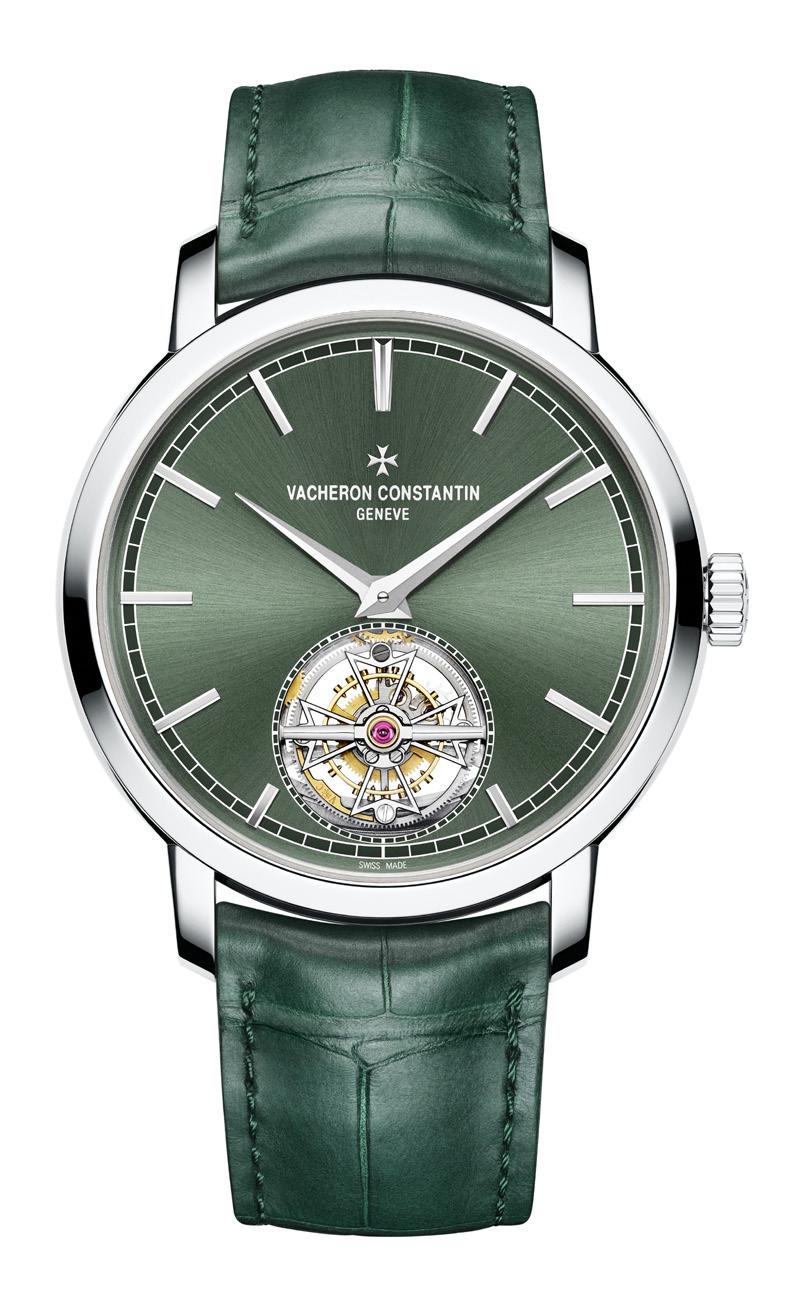
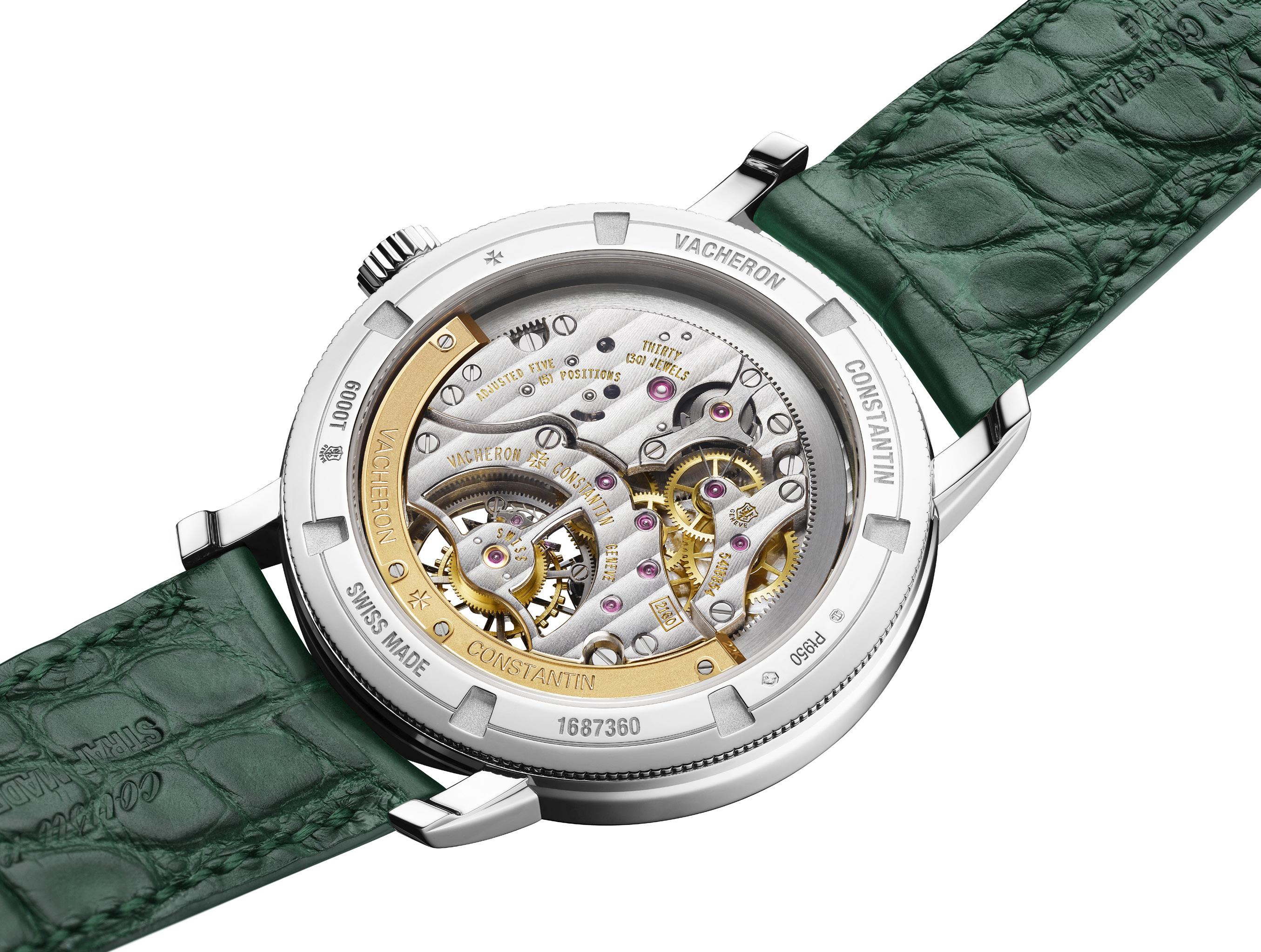

Inspired by the Arthurian legend since 2005, Roger Dubuis’ flagship Excalibur collection was enhanced by a new-and-improved self-winding calibre at Watches & Wonders last year. Called the Excalibur Monobalancier, the new watch is supposedly the last word in the evolution of the line and, aesthetically speaking, is a relatively “simple” watch by Roger Dubuis’ Hyper Horological standards with a completely monochromatic appearance.
Typical of the Manufacture, however, the Excalibur Monobalancier was still engineered to push the horological boundaries that Roger Dubuis oh, so loves to push against. This meant the debut of the new self-winding, microrotor RD 720SQ calibre, a new movement that featured the Hyper Horologist’s signature skeleton dial and trademark star-shaped bridge.
Endowed with a 72-hour power reserve courtesy of a pink-gold and tungsten micro-rotor optimized to reduce the effect of shocks and vibrations, calibre RD 720SQ operates at 28,800 Vph and features double the balance wheel inertia to improve the stability of the movement. A newly designed escape wheel is also on hand and is made more efficient not only with the use of diamondcoated silicon, but also by the introduction of a new lubrication material. Updated diamondcoated silicon pallet stones that can be easily adjusted is also part of the equation.
At launch, the Excalibur Monobalancier (MB) featured an updated 42mm case with the collection’s signature notched fluted bezel. It was made available in two models, both of which were forged in the Manufacture’s patented EON GOLD alloy, an improved type of 5N gold that is “more resistant to tarnishing when exposed to extreme conditions” and matched with embossed calfskin leather straps. This year, the Excalibur MB is back albeit this time in the featherweight division by being made of lightweight titanium.
33% lighter than stainless steel, and legendary for its strength-to-weight ratio, the space-age metal boasts many innate benefits including its naturally pliant and hypoallergenic nature, its high anti-corrosion qualities, and its antimagnetic properties. Skin-friendly, durable, and oh-so lightweight, titanium was seemingly created not only for today’s fast pace of living, but also for Roger Dubuis’ brand of Hyper Horology.
On the Excalibur MB, the titanium has a matte metallic sheen that translates to a monochromatic warm grey, a sheen continued through to the flange, movement finishing, and on the timepiece’s bracelet, which is also crafted in titanium. Indeed, the Roger Dubuis watchmakers continue to display their technical mastery of materials by crafting not only the Maison’s complex and aggressive signature bezel and case in the inherently soft Grade 5 titanium, but also the highly technical bracelet.
Modern and edgy, the matte and brushed bracelet is complemented by shiny polished

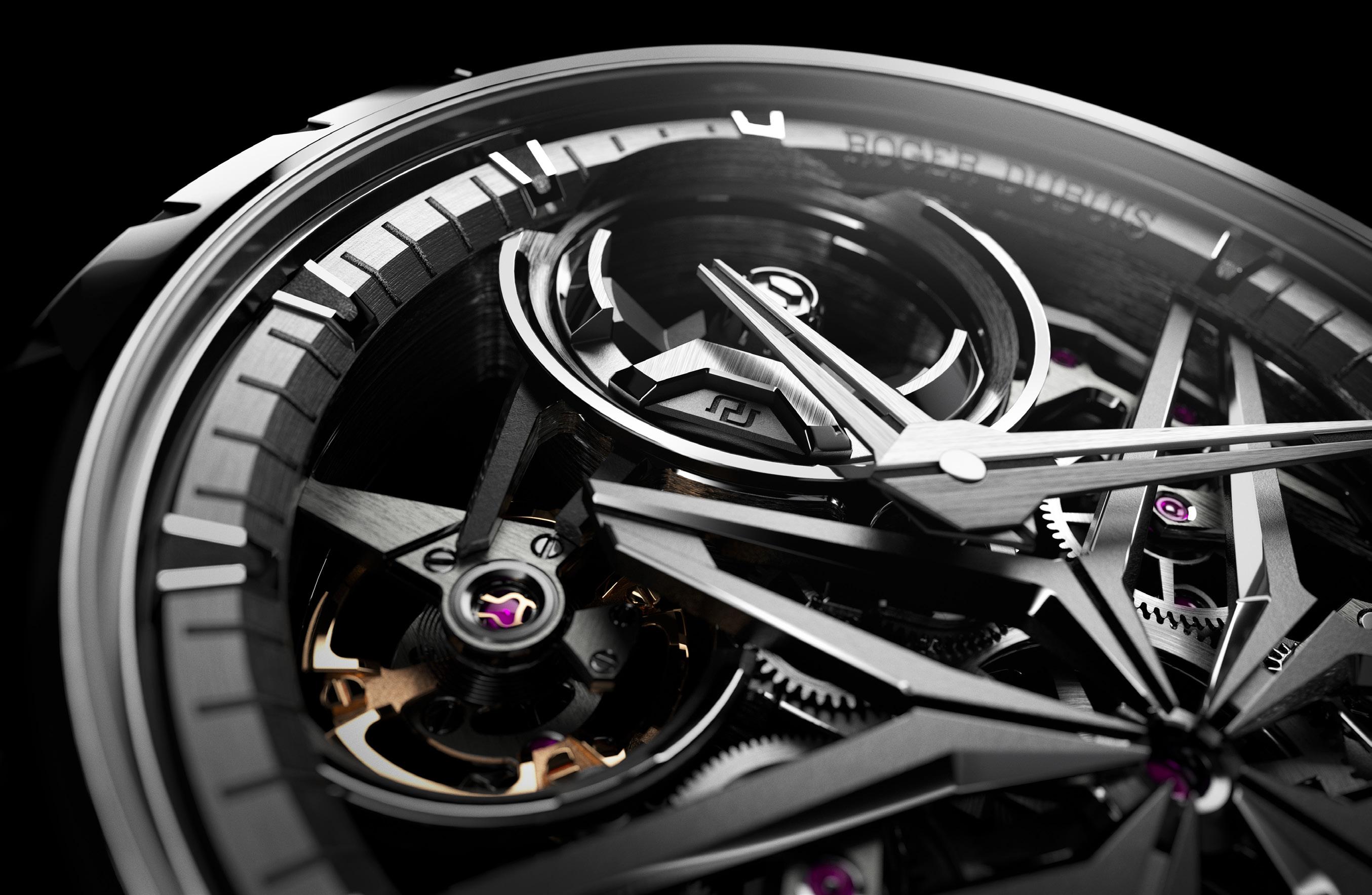
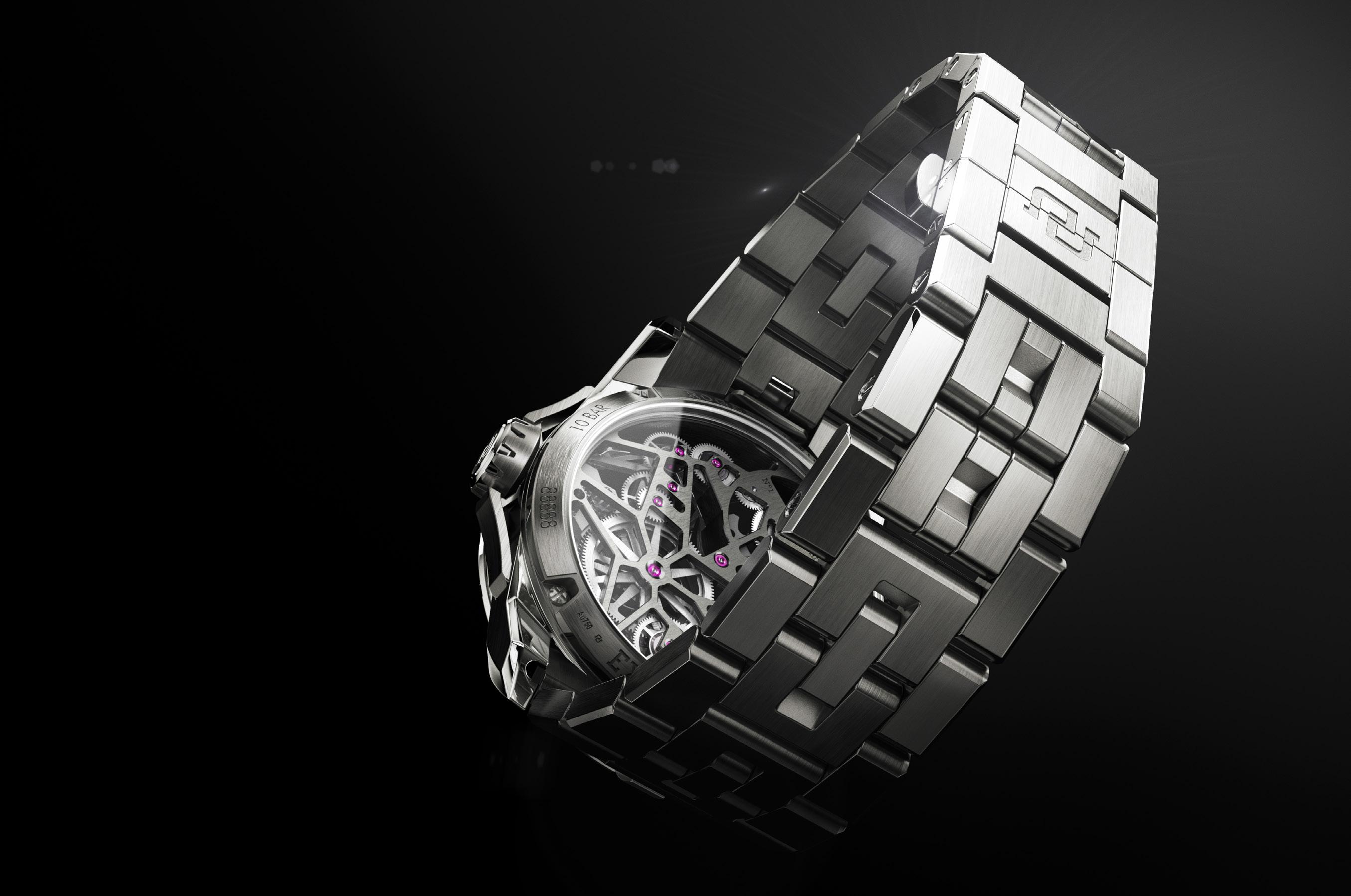
“This year, the Excalibur Monobalancier is back albeit this time in the featherweight division by being made of lightweight titanium.”
bevels, the crisp contrast of which only propagates the technical prowess of the watchmakers. Attention to detail is pushed further with the case’s central lug featured on the bracelet links to push even more harmonious aesthetics.


As before, the 178-component and 32 jewel RD 720SQ movement is the epitome of the brand’s singular approach to skeletonization with every single component finished by hand. Best of all, instead of skeletonizing a pre-existing movement as most other watchmakers are wont to do, the Roger Dubuis watchmakers engineer their calibres already skeletonized and crafts and carves all the components before assembling them.
The depths achieved by the skeletonized dial, then, is almost sci-fi-like in its three-dimensional nature with the signature five-armed star all but exploding from the jewel of the mainspring barrel on the right side of the dial, here coated in NAC to match the all-grey color scheme. The partially skeletonized hands made from satin-brushed white gold also add to the effect, as does the flange that echoes the notched triangular indentations of the bezel; and the grey triangular-shaped hour markers swathed in Super-LumiNova; even the brand name and the words “Swiss Made” are fully lumed; all of which conspire to propagate the saber-like design language of the Roger Dubuis Excalibur. The most distinct movement element on the Monobalancier, however, must be the block-like mini-rotor at 10 o’clock. Designed to minimize vibrations, its highly technical and futuristic aesthetic sets it apart from other, more “mundane” rotors and adds the finishing touch to the RD 720SQ calibre.
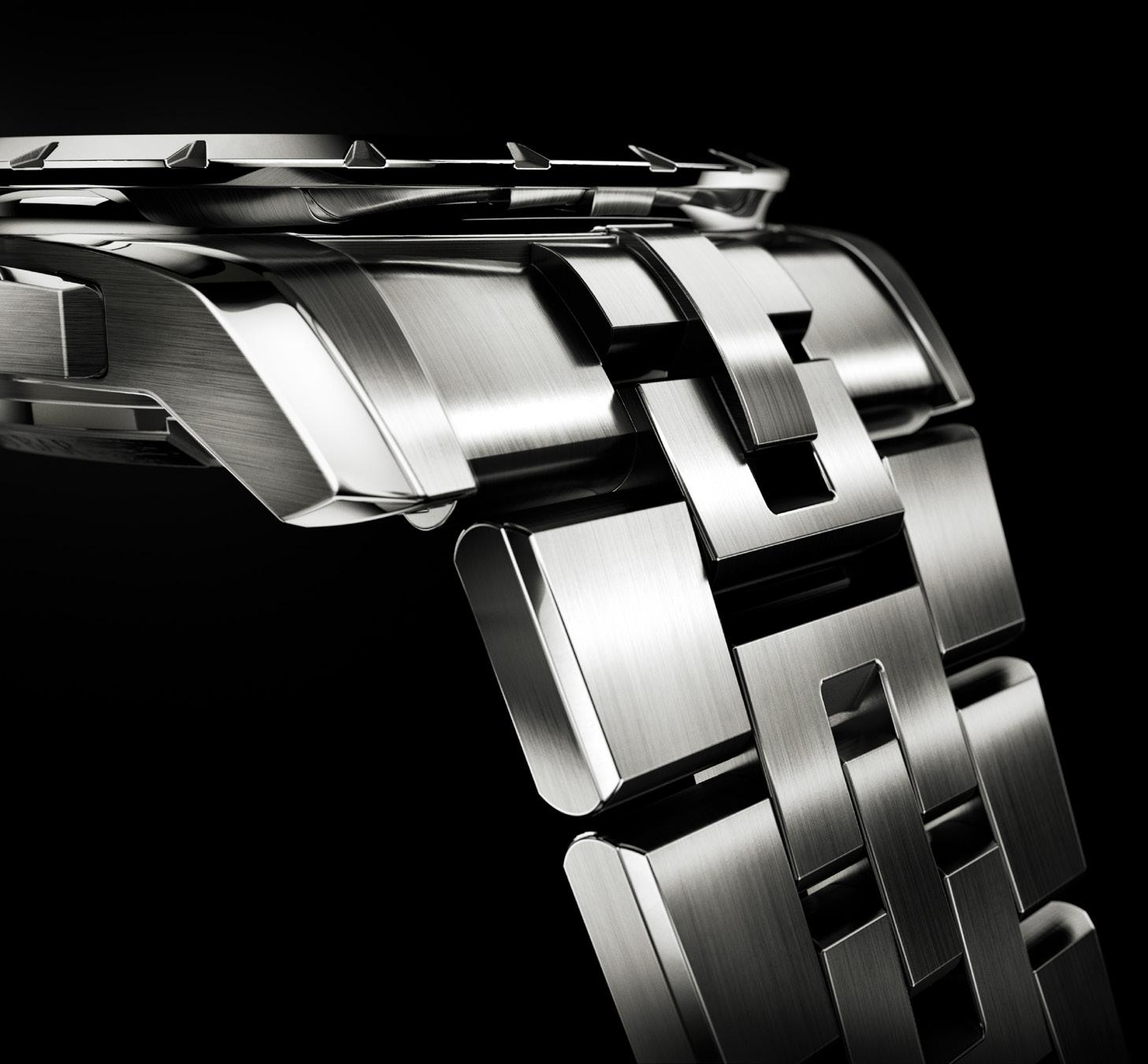

Just like every other Roger Dubuis timepiece, the Excalibur Monobalancier Titanium is certified with the Poinçon de Genève, or Geneva Seal, one of the most prestigious certifications in watchmaking. This makes the Manufacture part of a very exclusive club of watch brands that regularly release watches with the certification including Vacheron Constantin, Chopard, Cartier and Louis Vuitton.
Indeed, every element of the timepiece is meticulously designed, engineered, and handfinished with utmost care. And exceptionally light and comfortable, the Excalibur MB Titanium represents a new benchmark for the Manufacture by offering something new for those who may have previously been put off by the Manufacture’s brand of wild and overt Hyper Horology: a relatively relatable and approachable Roger Dubuis timepiece. Something strange and new for the certified Hyper Horologist.

When you buy your first Rolex watch and wear it for the very first time, excitement pours out the moment you snap that buckle shut. When you turn your wrist and look at that dial on your wrist, a rush of emotions tingle in your mind, from joy to pride, from satisfaction to contentment, from a sense of accomplishment to the longing for the next one.
But the emotions do not end there. They continue to come up throughout the day under different circumstances. One of which arises when someone asks you for the time of day. Or when the person you’re talking to tries to steal a glance at your wrist. And best of all, when someone asks to take a look at your watch.
Rolex has brought so many emotions to its owners in so many different situations, feelings that make their day a little brighter, putting the littlest of smiles (whether visible or not) every time they look at that dial. If you ask me, I believe that owners of a Rolex watch want to keep experiencing these feelings, which produces thoughts and plans for purchasing another one.
This year, Rolex released a new and unexpected creative twist to one of its iconic models. Utilizing all the emotions that Rolex owners feel, they decided to display emotions right on the dial of one of their most iconic models. Presenting the new Oyster Perpetual Day-Date 36.
The first thing that will catch your eye on this new Oyster Perpetual Day-Date 36 is the dial. Its motif is inspired by a jigsaw puzzle where each of the pieces carry different colors; turquoise blue,
red, fuchsia, orange, green, and yellow. These colors sit on a single-color background. The new model keeps with tradition by displaying the day of the week at an arched window at 12 o’clock and the date at an aperture at 3 o’clock. But here’s the twist: instead of displaying the days of the week, Rolex printed seven inspirational key words to brighten your day even more. These inspirational words are Happy, Eternity, Gratitude, Peace, Faith, Love, and Hope. In place of numbers on the date window, 31 exclusive emojis appear to give you that extra bounce in your step.
The Oyster Perpetual Day-Date is the perfect platform to execute this concept. And the reason dates back to 1956. It was on that year that Rolex first launched the Day-Date model. It was a major innovation because it was the first calendar wristwatch to indicate the day of the week fully spelled out in an arc-shaped window at 12 o’clock - a technical feat at the time. The watch was available in a choice of 26 languages. And to make it even more luxurious, the Day-Date range was made only of precious metal — 18 ct yellow, white or Everose gold, or 950 platinum. It was accompanied by a three-piece link bracelet made only from 18 ct gold or 950 platinum with an elegantly concealed folding Crownclasp, which was later named as the President’s bracelet.
The new Oyster Perpetual Day-Date 36 comes in three versions. One version is crafted from 18 ct yellow gold. This piece has a turquoise blue dial as a background to the colorful puzzle pieces. The other version is made from white gold and is also adorned with the same turquoise blue background. The third iteration is cast in 18 ct Everose gold with an orange dial background.
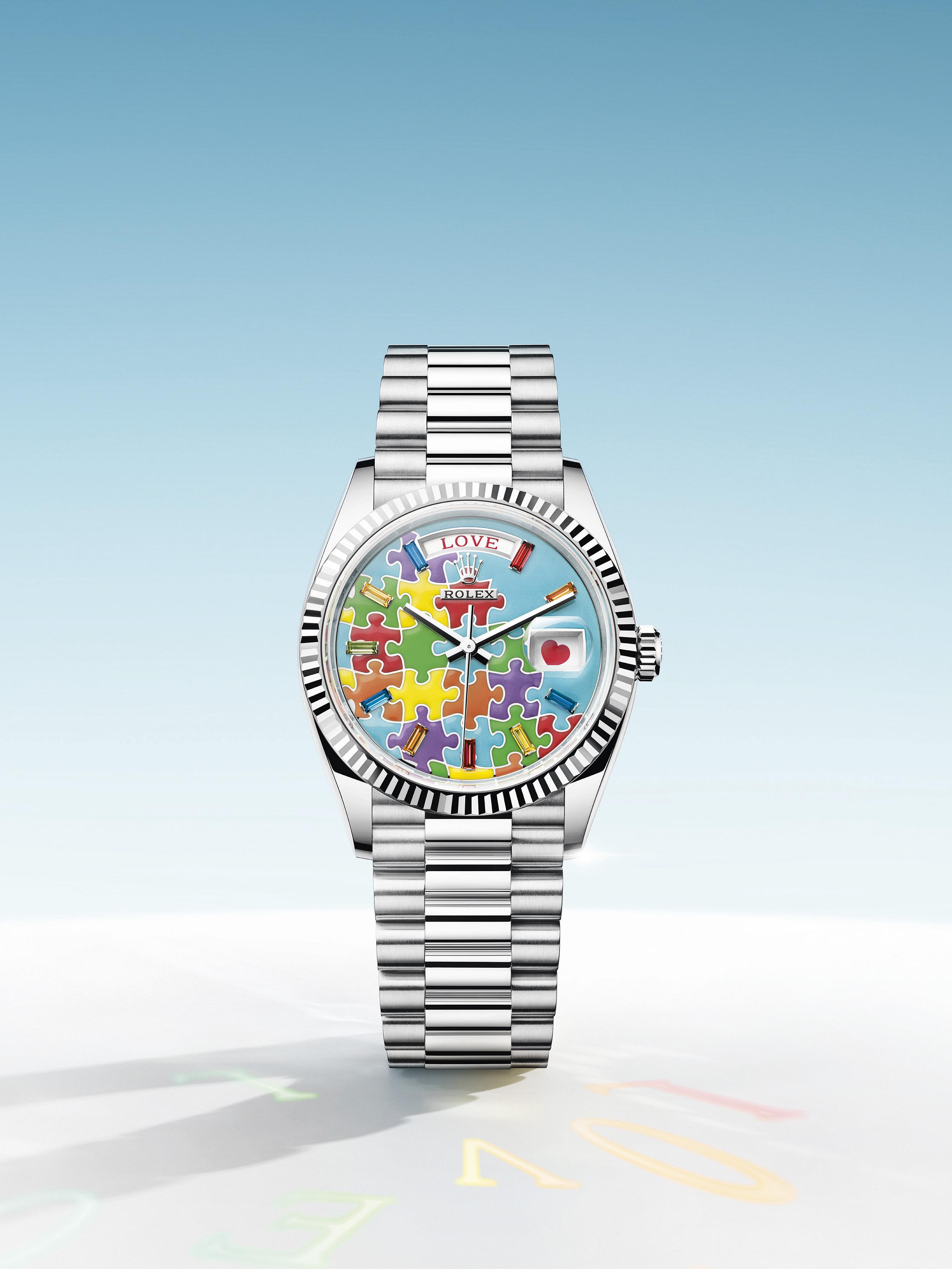
“Rolex brings an unexpected creative twist to one of its iconic models.”
Powering these three versions is the Rolex Manufacture 3255 calibre, which is covered by the Superlative Chronometer certification redefined by Rolex in 2015. This designation testifies that every watch leaving the brand’s workshops has successfully undergone a series of tests conducted by Rolex in its own laboratories according to its own criteria, following the official certification of the movements by the Swiss Official Chronometer Testing Institute (COSC).

The in-house certification tests apply to the fully assembled watch, after casing the movement, guaranteeing superlative performance on the wrist in terms of precision, power reserve, waterproofness, and self-winding. The precision of a Rolex Superlative Chronometer is set at -2/+2 seconds per day, a rate deviation that is significantly smaller (more accurate) than that accepted by COSC. The Superlative Chronometer status is symbolized by the green seal that comes with every Rolex watch and is coupled with an international five-year guarantee.
Calibre 3255 is a movement that was entirely developed and manufactured by Rolex that was released in 2015. This self-winding mechanical movement incorporates the patented Chronergy escapement, which combines high energy efficiency with great dependability. The escapement is made of nickel-phosphorus which makes it resistant to strong magnetic fields. The movement is fitted with a blue Parachrom
hairspring that offers great stability when experiencing temperature variations, as well as high resistance to shocks. It is also fitted with a Rolex overcoil, ensuring the calibre’s regularity in any position. The oscillator is mounted on the Rolex-designed, patented high-performance Parallax shock absorbers, increasing the movement’s shock resistance.
The movement is protected by a 36 mm Oyster case, guaranteed waterproof to a depth of 100 meters (330 feet). The middle case is crafted from
a solid block of 18 ct yellow, white or Everose gold. The case back is hermetically screwed down to assure water tightness and to keep it dust-free.
Part of buying a watch is how the timepiece makes us feel, the emotions it brings out on us. The new Oyster Perpetual Day-Date 36 not only enhances those emotions but also prompts us to feel even more positive sentiments by merely looking at the dial. This element of spontaneity may just be the nudge we need to make our day a little better.

Omega expands the Aqua Terra Worldtimer with steel and titanium
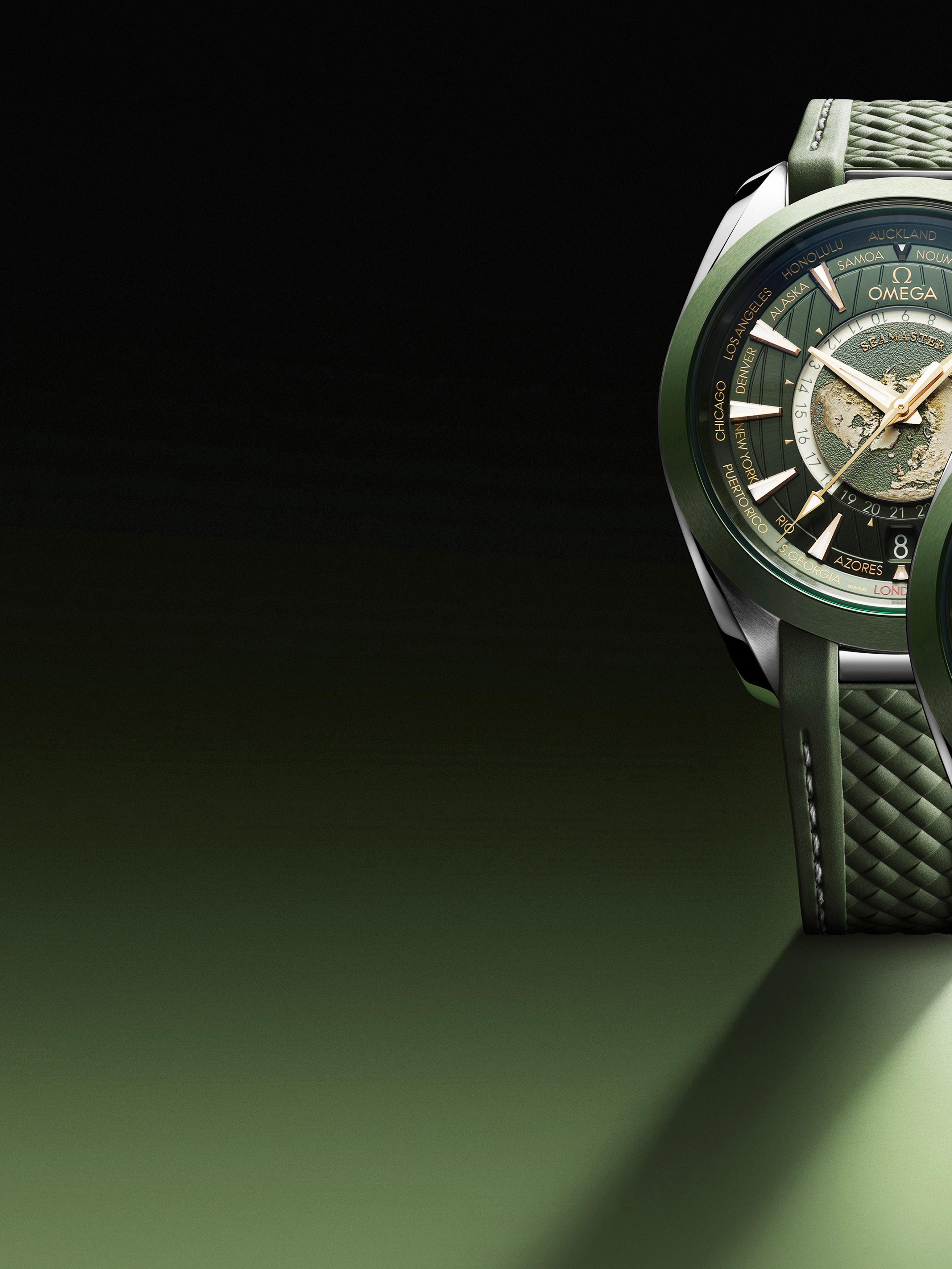
Words by Kit Payumo

The North Pole is the point in the Northern Hemisphere where the Earth’s axis of rotation meets its surface. Different from “magnetic north pole,” the true North Pole is also known as the Geographic North Pole, Terrestrial North or 90th Parallel North, and is by definition, the northernmost point on the Earth. Incidentally, the North Pole also happens to be Santa’s headquarters. But that’s another story for another time.
Indeed, all lines of longitude converge there and from the North Pole all directions point south, and since all longitudinal lines begin from it the North Pole has no timezone. Unlike the South Pole, which is a continental landmass, the North Pole is located in the middle of the Artic Ocean. There is no land per se in the North Pole and the “land mass” is made up of constantly shifting pieces of sea ice, which is about two to three meters (six to 10 feet) thick, while the depth of the ocean under it is more that 4,000 meters (13,123 feet).
The nearest land is Kaffeklubben Island, an uninhabited island off the northern most tip of Greenland, which is the northernmost point of land on Earth, while the nearest permanently inhabited place is Alert, in the Qikiqtaaluk Region of Nunavut, which is the northernmost point and third largest island in Canada.
It is this barren, permanently frozen but beautiful wasteland that watchmaker Omega has encapsulated in the Aqua Terra Worldtimer in the form of a unique world timer display. Introduced in 2017, Omega has recreated a miniaturized model of the Earth as viewed from above the North Pole on the dial allowing the Aqua Terra Worldtimer to track every time zone on Earth. Its realism has made Omega’s timepiece unique from other world timers and has, indeed, become the go-to timepiece for international travelers despite the fact that it wears rather large at 43mm. But, let’s face it, any watch with a literal globe on its dial needs to be on the large side for it to be legible.


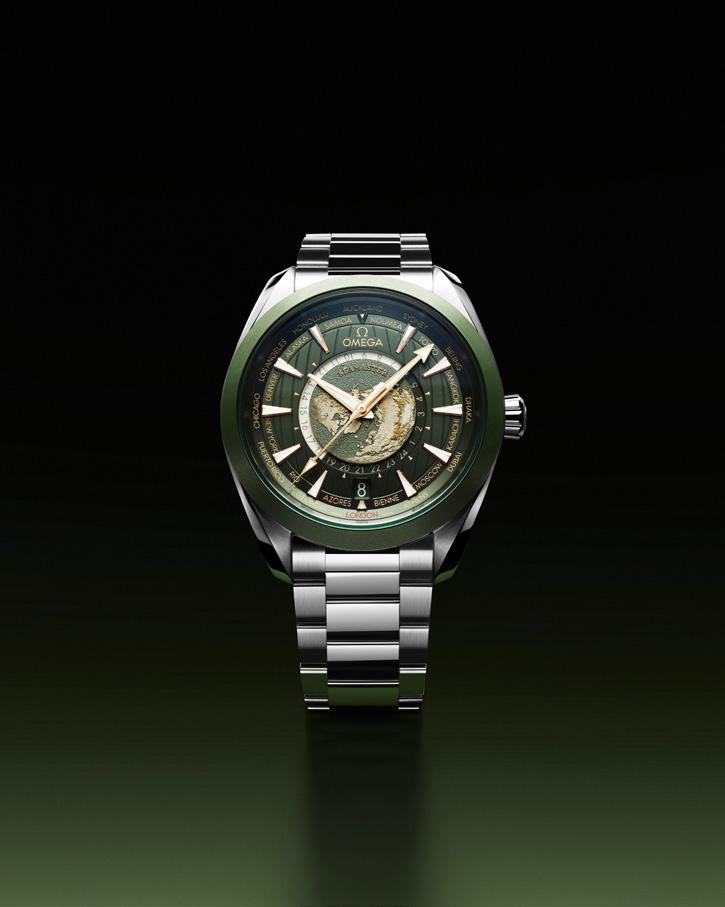
This year, Omega is expanding the Aqua Terra Worldtimer collection with two references in steel, and another in titanium with a dial made entirely by… lasers, laser ablation to be more specific. This is what all three references share and is what also
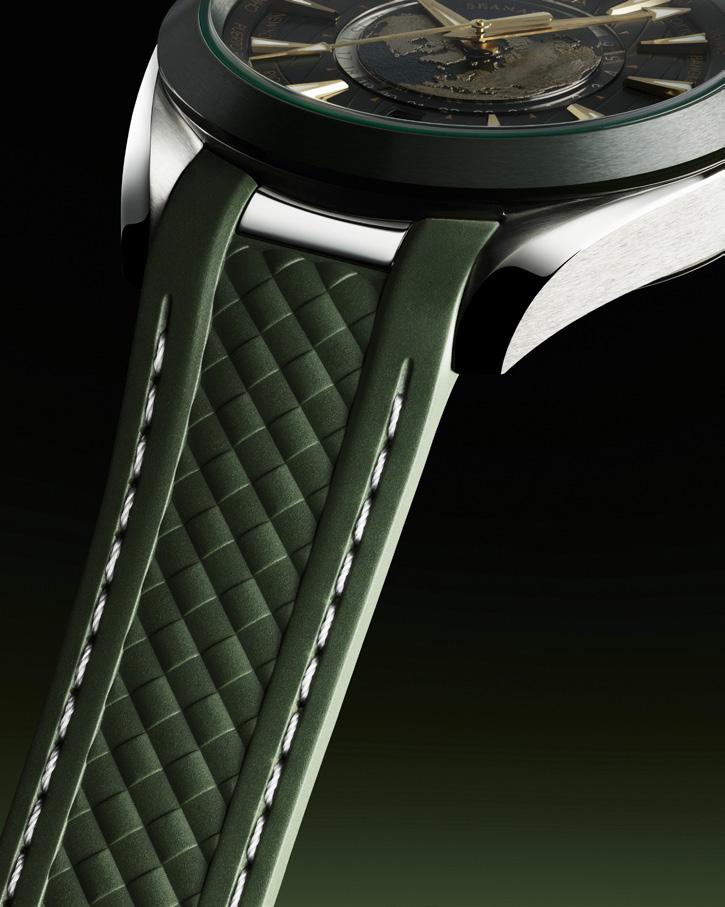


sets the titanium edition apart. More to the point, all three models share the same rendering of the North Pole, which is slightly domed to mimic the curvature of the Earth, and was executed by laserablating the continents and colors on a grade 5 titanium surface. The differences, however, occur everywhere else.
Aesthetically identical, the steel models fall on the greener side of things with brushed, scratch-
resistant, green ceramic bezels that play against green dials. The steel models also get a dial with curved vertical lines that accentuate the “global” effect done in a sun-brushed PVD finish. Further, the hands and applied hour markers on these variants are crafted from Omega’s own 18K Moonshine gold.
The city names on the steel versions are colored yellow gold to match the color of
the hands and indexes with the exception of LONDON, which is rendered in red to highlight Greenwich Mean Time or Universal Time Coordinated (UTC). Further, the two steel models also come with either a steel bracelet with a butterfly clasp, or with an integrated green rubber strap with grey stitching. The strap has an additional link in polished steel and a polishedbrushed fold over clasp.

The monochromatic titanium Worldtimer, on the other hand, separates itself from the pack with a dial made entirely with laser ablation. This makes the 43mm Worldtimer in lightweight and corrosion resistant titanium the ultimate statement piece. Bold and sporty, the titanium model benefits from an entirely black and grey dial, including its colors, crafted from lasers. Indeed, there are no transferred elements on its dial, with the exception of the word LONDON, the red varnish of which was applied by hand. To complement the matte dial, OMEGA obliged with a brushed black ceramic bezel, and blackened hands and indexes. These are filled with white Super-LumiNova that emits a cool blue glow in the dark. Finishing everything off is an integrated strap in black structured rubber with grey stitching with an additional decorative link in brushed grade 2 titanium, and grade 2 titanium clasp.
All three models feature a 24-hour indication, which is divided into night and day sections under hesalite glass, and which holds a small Easter egg: the Central Europe time zone is depicted by Bienne, home city of Omega in Switzerland. The Aqua Terra Worldtimer is driven by the METAS-certified Co-Axial Master Chronometer Calibre 8938, which is based on the well-known and powerful 89xx architecture. The self-winding movement features 2 barrels for a 60-hour power reserve, as well as a free-sprung balance with a silicon balance spring making it highly magnetic resistant.
For OMEGA President and CEO, Mr. Raynald Aeschlimann, the new watches are both innovative and inspiring. “At Omega, we take pride in our pioneering spirit and these watches are like a call to action. Go for it! Step out into the world! The dials are works of art, which prompt a sense of awe and adventure.What’s more, there is top-level technology working behind those amazing displays. They’re beautiful, fun to wear and operate, and are true collectables.”
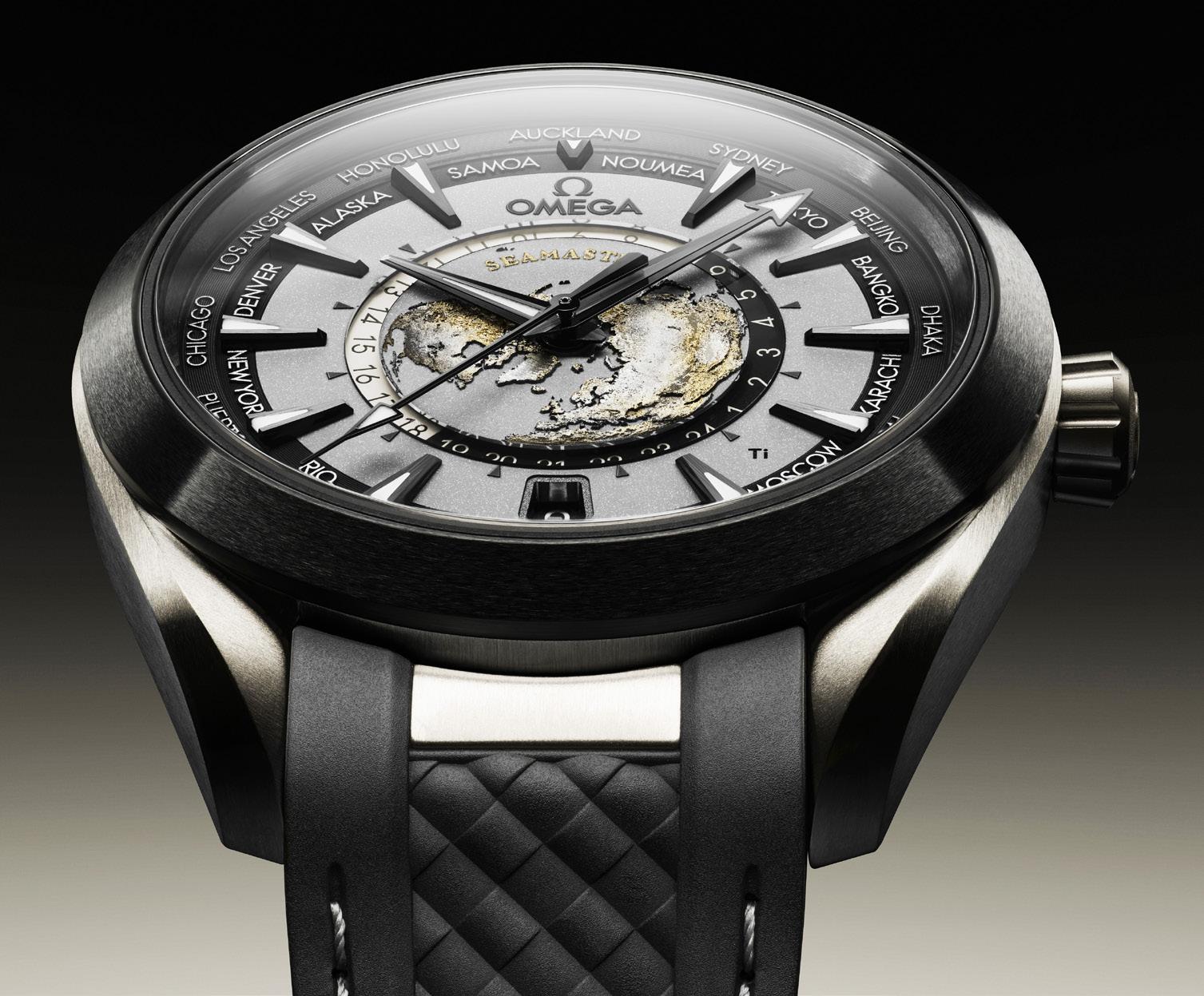
“Its realism has made Omega’s timepiece unique from other world timers and has, indeed, become the go-to timepiece for international travelers”

Words by Kit Payumo
The Milan Furniture Fair is the largest trade fair of its kind in the world. Held annually in Milan, the fair showcases the latest in furniture and design from countries all over the world. And as an official partner of the Salone del Mobile Milano in 2023, Panerai has chosen the fair to showcase its new line of steel watches from the Radiomir Quaranta collection.
Not content with the half-dozen watches launched at the recent Watches & Wonders 2023, Panerai gives us more to consider with a bevy of watches designed to demonstrate the Italian watchmaker’s vision of the future, while deliberately mining the brand’s storied past. Indeed, the Radiomir Quaranta is a faithful homage to the Italian brand’s iconic relationship with the Royal Italian Navy. Modern and sophisticated, the Quaranta timepiece may be a pared down version of the first watch ever supplied by Panerai to the Italian military but it is still imbued with the celebrated design aesthetic that mark all Panerai timepieces. And by featuring elements distinctly linked to this history, the Quaranta is designed to appeal not only to connoisseurs of the brand’s military heritage and expertise, but also to individuals that may have never considered Panerai in the past.
And that’s because these modern watches, which can be said have one foot in the past and one foot in the future, are not outright reproductions but an interpretation of the very aesthetic codes that made these first watches so visually appealing in the first place. This includes the brand’s famous minimalist aesthetic, albeit brought forward into the 21st century and geared to cater to modern consumer’s more discriminating tastes.
Even the name Quaranta, which means “forty” in Italian, represents the 40mm case size of the collection, the cushion-shaped case of which has been significantly scaled down from the 47mm size of the original Radiomir timepiece supplied to the Italian Navy some eight decades ago. In tune with a modern user’s more selective needs, the Quaranta timepieces are only 10.15mm thick indeed, the slimmest in the entire Panerai range, and make for a versatile silhouette for “all genders” and occasions.
The steel timepieces, in fact, bring a more inclusive vibe to the proceedings and feature gorgeous sun-brushed sandwich dials that reflects light rays with the wearer’s movement; indexes and numerals only at twelve and six o’clock; Super-LumiNova to properly illuminate the dial; the cone-shaped crown, a distinguishing element of the Radiomir collection; and semimatte alligator straps that exude understated



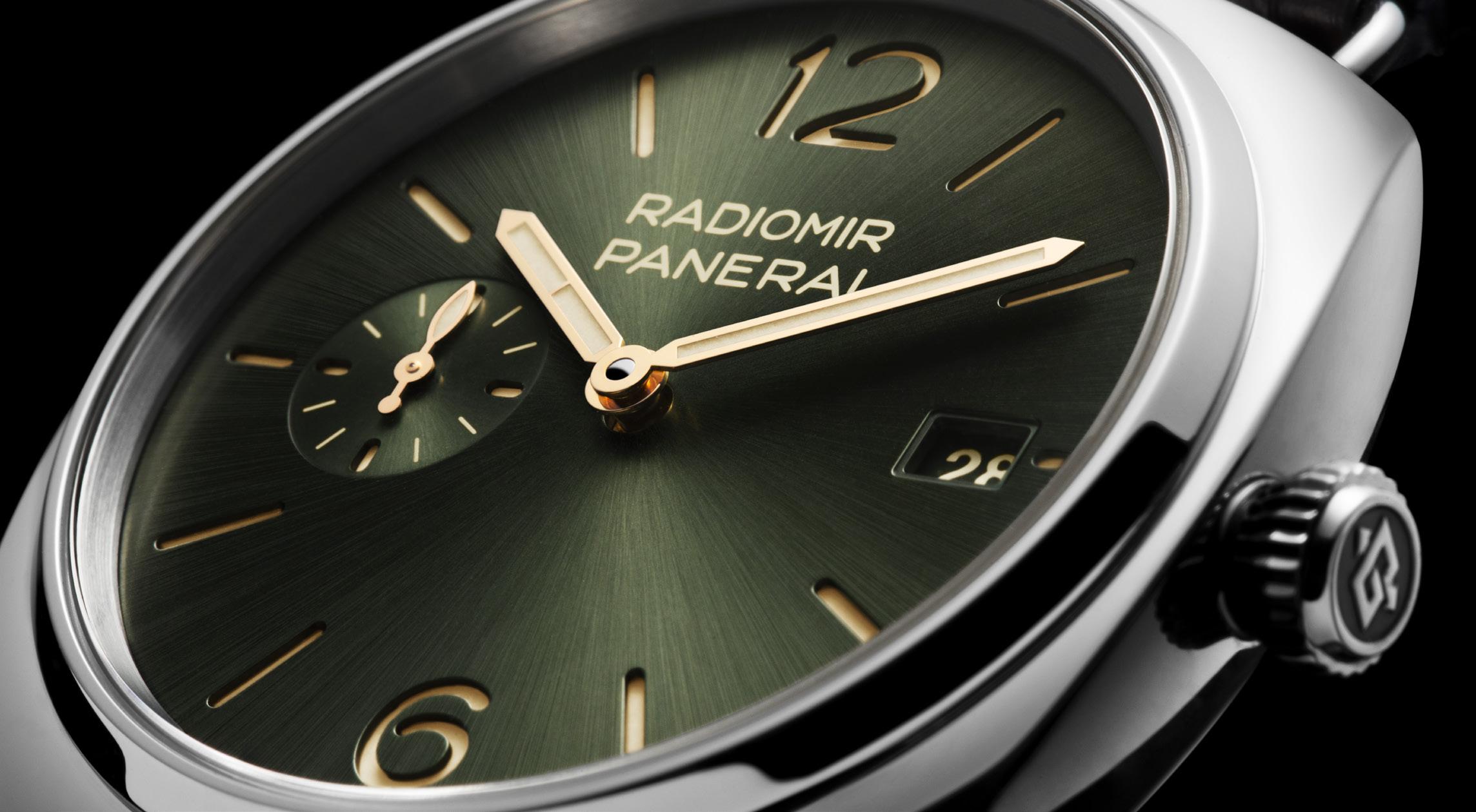
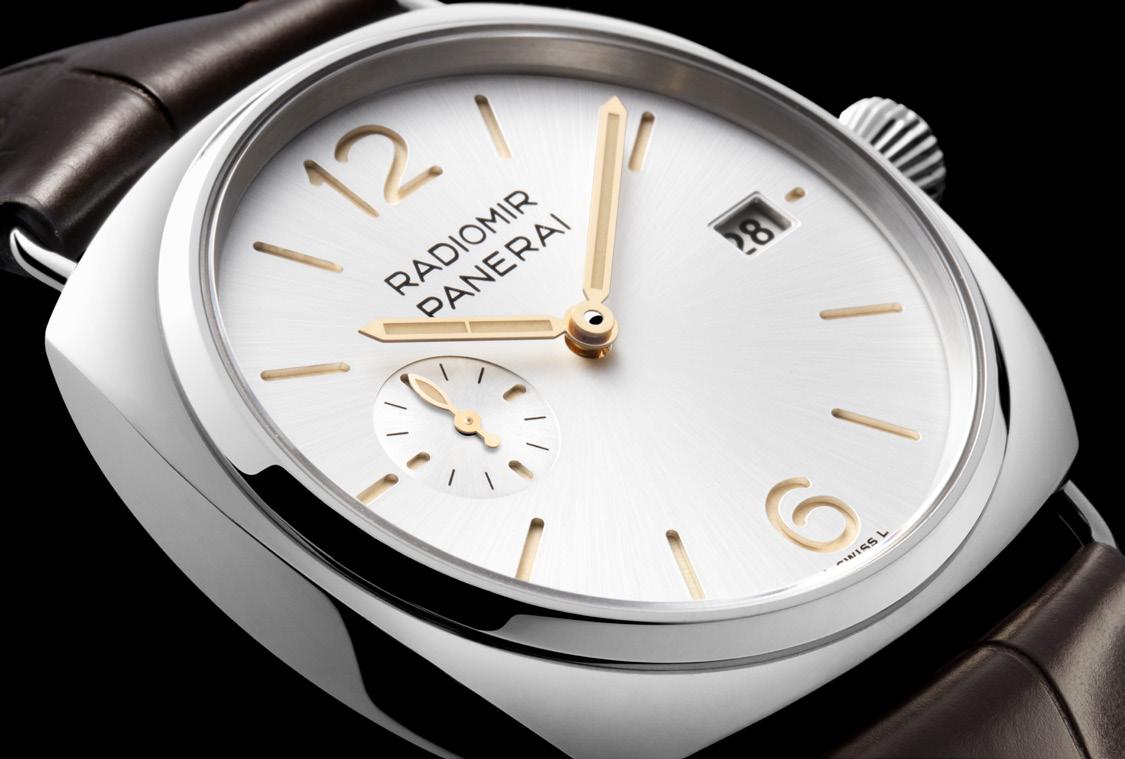
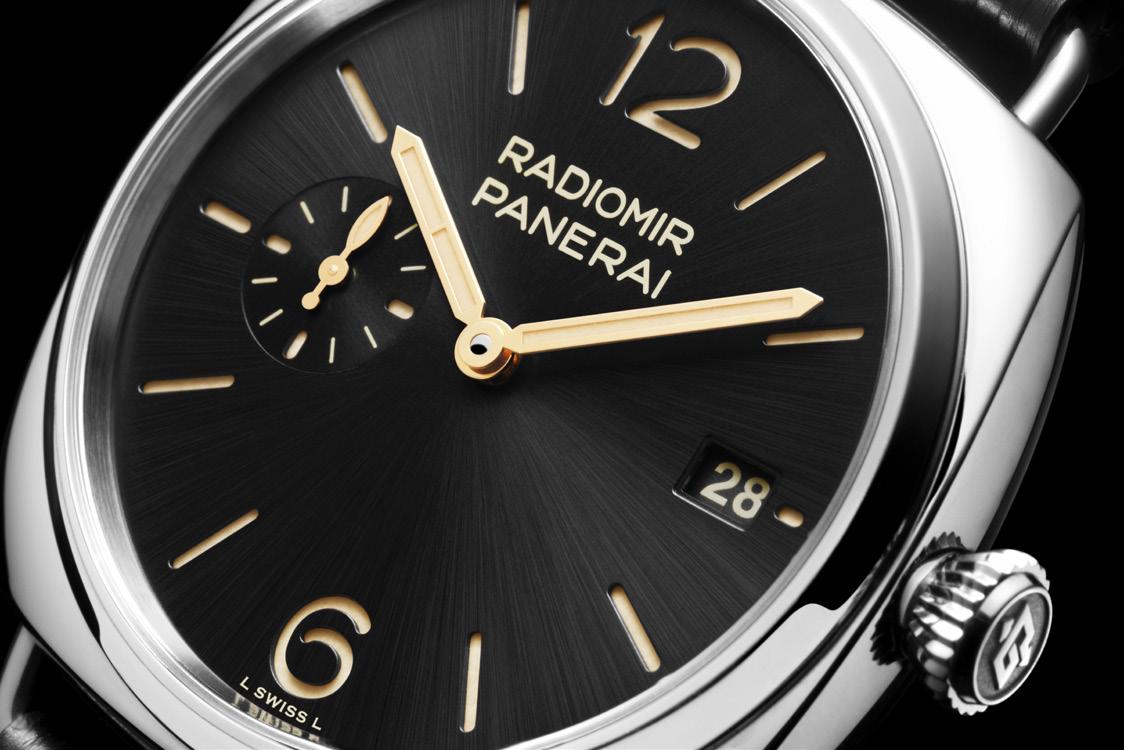
and relaxed luxury that are interchangeable with selections from Panerai’s wide range of colors to suit the demanding and vacillating tastes of modern consumers.


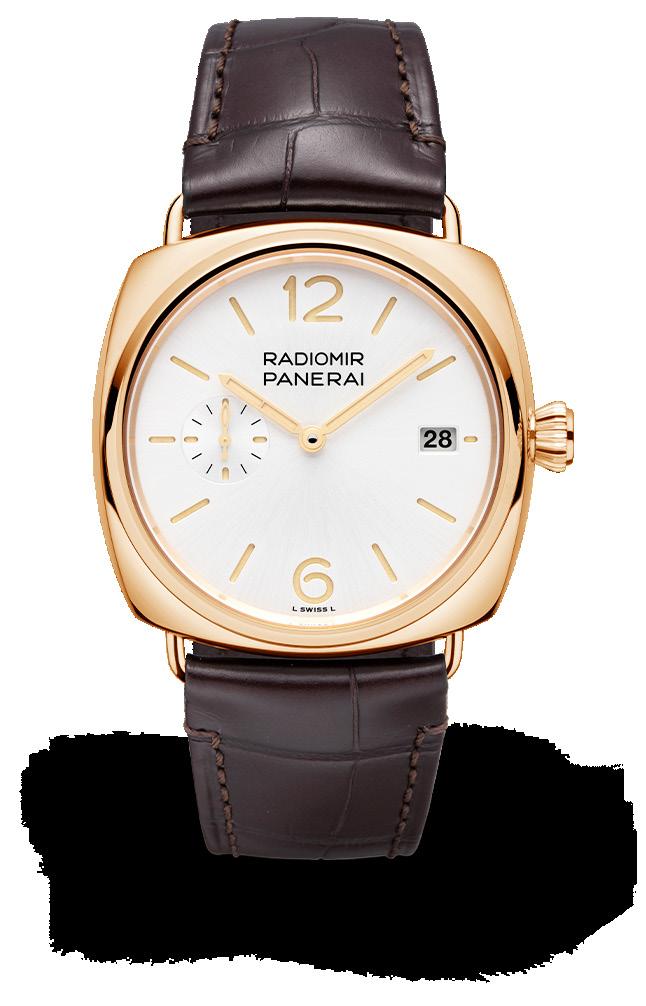
Indeed, the steel versions are in sync with the times by being made of eSteel, a nextgeneration metal “obtained from pre-consumer recycled steel scraps,” 95% of which comes from different industries including the Swiss watchmaking industry. Produced in partnership with IOC-UNESCO, which develops solutions for a more sustainable and equitable society, the steel watches from the Radiomir Quaranta collection brings the timeless “Panerai” aesthetic to the proceedings, all while maintaining the commanding aspects of those first legendary divers watches from the 1940s.
Upon launch, no fewer than five executions of the Radiomir Quaranta will be made available: four in steel and one in glimmering yellow gold. The first being PAM01292 with a white dial swathed in beige Super-LumiNova and a dark brown alligator strap; a model with a blue dial is PAM01293 and features white Super-LumiNova with a dark blue alligator strap; while coming in third is PAM01294 with its dark anthracite dial, beige Super-LumiNova, and matte black alligator strap. And for the first time ever, Panerai pairs the exquisite sun-brushed green dial with a polished steel case in a dashingly sophisticated reference. Matched with an alligator brown bracelet, PAM01386 is an e-commerce exclusive.
The most distinguished models in the lineup, however, are the Radiomir Quaranta Goldtech™ and Radiomir Quaranta in yellow gold. The

former is set in a polished Goldtech case, a brand exclusive alloy that combines platinum and copper to give the material an intense red appearance. PAM01026 is matched with a white sun-brushed dial and a matte brown alligator strap. The latter, on the other hand, is the boutique exclusive PAM01437, only 500 pieces of which will be made each year. Indeed, the Radiomir Quaranta in yellow-gold follows in the footsteps of other well-loved classics in the same
color way and is matched with a with a sunbrushed green dial, an ode to Panerai’s signature green color, with white Super-LumiNova and a matt black alligator strap.
All versions of the Panerai Radiomir Quaranta are driven by the P.900 calibre, the next-generation of Panerai self-winding movements, and the first of its size to combine the date with three days of power reserve. Perfect for the all-inclusive and diverse lifestyles of modern consumers.


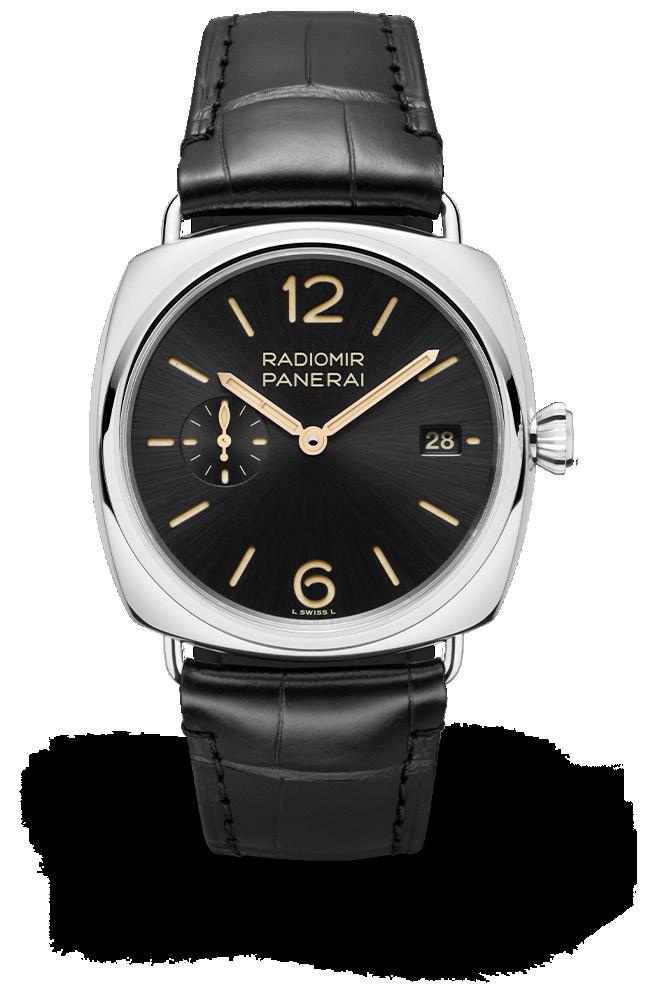 Radiomir Quaranta Goldtech™ PAM01026
Radiomir Quaranta PAM01292
Radiomir Quaranta PAM01293
Radiomir Quaranta Yellow Gold PAM01437
PAM01026
See-through sapphire crystal and polished Panerai Goldtech™ caseback
Radiomir Quaranta PAM01294
Radiomir Quaranta Goldtech™ PAM01026
Radiomir Quaranta PAM01292
Radiomir Quaranta PAM01293
Radiomir Quaranta Yellow Gold PAM01437
PAM01026
See-through sapphire crystal and polished Panerai Goldtech™ caseback
Radiomir Quaranta PAM01294

BEAUTY IN DARK OR LIGHT
Words by Katherine Cunanan
Hermès is a maison well known for elegant and luxurious creations, and more often than not, is associated with horses and the equestrian world. For proof, look no further than the iconic logo. As often happens, the equestrian theme finds its way onto many of the Hermès offerings, whether explicitly or discretely. Let’s take a closer look at a couple of Hermès watches, each one with a different expression of the equestrian spirit of the brand.
The first Hermès watch we are looking at is the Hermès Arceau Petite Lune. The watch itself is a striking study of dark and light. The Arceau watch was initially offered in 1978, designed by Henri d’Origny, and was the perfect combination of creative understatement. The round watch case may seem too simple at first, but a closer look reveals the stirrup at the top of the case. The stirrup in the original design was an elegant nod to the equestrian world that is such a strong part of the Hermès history. The models released since then have different enhancements or touches of interest, but continue with the original aesthetic.
This model of the Arceau focuses on the dark sky and the planets that rest in it. The dial is mother-of-pearl with aventurine. Aventurine is a mineral in the class of Chalcedony, and is a form of quartz. The mineral’s translucency allows it to have visual depth, and the inclusions within the mineral create a glistening effect called aventurescence. Think of looking up at the dark sky with stars twinkling here and there, you get the idea. Gracing this dial are planets made of aragonite and opal. Aragonite also a mineral, and is similar in composition to calcite, but has a different crystal structure. Opal, on the other hand, is a very delicate gemstone and comes in a very wide range of colors. Ancient Romans believed that because the opal held colors of all other gemstones within it, it was the most precious and most powerful. The night sky is incomplete without the moon, and on this dial, the moon is a very lustrous mother-of-pearl.
And if all these planets and minerals weren’t enough, Hermès added a most precious gemstone to the mix: diamonds. Sprinkled across the dark blue dial are 5 diamonds representing a handful of planets across the vastness of the night sky. But wait, there’s more. The elegant white gold case with the stirrup is the original design by Henri d’Origny, and this model has 70 diamonds circling the dial.


“The night sky is incomplete without the moon...”
This Arceau Petite Lune is powered by the Hermès Manufacture movement H1837, which is a mechanical self-winding movement. It beats at 28,800 vph, or 4 Hz. The watch has the hours and minutes functions, and a moon phase function tucked in between 10 and 11 o’clock on the dial. The watch is an elegant timepiece, measures 38 mm in diameter, and has a 42-hour power reserve. The sapphire blue polished alligator and navy-blue Swift calfskin leather strap complement the blue dial quite well.
The second watch we are looking at is the Hermès Slim d’Hermès Cheval de Légende, and it comes in two models. Initially released in 2015, the Slim d’Hermès watch is simple but not boring. The white gold round case here has angular lugs, which give it a point of visual strength without being too masculine. The focal point of any watch is typically the dial, and such is
the case here. The dial features another nod to the equestrian history of the brand.

Benoît-Pierre Emery is a French art director and fashion designer, and has done extensive work with Hermès. His passion for scarves began in 2001, with the purchase of a vintage scarf. Since then his collection has grown to more than 10,000 pieces, some from the famous houses, others still unknown. What catches his eye in a scarf? Sometimes it is the design, other times it is the designer.
Emery first created the galloping horse image for Hermès back in 2010, on a beautiful silk scarf, with simple gold dots. Think of a type of pointillism but elevated with exquisite elegance. That design has been recreated on the dials of the Hermès Slim d’Hermès Cheval de Légende in two color palettes: white and rose gold, or white and blue.
Transposing a design from one object to another is not always a simple task. In this case, a design from a possible 36-inch square scarf
needed to be reimagined onto a dial that is less than 40mm in diameter. The re-design process must be thoughtful — do we create the image in miniature, or crystalize the essence of the original design with a sort of thumbnail version?
The artisans here had their work cut for them, and they devoted many man-hours to doing justice to both the spirit of the Slim d’Hermès and the Emery design. The dial is prepared by enameling and hand-polishing the white gold disc. A laser is then used to carve out tiny cavities or dents following the planned pattern. The 1,678 rose gold beads are hand-placed one a time to recreate the design. Another firing to set the enamel is needed, and the timing is critical. Too long or too short a firing would result in a less-than-perfect outcome. The dial for the blue and white model has a similar process for blue beads. These 1,678 blue beads are made from crushed enamel, which are moistened then set in place with a brush. Another firing is needed here too, to set the blue beads in place.

There are diamonds for this watch too, 52 baguette-cut ones also circling the dial. The watch has the ultrathin Hermès H1950 selfwinding movement, with 160 components and 29 jewels. The watch has hours and minutes functions, and a 48-hour power reserve. The rose gold bead model has a Chantilly matte alligator leather strap, while the blue enamel bead model has a sapphire-blue alligator leather strap. These watches are a limited and numbered series of 24.
These Hermès watch models give a solid nod to the equestrian heart of the maison. And while the nod is expected, Hermès still finds interesting, elegant, and delightful ways to bear their heart for us to enjoy.


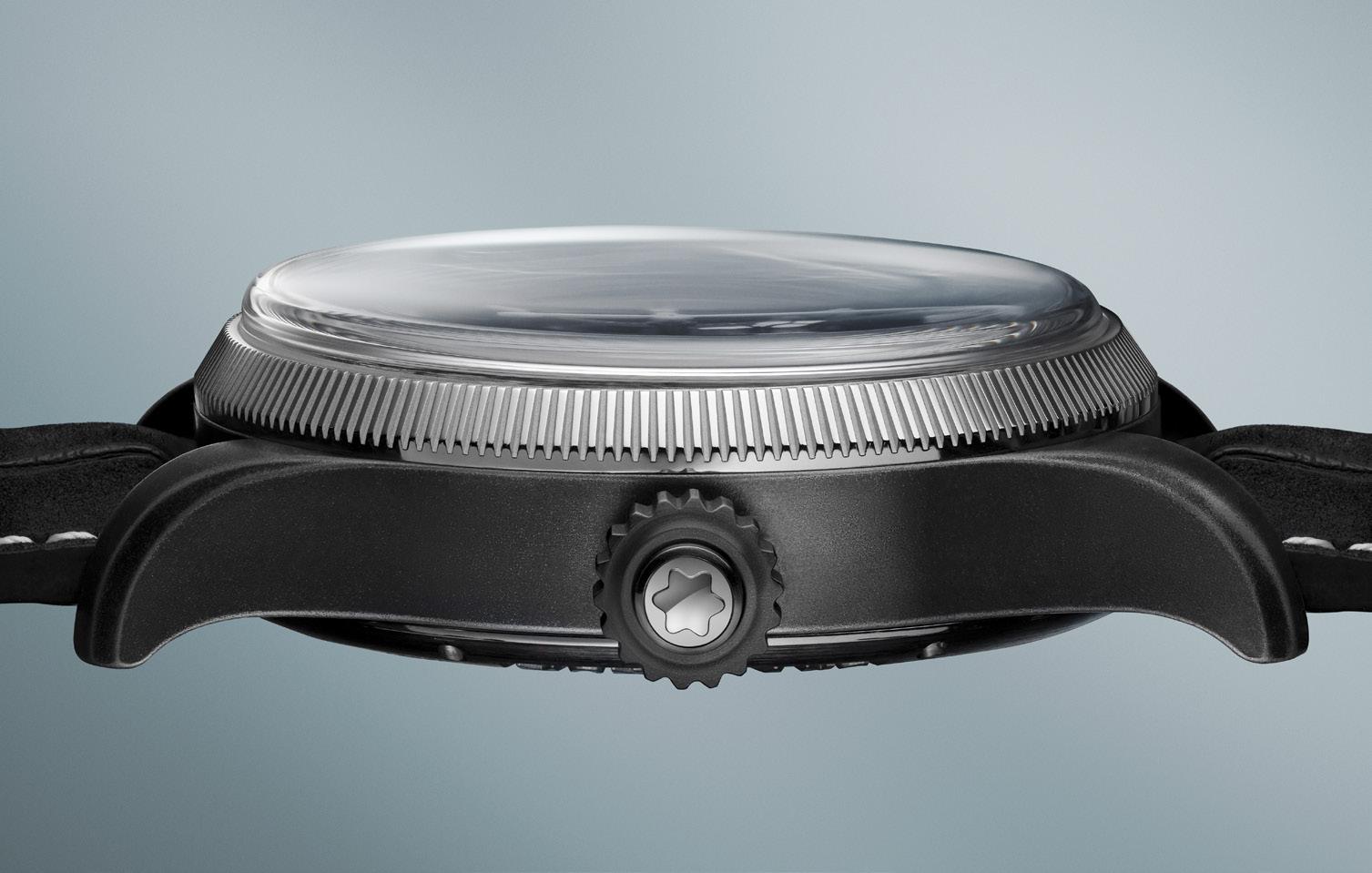 Words by Kit Payumo
Words by Kit Payumo
It seems that every watchmaker, from the lowest to the highest end, has been getting into the openworked game of late. Which is why at the Watches & Wonders show last year, many weren’t surprised that Montblanc, which went to great lengths to acquire the historic Minerva manufacture from parent company Richemont in 2007, had finally come out with their own skeletonized timepiece (and two of them at that), only to do a double take after realizing that the Maison actually hadn’t.
That’s right, for those who have been living under a rock since the onset of the Pandemic, Montblanc got into the openworked game last year by NOT making a skeletonized chronograph. Instead, Montblanc continued to tap into Minerva’s famed 165-year heritage by presenting the rather long-windedly named Montblanc 1858 “The Unveiled Secret” Minerva Monopusher Chronograph, the “unveiled secret” being an original (or should we say “historic”) Minerva chronograph movement that the Manufacture FLIPPED OVER to create the illusion of skeletonization.
It was around this point that the angry little trolls that seem to make up 90% of social media nowadays began dismissing Montblanc’s actions as a cop-out, but the reality is actually a lot more complicated (or should we say, creative?) than that. For those in the know, the Minerva manufacture is famous for making some really nice chronograph movements (they specialize in it), and Montblanc took one of those movements, the MB 16.29 with all of its elaborate touches and meticulous hand-finishing intact, and flipped it over by 180° without doing anything special to embellish or skeletonize the movement. Instead, what is seen on the dial of the “Unveiled Secret” is exactly what would have been seen from the caseback of a Montblanc 1858 had the MB 16.29 movement been kept intact.
This is Minerva flexing its considerable muscles and simply showing off what it had already been doing all these years. And it wasn’t as easy as simply flipping over the movement! Chronographs with traditional layouts have always had their stopwatch mechanisms, especially with their high number of large and interconnected parts, engineered at the rear of the movement, and flipping it over meant everything
was in reverse! This is why Montblanc had to go the extra mile and add about 21 extra parts to reverse the direction of the hands, making the entire endeavor more than just an aesthetic exercise, but a truly technical one.
The result is something many watch enthusiasts probably would have wanted anyway: with the wheels, cams, levers, and even the column wheel all installed back-to-front. Further, eagle eyed readers noticed that the calibre is no longer designated MB 16.29 either, but “transformed” as well into the MB 16.26 with the “9” was flipped over to “6” to represent the physical change of flipping over the movement.
A manually wound monopusher 30-minute chronograph, the MB 16.26 is made up of 273 parts, which includes a rather large 14.5mm in diameter balance wheel that moves in a stately, relaxed motion as seen from the dial side. And that’s because the movement operates at a very old school 2.5Hz (or 18,000 Vph) allowing for a massive balance wheel, and boasting a power reserve of 50 hours. This no-frills, classic movement made of sanded German silver, which can be viewed from the front sapphire crystal, feature details that include bridges and plates coated with anthracite ruthenium, as well as the Maison’s unique snailed diamantage coquille motif. And did we mention every component is thoroughly polished as well? And that includes the inner angles of the components.
In keeping with all of Montblanc’s complicated movements, the distinctive Minerva arrow and the Maison’s “V”-shaped bridge are also on display. The former is a tribute to the Roman Goddess who is always depicted with her arrowtipped staff in hand, and the unusual “V”-shaped bridge comes from the view of the mountains seen from the watchmakers’ window in Villeret, a sight that has been a constant since the founding of the workshop in 1858.
Particular attention was paid to the dial indications so that they don’t distract from the movement. This includes the open-worked 30-minute counter at 3 o’clock, the open-worked small seconds at 9 o’clock, the white luminescent ruthenium-coated Arabic numerals and indexes, white luminescent ruthenium-coated hour and minute hands, rhodium-coated seconds hand; rhodium-coated chronograph minute hand with white arrow; and the white chronograph seconds hand. All of which is topped by a historical
Montblanc logo, and a fluted bezel in white gold, a sharper and more angular example, which was inspired by the Manufacture’s first fluted bezel from 1927.

All this elaborate finishing (as well as the ingenious layout) is more than an invitation to look into the depths of the movement. The Montblanc 1858 “The Unveiled Secret” Minerva Monopusher Chronograph offers one of the most distinctive, one of the largest, and certainly one of the most detailed traditional chronograph displays available today. Everything is truly a feast for the eyes, especially when the chronograph is in operation. This is a particularly complicated looking movement, which is affirmed with every press of the pusher integrated into the crown.
Following the release of the two Montblanc 1858 The Unveiled Secret Minerva Monopusher Chronograph limited edition timepieces from last year: 58 pieces in steel (reference 129613), and 18 pieces in lime gold (reference 129622), the Villeretbased Manufacture took the opportunity of the
Watches & Wonders 2023 to release a third limited edition, albeit this time clad in distressed steel.
And by “distressed” they mean stone washed. That’s right, just like denim. And not just any stone, but quartzite from the Mont-Blanc and limestone from La Combe Grède, the “V”-shaped mountain opposite the Villeret Manufacture. The 43mm steel case is first treated with a black coating, which is then washed and brushed by hand with the quartzite and limestone. The result of this process is two fold: not only does it pay homage to the two homes of all Montblanc watches after 2007, but the manual hand brushing creates a unique patina making each Montblanc 1858 The Unveiled Secret Minerva Monopusher Chronograph 88-piece limited edition unique.
This latest version is fitted with a black nubuck alligator strap with a distressed steel triple-folding clasp, and since all the eye-candy is on the dial side, the caseback is (naturally) closed but features a nicely detailed engraving of the historic Minerva Manufacture.
“Montblanc had to go the extra mile and add about 21 extra parts to reverse the direction of the hands, making the entire endeavor more than just an aesthetic exercise, but a truly technical one”


Extreme E is the first sport built out of concern for the climate crisis. The series’ goal is to use electric rally cars to highlight remote environments under threat of climate change issues, and to encourage everyone to take positive action to protect our planet’s future.
With 30% of the planet’s CO2 emissions coming from transport, Extreme E exists to showcase the performance of electric vehicles, using the powerful mix of thrilling sports action, scientific education and storytelling to accelerate their adoption in order to reduce CO2 emissions and achieve a more sustainable lifestyle. Extreme E strives to: a) promote greater environmental responsibility, b) reduce the overall climate impact from sports, and c) use its platform to educate for climate action.
Though these cars are 100% electric, they can still run up to 200 km/h, produce 400 kw of power and 920 nm of torque on 550 hp engines that can take the car from 0-100 km/h in just 4.5 seconds.
While most live sports rely on spectator crowds, Extreme E is taking an opposite approach in order to reduce impact on remote race environments. Fans will follow all the action via live TV action, YouTube, and social feeds. The bulk of the TV operations, including the editing and transmission of the world feed, will also be done remotely from London. Each Extreme E team will also be limited to just 8 people: two drivers (one male, one female), one engineer, and five mechanics.
To further minimize its carbon footprint, all championship freight and infrastructure, including vehicles, are transported by sea using the refurbished St. Helena, a 7,000 tonne ship that also provides accommodation during the races, and is home to a scientific laboratory that gathers information and data on her global voyage. By shipping everything by sea, carbon emissions are lessened by as much as 75%.
Last May, ZENITH unveiled the DEFY Extreme E limited edition watch, crafted entirely in carbon fibre and featuring Extreme E’s official “Vital Green” color. This is the lightest iteration of the groundbreaking 1/100™ of a second chronograph to date. Combining performancecentric materials and a high-frequency chronograph movement capable of accurately measuring elapsed time to an astounding level of precision, the DEFY Extreme E edition has also been conceived around the values of sustainability shared by Extreme E and ZENITH’s HORIZ-ON initiative of CSR objectives and commitments.
ZENITH made its most rugged 1/100™ of a second chronograph even lighter while retaining its inherent toughness. Tried and tested in some of the most extreme conditions and environments that Extreme E has provided, the DEFY Extreme E edition is the first model in the collection to be crafted entirely in lightweight yet tough carbon fibre. The watch weighs only 96 grams, including the strap and carbon fibre triple-folding clasp.
It has an open multi-layered dial, consisting of tinted sapphire crystal elements and embellished with Extreme E’s official “Vital Green” color accents, a subtle reminder of the championship’s
ZENITH UNVEILS THE DEFY EXTREME E LIMITED EDITION WATCH.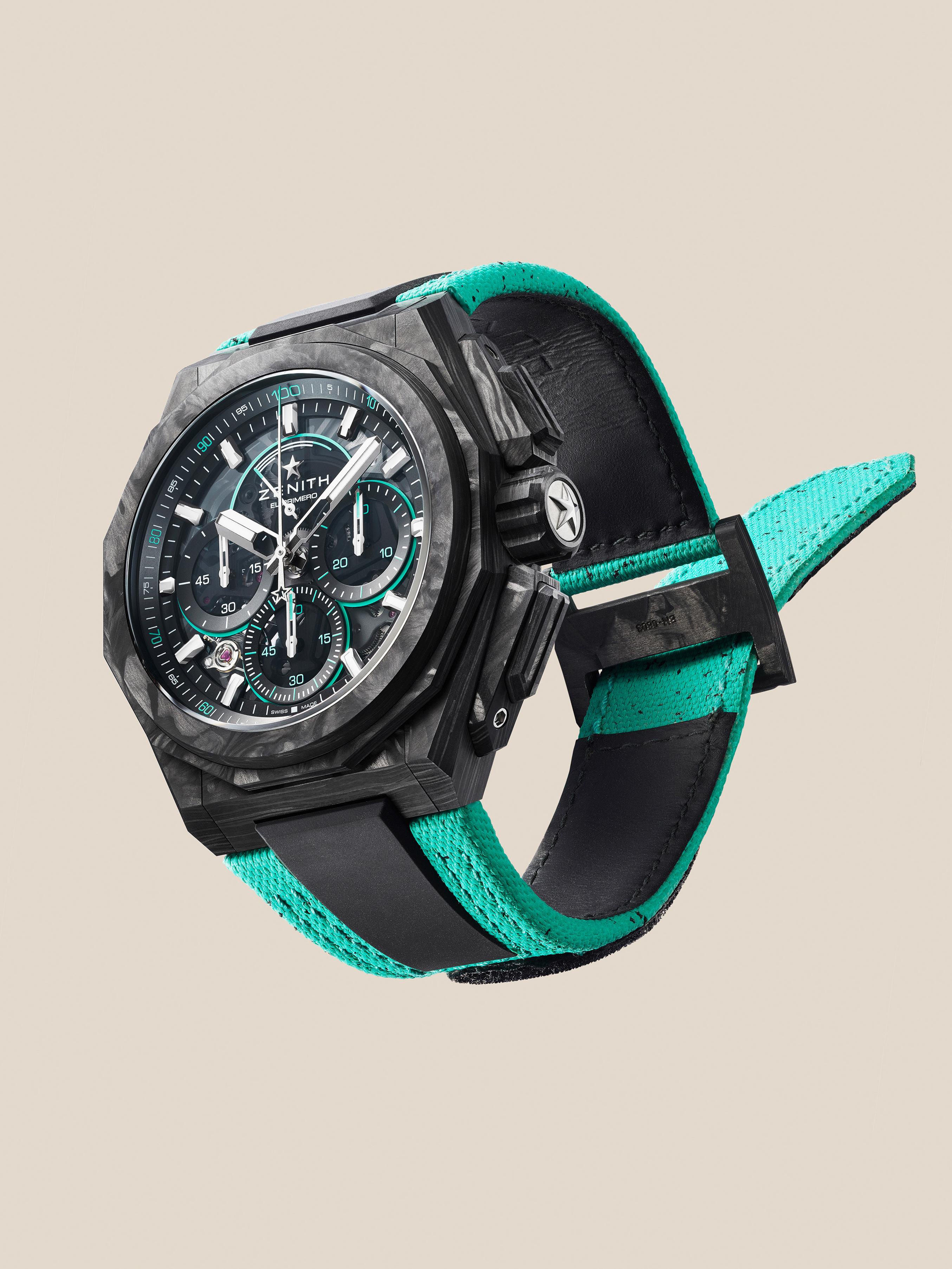
core value of sustainability. Partially visible through the open dial as well as the sapphire case back is the world’s fastest automatic highfrequency chronograph calibre in production, the El Primero 9004 automatic movement, offering 1/100th of a second time measurements by means of two independent escapements beating at the rate of 5Hz (36’000 VpH) for the timekeeping part and 50Hz (360’000 VpH) for the chronograph function. It displays the seconds at 9 o’clock, a central chronograph hand that makes one turn each second, a 30-minute counter at 3 o’clock, a 60-second counter at 6 o’clock, and a chronograph power reserve indicator at 12 o’clock.
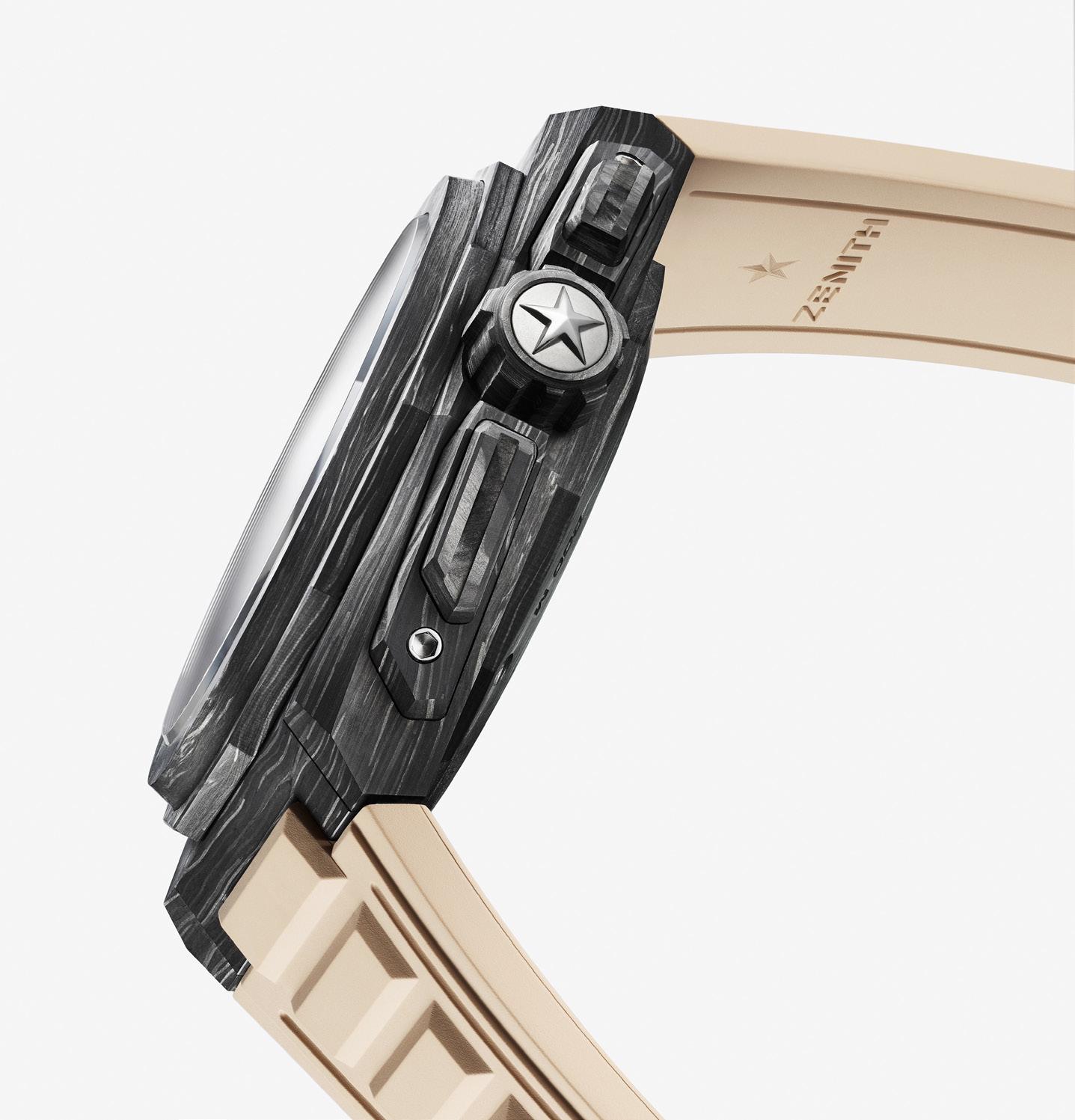
Highlighting the themes of sustainability and environmental awareness the DEFY Extreme E edition is delivered with a rubber strap infused with materials of upcycled Continental CrossContact tires that were used in the first season’s races. Matching the Extreme E Vital Green accents on the dial, the Velcro strap features a black rubber central element surrounded by green cordura-effect rubber. The DEFY Extreme E edition is delivered with two additional straps in black rubber and black Velcro, which can be easily swapped without any tools by using the case back’s ingenious and intuitive quick strap-change mechanism.
The DEFY Extreme E edition is delivered in a suitably sturdy waterproof and crushproof watch case inspired by the extreme conditions of the rally, incorporating various upcycled elements from the side-lines of the first Season’s races. The case’s lid coating is made from E-grip recycled tires, while the plate covering is made from parts of an Extreme E racing tarpaulin.

Made in a limited edition of 100 pieces, the DEFY Extreme E edition is available exclusively at ZENITH physical and online boutiques around the world.
“This is the third year that Extreme E has been championing the causes of sustainability and climate change awareness, which are central to ZENITH’s HORIZ-ON CSR initiative,” shared Extreme E CEO Julien Tornaré. “ We’re honored to be able to continue supporting Extreme E as we have from the very beginning, as we truly consider it to be the future of rally racing. The DEFY Extreme E edition commemorates this with an all-carbon construction, a first for the DEFY Extreme line. We’re thrilled to be able to launch it here in Scotland with our friends and partners.”
“THE ZENITH DEFY EXTREME E EDITION IS THE LIGHTEST IN THIS COLLECTION, WEIGHING IN AT ONLY 96 GRAMS.”
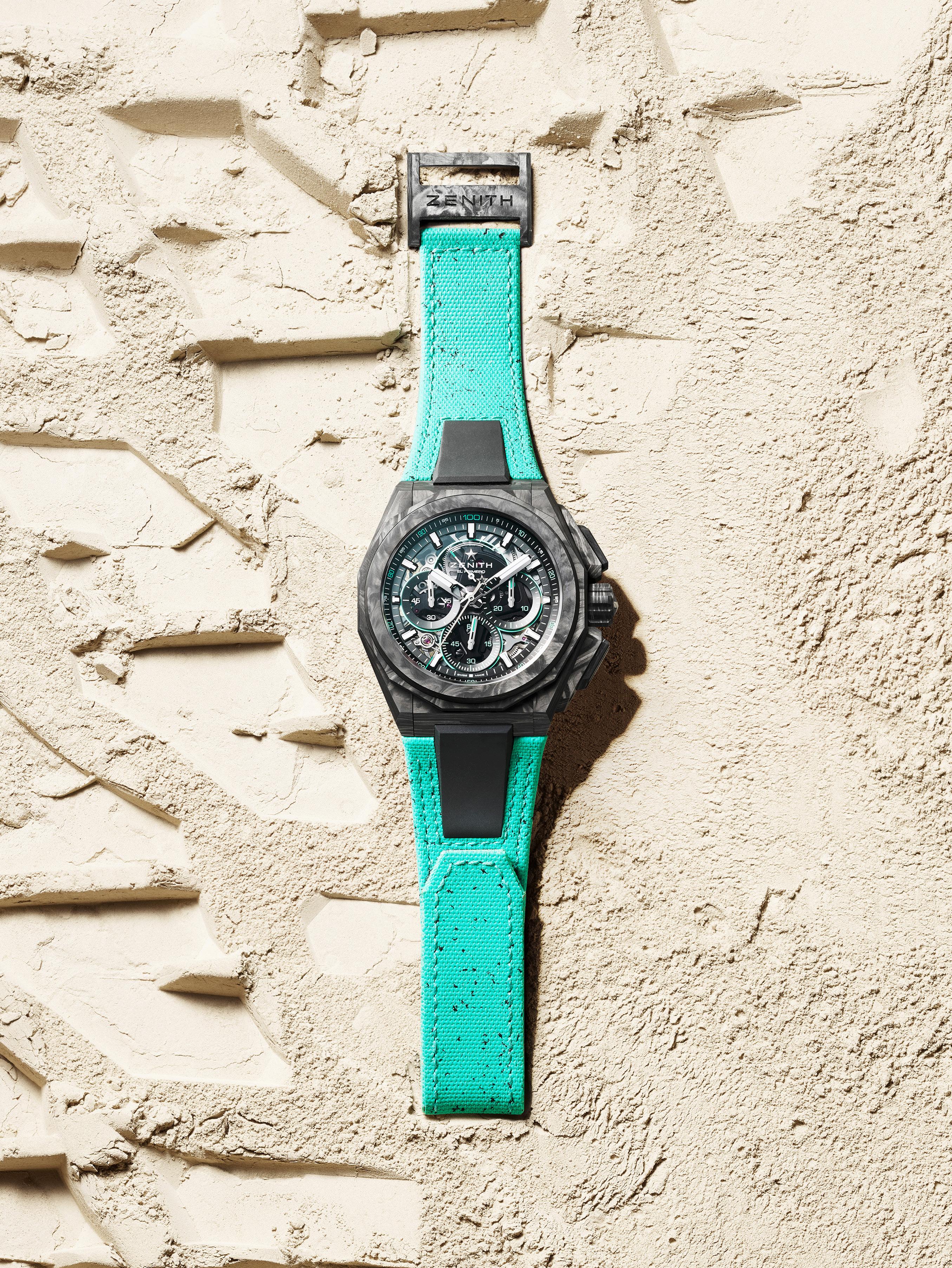

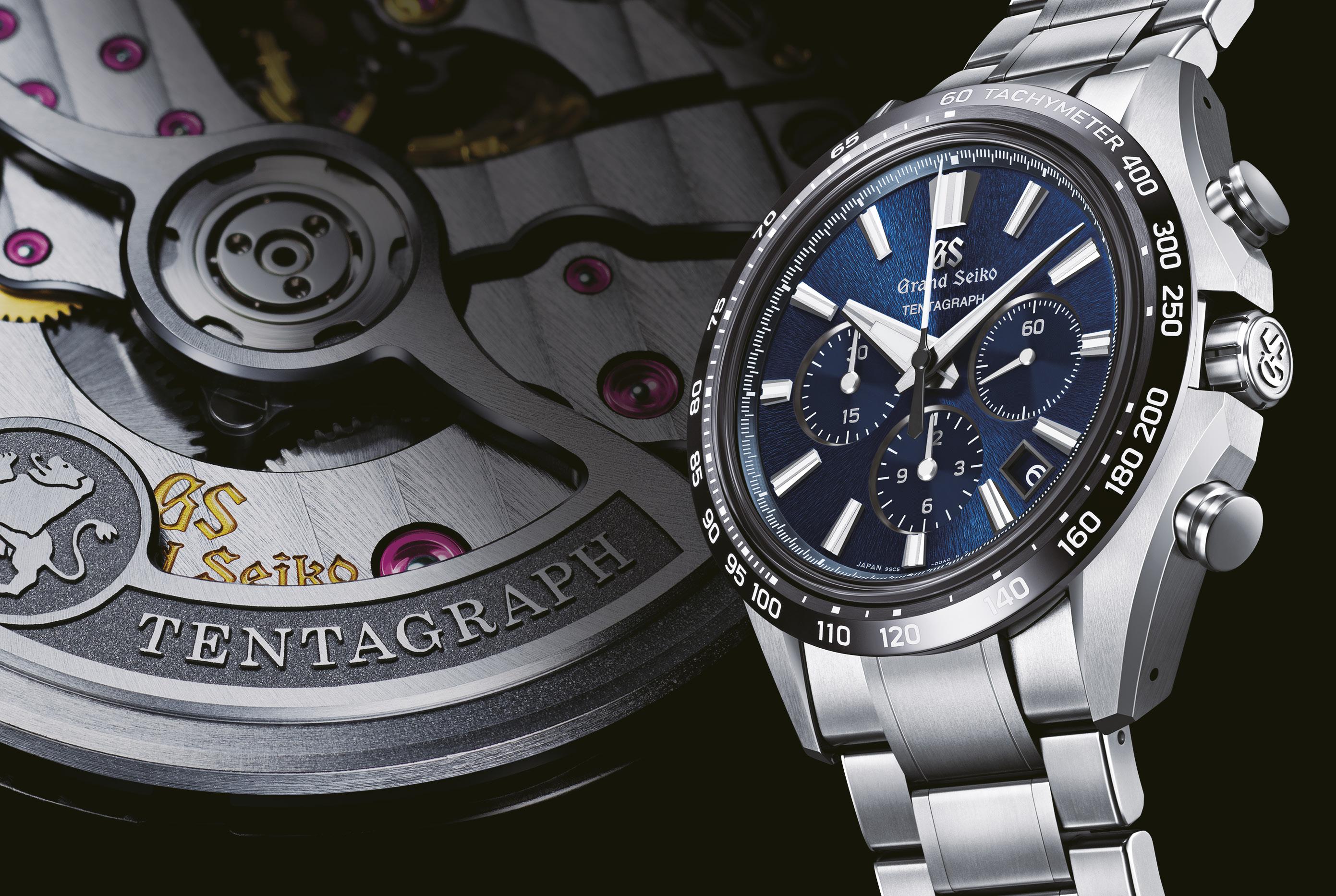

At Watches and Wonders
Geneva 2022, Grand Seiko introduced its first mechanical complication and a series of sports watches from the Evolution 9 Collection. This year marks a new milestone as Grand Seiko expands its Evolution 9 sports watch offering with its first mechanical chronograph: the Tentagraph.
What is a tentagraph, and why is it called that? A tentagraph is a watch movement that has TEN beats per second, Three days power reserve, and is an Automatic chronoGRAPH. Powering the
Grand Seiko Evolution 9 is the Calibre 9SC5 automatic movement. It vibrates at a frequency of 36,000 vibrations per hour (10 beats per second), has a power reserve of 72 hours, and a chronograph function with a 30-minute counter at 9 o’clock and a 12-hour counter at 6 o’clock.
The high-beat calibre has an energy-efficient escapement and two barrels, allowing the watch to run for three days, even when the chronograph is in operation. This gives the Tentagraph the title of the longest 3-day power reserve in the industry (based on Grand Seiko’s research as of March 2023).
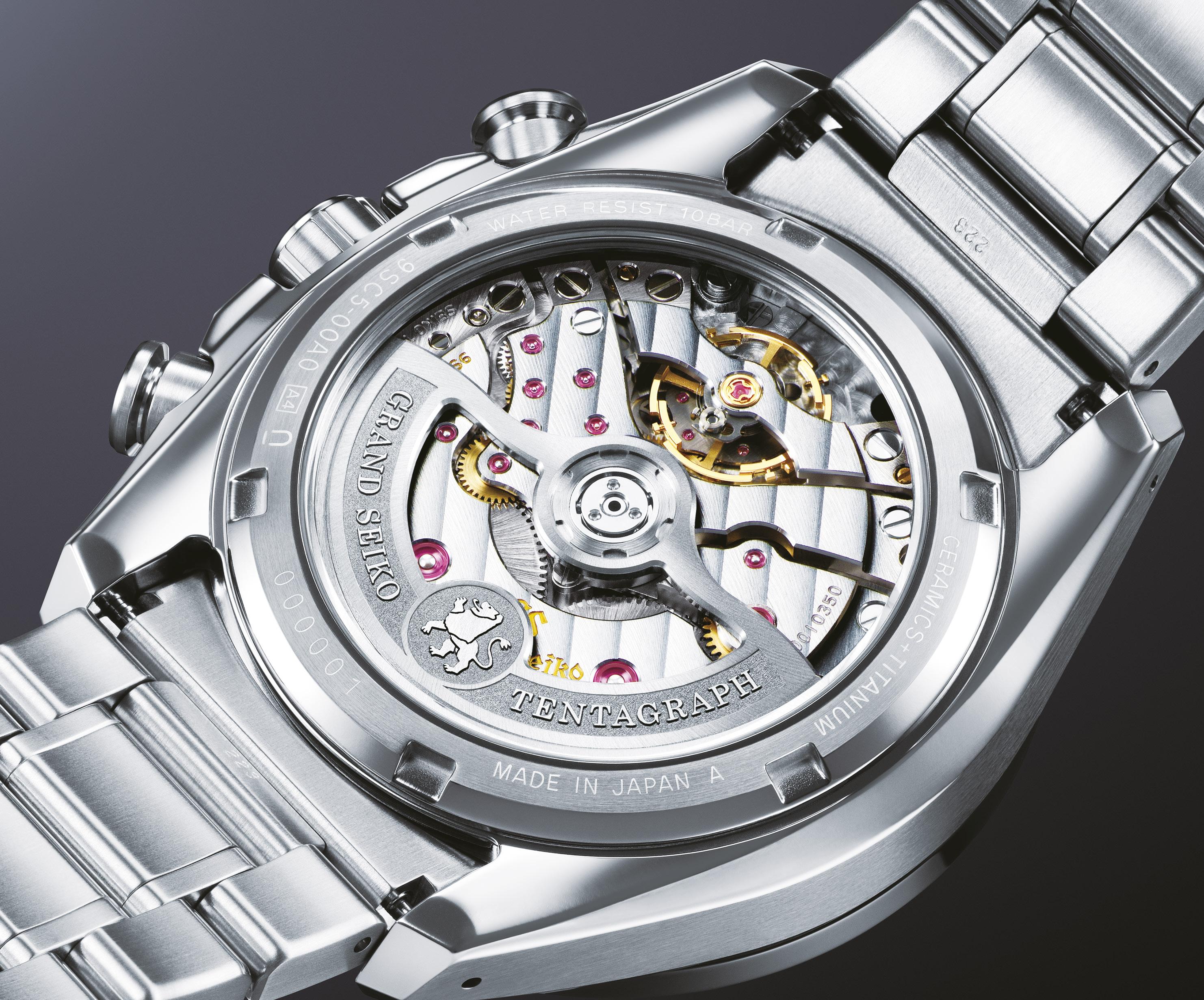
The Tentagraph is subjected to a new and longer testing procedure. As with all Grand
Seiko mechanical movements, the Tentagraph’s time-of-day accuracy is assessed in six positions and at three temperatures over a period of 17 days. Additionally, three more days of testing are added, during which the accuracy is assessed in three positions while the chronograph is in operation. Thus, a total of 20 days is spent testing the watch to ensure that it meets the Grand Seiko Standard of +5 to -3 seconds per day, slightly better results required by the COSC, which they pegged at +6 to -4 seconds per day.
The new movement features the revolutionary Dual Impulse Escapement, which efficiently transfers energy to the free-spring balance wheel indirectly through the pallet fork, and also directly
from the escape wheel. MEMS technology ensures extremely precise, lightweight, and highly durable escapement parts and also endows the escapement with increased energy efficiency to achieve a long power reserve.
A vertical clutch and column wheel ensure high accuracy and operability. The vertical clutch eliminates any shuddering or jumping of the hands when the chronograph is engaged, and also enhances measurement accuracy. The column wheel delivers precise control of the chronograph operation. The movement incorporates a threepointed hammer, which ensures that, when the reset pusher is pressed, the hands return to zero instantly and in perfect synchronization.
The hands and the prominent grooved indexes aid in reading the chronograph time, as well as the time of day, more accurately. The chronograph seconds hand is gently curved down towards the dial so that the tip of the hand is as close to the dial’s marker as possible. The minute hand is also gently curved to ensure the legibility of the time of day.
The dial features Grand Seiko’s signature “Mt. Iwate pattern,” which takes inspiration from the ridged contours of the nearby mountain visible through the windows of the Grand Seiko Studio Shizukuishi, where the Tentagraph and all other Grand Seiko mechanical watches are hand-assembled and adjusted. The majestic peak serves as an enduring inspiration for the brand. Combined with the gentle blue hue, the dial takes the imagination upwards towards the night sky above Mt. Iwate.

The case and bracelet are made of highintensity titanium, which is about 30% lighter and more scratch resistant than stainless steel. The two convex pushers ensure the operability required for measuring elapsed time at the highest level. It is water resistant to 100 meters and has a magnetic resistance of 4,800 A/m. The case measures 43.2 mm in diameter and has a thickness of 15.3 mm. The bracelet comes with a three-fold clasp with a push button release.

“The Tentagraph movement is tested for 20 days to ensure that it meets the Grand Seiko Standard of +5 to -3 seconds per day.”
ADDING SPLASH TO BASIC BLACK

Words by Katherine Cunanan

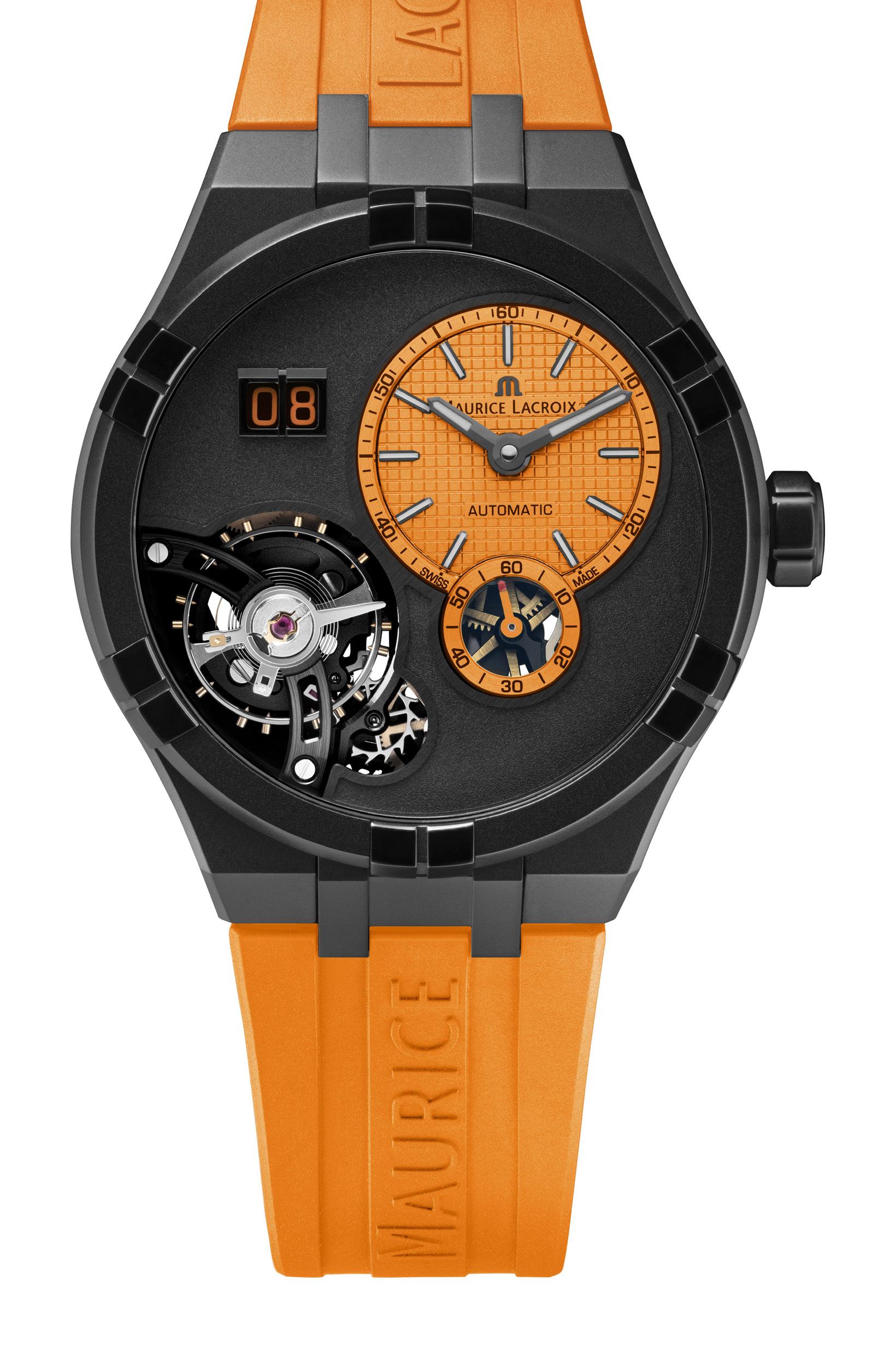

Nothing celebrates the start of summer fun like bright and lively colors. Thanks to Maurice Lacroix, we have four bright watch models to choose from as we herald the days of relaxation and enjoyment.
The Maurice Lacroix AIKON Master Grand Date Technicolor may be a mouthful to say, but it is indeed a fun watch to put on. It is interesting how the inspiration for the AIKON (pronounced ‘icon’) came from another watch within the
Maurice Lacroix wheelhouse: the Calypso. The Calypso watch was released by the brand in the 1990s and quickly became an icon.
The Calypso’s design aesthetic was critical in making it such a popular watch. The sapphire crystal was flat and clean, and the bezel featured the distinguishing arms, creating a look of strength without being overpowering. It was both sporty and elegant, which is sometimes a difficult pairing to master. The brand’s previous offerings were focused on quartz watches, but they decided to delve into the more exacting world of mechanical movements. With the success
of the Calypso, the brand saw the opportunity of creating another collection with the Calypso aesthetic as a starting point.
Initially released 2016, the AIKON took some of the design essentials of the Calypso, such as the six-arm bezel, and modernized them for a more to-the-day feel. The AIKON also has an integrated bracelet just like its predecessor, Calypso, and allows for visual continuity. There is a nod to the past with using these design elements, but also a look to the future in interpreting the elements in a different way. The all-black AIKON Master Grand Date was a sleek and stealthy watch that brought power and elegance together. Many see this as the watch for the millennial — bold, modern, powerful.

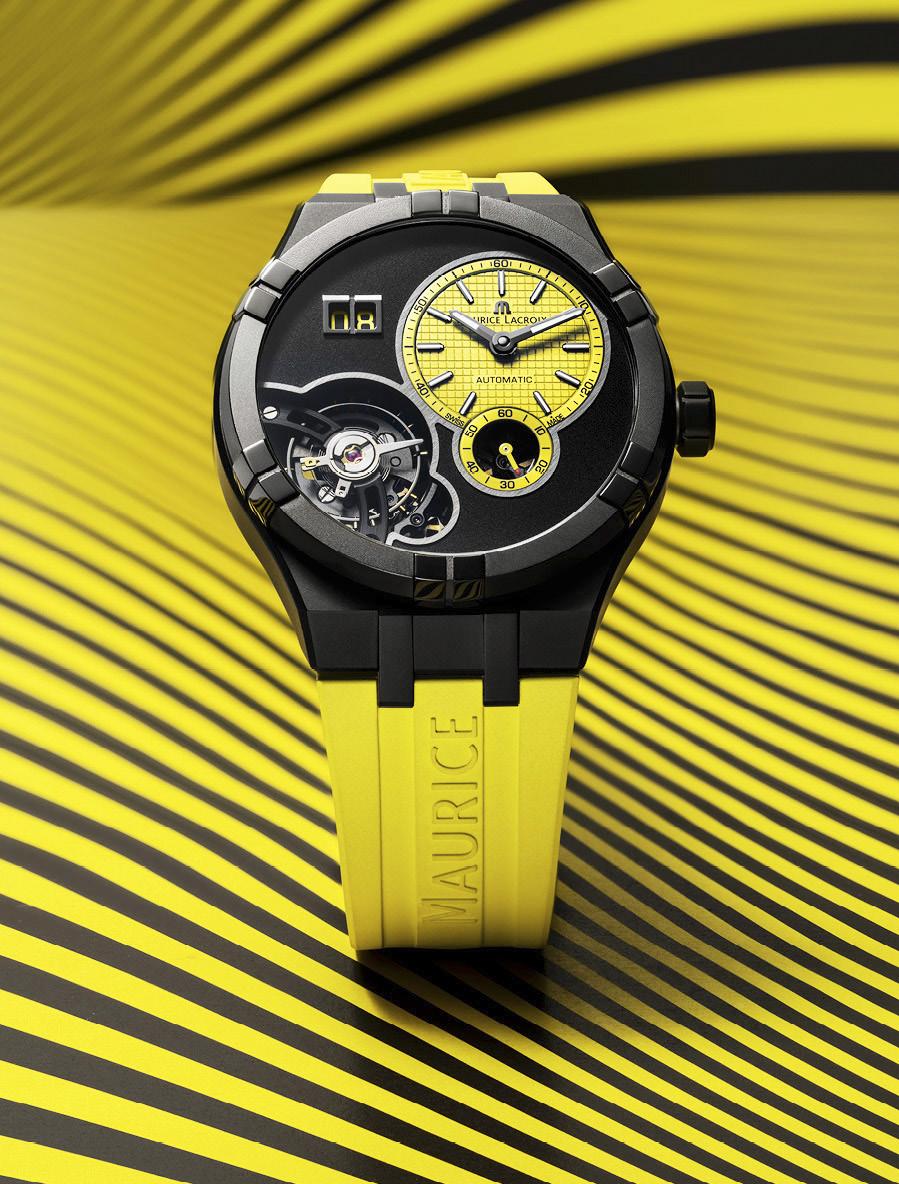


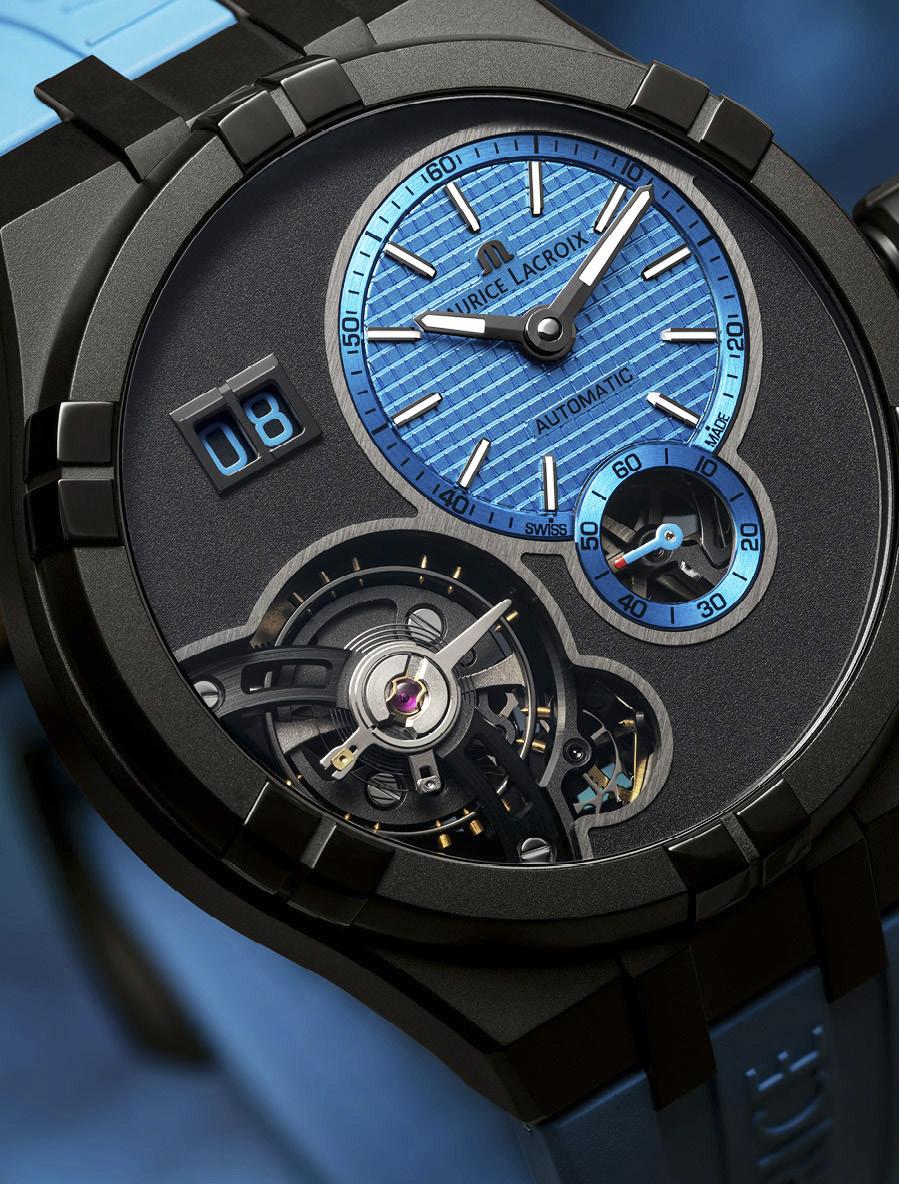
But once in a while, you need a splash of color… and the Maurice Lacroix AIKON Master Grand Date Technicolor answers that call. The AIKON in Technicolor has the serious horology props of the all-black version. The calibre LM311 is an in-house automatic movement, meaning no batteries needed here. There are 43 jewels and the watch has a power reserve of 50 hours. The stainless steel case is 45mm in diameter and is treated with black diamond-like carbon, or DLC. The DLC coating enhances the look while adding to the durability too.
Let’s not forget about the color though. While each case and dial is predominantly black, the off-center dial is a bright pop of color — electric blue, orange, green, or yellow. The rim of the subdial for the small seconds and the numerals on the big date at the 10 o’clock also have the same bright color. Look closely at the openwork small seconds and you’ll see a touch of red on the tip of the second hand, making it easier to read. The dial also has the additional design element of the clous de Paris pattern. It may seem like a small touch but it adds depth to the whole look of the dial and subdials.

The Grand Date is an interesting complication here. The date window on its own was not a common feature among watches prior to the 1930s. Some watches have a date function with both the single- and double-digits dates on one dial. With the AIKON Grand Date function, the date is presented on two discs, which means more tech know-how is needed to be sure the discs work in sync. The result is a smooth-cycling and larger, very easy-to-read date, and in the color of the dial.
Making the dial complete is the visible balance wheel that adds activity and interest to the dial. There are a lot of aspects to explore on the dial, but due to the original design aesthetic being so well planned, the dial does not look crowded at all.
The big blast of color comes from the rubber strap that matches the dial color. For days that you might want the power of an AIKON but something (slightly) more sedate, the watch comes with a second rubber strap in black. The AIKON has the Easychange system in place for the strap, so a change of look is simple. Both color and black straps have the brand name in the center portion. There are only 50 pieces in each color, for a total of 200 AIKONs in this collection.
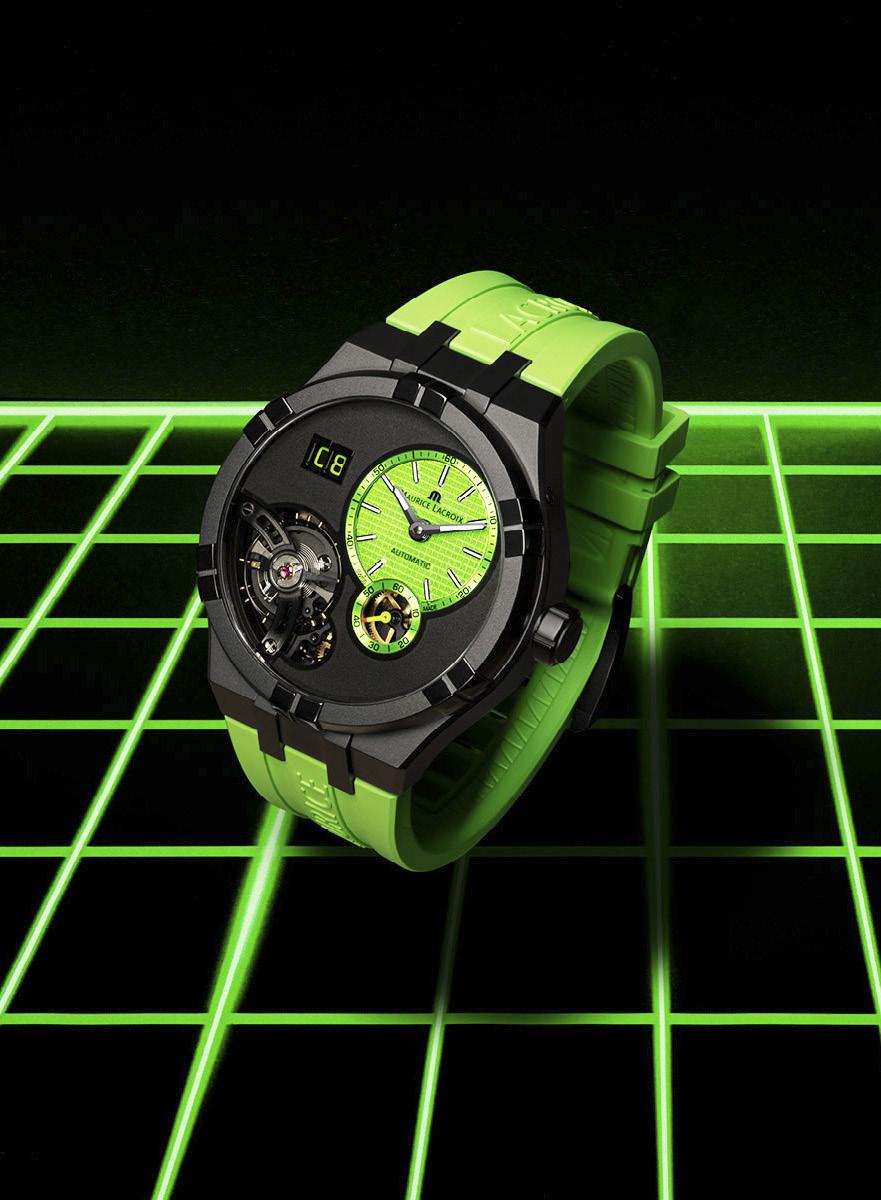
And though the AIKON Master Grand Date Technicolor is bold and attention-getting, please don’t think that Maurice Lacroix is all splash with no substance. Each watch in this collection has its own presentation box that is made from #tide, described as, “a composite material made from ocean-bound upcycled plastic.” Each presentation box has used 34 bottles that would have eventually made their way to the seas; the box is also in the dial color, so you’ll have some color on your shelf at home as well. Choosing an AIKON is not only good for your wrist, but also good for your heart, and our oceans.


“Choosing an AIKON is not only good for your wrist, but also good for your heart, and our oceans”

Full disclosure: mechanical watches with altimeter functions are few and far between but they do exist, however, none of them have automatic movements. The Oris ProPilot Altimeter is the only one that does.
First introduced in 2014 as a Big Crown ProPilot, it is the only timepiece that successfully combined an automatic mechanical movement with a mechanical altimeter in a single watch.
And that’s because unlike other watchmakers, Oris eschewed with the practice of employing hand-wound movements that connected the pressure box directly to the dial by going through the movement. A rotor would have gotten in the way of this connection. Instead, Oris developed what is essentially a second dial underneath its movement, which effectively decoupled the altimeter from the mechanical movement, all while keeping things svelte enough for comfort and allowing for the inclusion of a rotor.
Indeed, over the years, Oris has developed a reputation for developing high-functioning watches that deliver real world value. This has resulted in the development of more than 280 unique calibres and countless watches since 1904, many of which offer pioneering, useful, and easy-to-use complications. The Oris ProPilot Altimeter is one of those watches and continues the tradition that Oris carefully cultivated by not only accurately relaying the time but parlayed its “uniqueness” by being the only timepiece with an automatic calibre that can also relay air pressure and altitude from the same dial.
The ProPilot Altimeter may have spent some time away from the watchmaker’s line up but for 2023, Oris has brought the only self-winding timepiece with a mechanical altimeter back with a higher operating ceiling and a new high-tech, lightweight case.
Three years in the making, evolution not revolution, is once again the operative word here with the 2023 ProPilot Altimeter being near
“Oris developed what is essentially a second dial underneath its movement, which effectively decoupled the altimeter from the mechanical movement, all while keeping things svelte enough for comfort and allowing for the inclusion of a rotor”



identical to the design parameters of the original model. The big differences, however, begin with the next generation of mechanical altimeter. As before, two configurations are made available with models that can indicate an altitude of up to either 19,700 feet or 6,000 meters (up from the previous two Big Crown model’s ceiling of 15,000 feet or 4,500 meters, respectively). And in keeping with Oris’ mandate, using the new ProPilot Altimeter is as easy as pie.
When both crowns at 2 and 4 o’clock are screwed in securely, the ProPilot Altimeter functions like a regular automatic timepiece with a water resistance of 100 meters. Time is displayed via the hands on the central dial and adjusted by the crown at 2 o’clock. Unscrewing the crown at 4 o’clock into position 1, however, reveals a red ring on its stem and activates the altimeter.
Pulling the same crown to position 2 sets the altimeter, which is done by rotating the crown to the reference air pressure (supplied by an airport control tower, for example) until it aligns with the red triangle at 6 o’clock on the dial. The current altitude as shown by the yellow indicator, as well as the current absolute pressure as shown by the red indicator, are set at this point and the crown must be pushed back in to position 1. Changes in altitude are displayed by the yellow indicator against the outer dial ring on a scale from 0-19,700 feet, or from 0-6,000 meters.
It should be noted that pulling out the crown at 4 o’clock and using the altimeter negates the watch’s water resistance. However, a patented Oris altimeter-adjustment and venting crown, equipped with a PTFE vapor barrier, stops ambient moisture from entering the watch while the altimeter is in use.
The second upgraded element of the 2023 ProPilot Altimeter is a new lightweight carbon fibre case produced in conjunction with 9T Labs, a spin-off from the prestigious ETH Zurich University (Swiss Federal Institute of Technology) that focuses on what the company calls the “climate neutral mobility of the future,” which introduces new designs and new manufacturing standards with stronger and lighter parts, at lower costs and zero waste.

“Oris wanted a watch made of lightweight, extremely strong materials but in a new, innovative way,” says Giovanni Cavolina, co-founder and chief commercial officer at 9T Labs. “(But) watches produced using carbon fibre composite are two-a-penny, now. It’s become a bit boring, and the materials are not sustainable.”

Having had successful collaborations with the air, space, auto and medical industries, this is the first time 9T Labs has worked with any company connected with the watch industry, and led the company to use carbon fibre composites in a way never seen before. Indeed, the partnership with Oris resulted in a lightweight carbon fibre ProPilot Altimeter case with a unique and artistic but natural pattern using a unique, all-in-one manufacturing solution based on “additive manufacturing and molding.” According to Cavolina, this composite of carbon fibre and a polymer called PEKK has “high mechanical, heat and chemical resistance,” and forms a material that is “as light as plastic but stronger than metals.” Indeed, “The ProPilot Altimeter case’s natural, tree-ring effect cannot be achieved with any other technology,” confirms Cavolina.
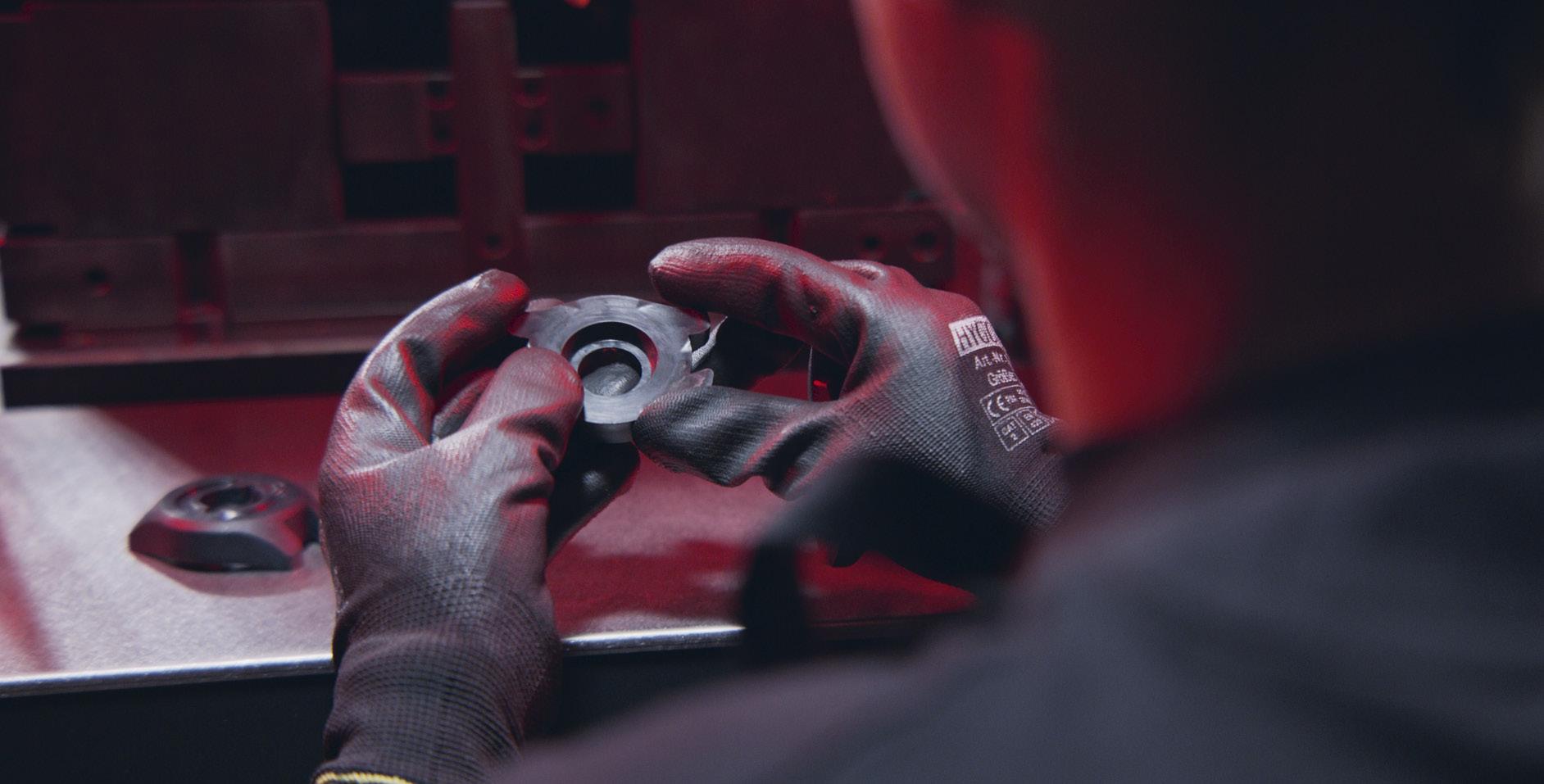

The resulting Oris ProPilot Altimeter with a titanium bezel and caseback is still the same size as the outgoing model at 47mm in diameter, but is 1mm thinner at 16mm thick. Still not “thin” by any means, but “thinner” none the less, and all the better to protect the Oris 793 calibre, which offers 56 hours of power reserve, and the aforementioned automatic winding along with the mechanical altimeter.
Probably far more useful to mountaineers, hikers, climbers, skiers, extreme sports enthusiasts, and technical nerds who appreciate the ingenuity of this high-function timepiece, the Oris ProPilot Altimeter (2 models with altitude in scales in feet or meters) is matched with a green textile strap with brown leather lining, and fastened by a grey PVD-plated titanium folding clasp with a fine adjustment system.


FREDERIQUE CONSTANT RELEASES TWO NEW VERSIONS OF THEIR ANNIVERSARY TOURBILLON.

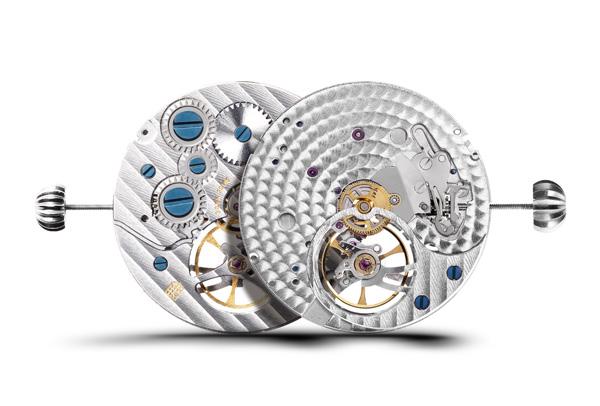
 Words
Words
by
Bert CasalFollowing the success of an initial limited anniversary edition in rose gold unveiled at Geneva’s Watches and Wonders show, Frederique Constant is now offering collectors two all-new variations of its Manufacture Tourbillon in a 39-millimeter steel case with either a blue or a silver dial. Its contemporary look is a perfect complement to the classic design, and fits perfectly alongside the original rose gold version.
Frederique Constant was born in 1988 when Aletta and Peter Stas started designing their own watch collection. After four years of hard work, they released the 18th Century Collection, equipped with Swiss movements. Two years later, they launched the first Heart Beat timepiece that featured an aperture on the dial at 12 o’clock to show the “heart” of the mechanical movement. This design was so popular that it became the Brand’s signature collection.

As the years went by, Aletta and Peter Stas have produced many milestones, such as moving their production offices from Carouge, Geneva to a larger site in Chêne-Bourg, opening an exhibit at Baselworld, and launching their first Manufacture calibre, the FC-910, which was developed and assembled entirely in-house. In 2006, they launched a new Manufacture building based in Plan-les-Ouates. Two years later, they introduced their first Tourbillon Manufacture, equipped with the FC-980 Manufacture calibre that featured a silicon escapement.
 Founders Aletta and Peter Stas
FC-910
FC-980
Manufacture Classic Tourbillon FC-980G3H9
Founders Aletta and Peter Stas
FC-910
FC-980
Manufacture Classic Tourbillon FC-980G3H9

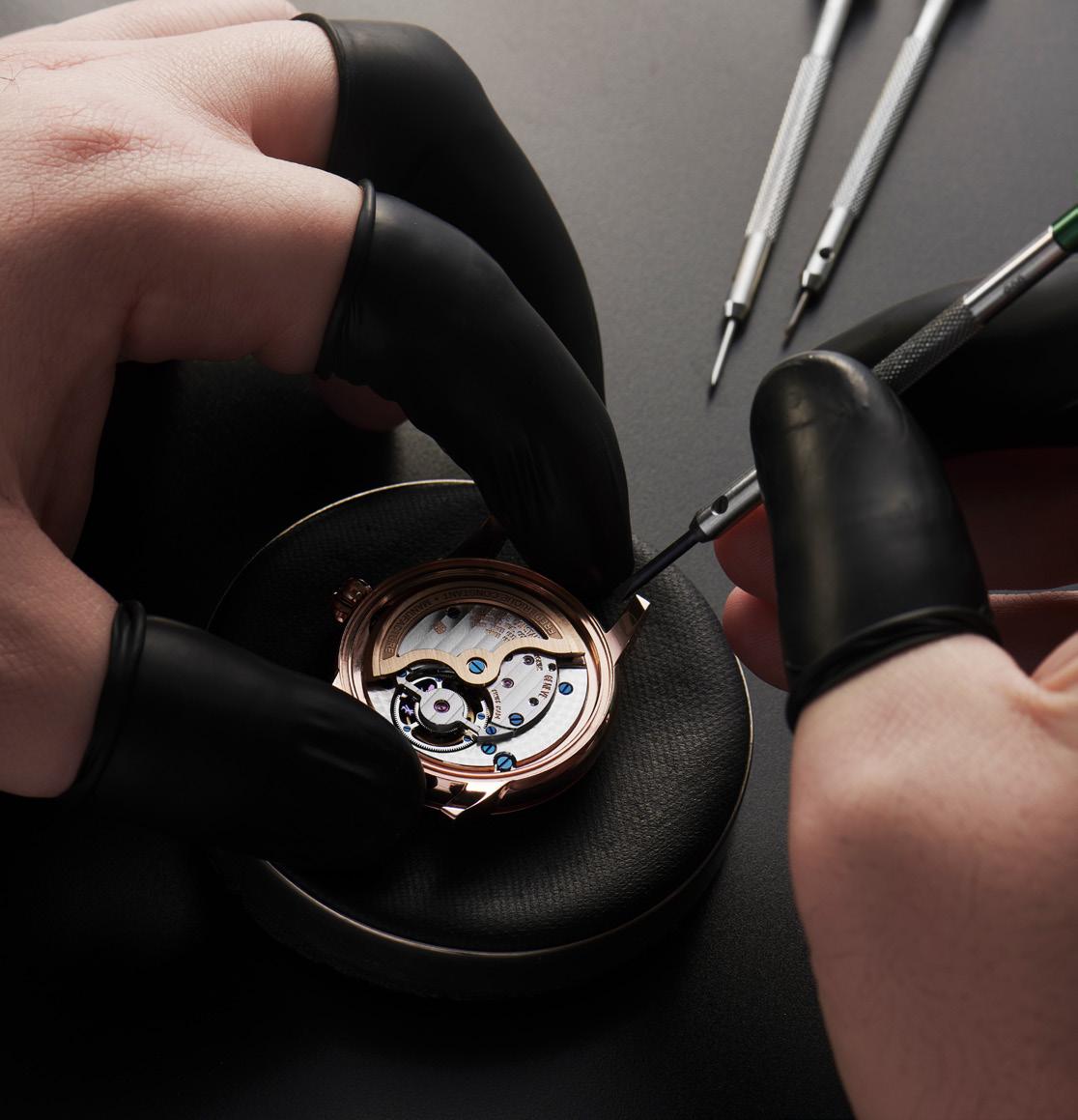
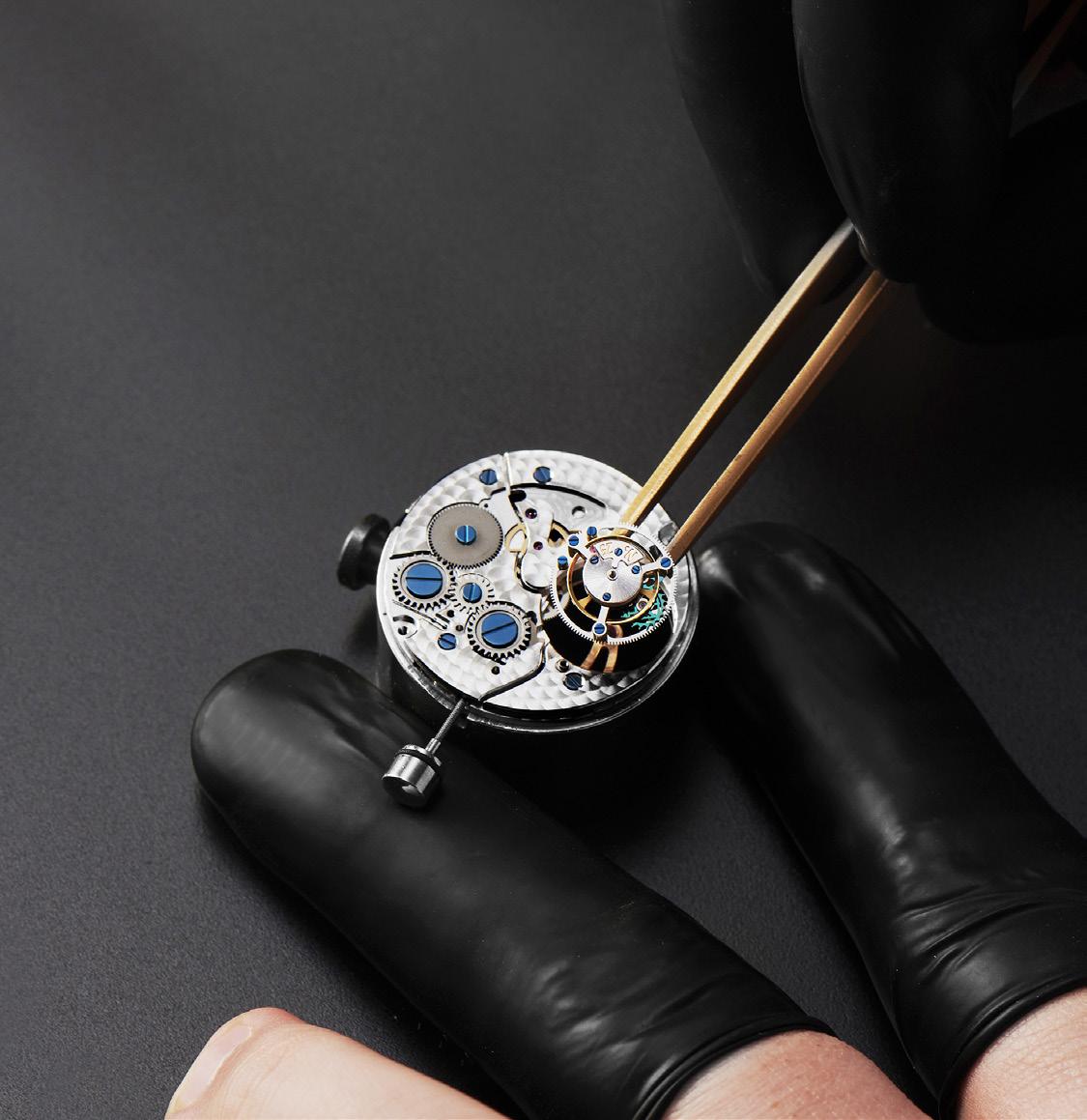
“The tourbillon at 6 o’clock reveals the exquisite highlight of the timepiece that is equipped with a silicon escapement wheel and anchor.”
The tourbillon is one of the most sought-after complications, as it improves the accuracy of the time-telling capability of a watch. To illustrate, let us take the example of a car running at 80 km/h with the cruise control turned on. On flat roads, the car will run at that constant speed. Once the car climbs a hill, the force of gravity will cause the car to slow down. The cruise control will now add power so that the car will run at 80 km/h up that hill.
The heart of a mechanical watch is composed of the balance spring, the balance wheel, and the escapement. These are the parts that dictate how slow or how fast the hands of the watch turns; in other words, the time-telling accuracy of the watch. These parts work best when laid flat on a table. But since we wear watches for the most part of the day, we know that it will be in different positions while it is on our wrist. These different positions are akin to a car traveling on roads with different elevations without cruise control.
A tourbillon addresses this situation by putting the balance wheel, balance spring, and escapement inside a cage that rotates constantly. The result of this action makes the “heart” of the mechanism produce the same output of energy at a constant pace. In layman’s terms, the tourbillon allows the hands of a watch to move at a constant speed all the time, no matter what position the watch is in. In a word: accuracy.
This year, 2023, is another milestone in Frederique Constant’s history. First of all, it is the Brand’s 35th anniversary. Secondly, it is the 15th anniversary of their first Manufacture tourbillon movement. These two anniversaries called for a celebration, hence the release of a rose gold edition of their Classic Tourbillon (limited to only 150 examples) revealed at this year’s Watches and Wonders. The classic design was given a contemporary look to stay in tune with the times. But Frederique Constant didn’t stop there. They just recently released two new variations of this timepiece in a 39-millimeter steel case: the first in a sun-brushed midnight blue dial and the other in a sun-brushed silver dial.




The two new steel models share the same design cues as the rose gold brother. It has a 39-millimeter case that fits well on the wrists of both men and women. They have a minimalist, contemporary decoration that has been adopted for the dial. Its slim hour markers are diamondcut and applied by hand. The same technique was used for the hands, resulting in a hand polished finish. Below 12 o’clock is the “Frederique Constant” signature. They are powered by the automatic calibre FC-980 that holds a power reserve of 38 hours and beats at a frequency of 28,800 alt/h. Both are presented with an alligator leather strap with folding buckle. And of course, the opening at 6 o’clock reveals the exquisite highlight of the timepiece: the tourbillon.
The tourbillon is equipped with a silicon escapement wheel and anchor. This means that the movement is more resistant to the adverse effects of magnetism and temperature variations, making the watch even more precise, enhancing the effects of the tourbillon.
One of the attractions of a Frederique
Constant watch is its price point. They create well-crafted, Swiss Made luxury watches at fair prices, allowing you to Live Your Passion. The two new iterations of the Classic Tourbillon are limited to only 350 pieces each.

Words by Kit Payumo
One of the most iconic aircraft in the Royal Air Force’s history, the Avro Vulcan was a jet powered, tail-less, delta wing, high altitude strategic bomber operated by the RAF from 1956 to 1984. The Cold War successor to wartime British heavy bombers like the Avro Lancaster, the Vulcan is probably the most famous of the British “V’ bombers, which included the Vickers Valiant and the Handley Page Victor, and was one of the first operational RAF aircraft with a delta wing. It was known not only for its distinctive shape, but also (especially if you grew up in certain parts of the UK) for its unmistakable howl that has been described as part roar, part primeval belly scream.
Its most famous role was being one of the main delivery agents of Britain’s independent nuclear deterrent during the Cold War. Indeed, the Vulcan was the backbone of the United Kingdom's airborne nuclear deterrent with 70 Vulcans in service (compared to 50 Valiants, and
39 Victors), and even if the Vulcan was typically armed with nuclear weapons it could also carry out conventional bombing missions, which it did in Operation Black Buck, the longest bombing raid in history, which took place during the Falklands War between the United Kingdom and Argentina in 1982.

The prototype B-1 first flew on August 30, 1952 but had no defensive weaponry and relied heavily upon its high-speed and high-altitude capabilities to evade interception. It wasn’t until the improved B-2 that was introduced in 1960 that electronic countermeasures were installed. It was powered by four more powerful Rolls-Royce Olympus engines, a larger wing, an improved electrical system, and had a top speed of over 600 miles per hour.
Originally painted in bright ‘anti-flash’ white suited for operating at high altitudes, the Vulcan was re-tasked for low-level tactics in the mid1960s thereby gaining the camouflage pattern the aircraft was famous for. By the time the 1970s came around, the Vulcan was re-tasked again, nine of which were adapted for maritime radar
reconnaissance operations, and during its final years of service, six Vulcans were converted to the K.2 tanker configuration for aerial refueling.
The Avro Vulcan flew for the last time in October 2015 but even after retirement from the RAF, several aircraft have survived and are housed in museums in both the United Kingdom and North America (USA and Canada). One example named The Spirit of Great Britain was restored for use in display flights and air shows, and took part in the RAF’s Vulcan Display Flight until 1993. It was later restored to flight by the Vulcan To The Sky Trust and displayed as a civilian aircraft at the Doncaster Sheffield Airport from 2008 until 2015.
Two other Vulcans based at Southend Airport in Essex, England and at the Wellesbourne Mountford Airfield in Warwickshire, England have been kept in taxiable condition for ground runs and demonstrations, while an Avro Vulcan B-2 is also on display at the Solway Aviation Museum at the Carlisle Lake District Airport. As a longstanding supporter and partner of His Majesty’s Armed Forces, British watchmaker Bremont is
celebrating this iconic symbol of British aviation and engineering with a commemorative limited edition timepiece called the Bremont Vulcan Monopusher Chronograph.
Bremont Co-Founder Giles English says: “The Vulcan’s legacy as a symbol of British military power and technological innovation continues to be celebrated today, and it remains one of the most iconic aircraft of the Cold War era. As aviators ourselves, celebrating such remarkable aircraft and feats of engineering is truly inspirational and it’s fitting to incorporate these commemorative pieces within our Armed Forces Collection through Bremont’s partnership with the MoD.”
Indeed, as the official partner of the UK’s Ministry of Defense Bremont is the sole luxury watchmaker licensed to use the signs, symbols and heraldic badges of all three branches of the British armed forces: the Royal Navy, British Army, and the Royal Air Force. The resulting Armed Forces

Collection, made up of the Argonaut, Broadsword and Arrow is the epitome of authentic military inspired timepieces done in that bespoke, stiffupper-lip, British manner. The new Bremont Vulcan Monopusher Chronograph is no exception.
Limited to only 250 pieces, the Vulcan is not only modelled on the base architecture of the Arrow, it also weaves in subtle details synonymous with the historic aircraft. This means the 42mm, 100m water resistant, two-piece case is crafted from the hardened stainless steel used by the Ministry of Defense and features polished and satin-finished surfaces. While the running seconds sub-dial at 9 o’clock of the Vulcan’s matte black dial features the two-tone 3D camouflage design famously worn by the iconic aircraft, and the elapsed minutes counter at 3 o’clock underscores a subtle nuclear symbol hinting at the deadly nuclear arsenal the aircraft carried onboard.

Being an authentic military inspired timepiece, legibility is naturally emphasized with a high degree of blue emission white Super-LumiNova applied across the dial. This includes the elegant skeletonized cathedral hour and minute hands used by Bremont for the first time, the Arabic numerals, the hour markers and the sub-counter hands, the distinctive details of which were inspired by the cold-war clocks found in the Vulcan cockpit. Complementing everything is a striking RAF Blue chronograph hand, the color of which is repeated on the year of the inscription:
“Avro B-1 1952,” which appears over the date window at 6 o’clock and is in reference to the B-1 Vulcan prototype that first took flight in 1952.

Turn the watch over and an engraving of the Avro B-1 Bomber and the heraldic badge of the Royal Air Force are revealed on the solid caseback. And since this model was designed and approved by the MoD under Her Majesty’s Reign, the engravings are encircled with the same inscription on all the Bremont pieces from the Armed Forces Collection up until 2023:
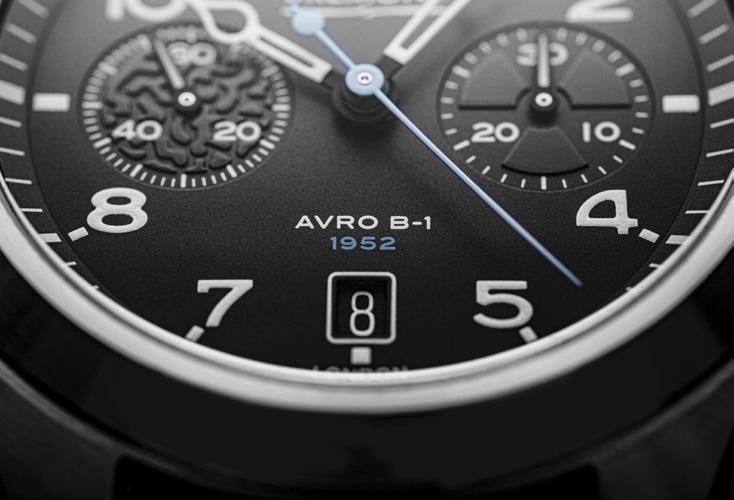
“APPROVED BY HER MAJESTY’S ARMED FORCES.” Once the crests of His Majesty’s Armed Forces have been decreed, all case backs within the collection will be updated accordingly.
Operated by a single pusher at 2 o’clock, the Bremont Vulcan Monopusher Chronograph is powered by the BE-51AE, a manually wound movement that was modified from the Sellita SW510 MP at Bremont’s Henley on Thames headquarters. The movement runs at 28,800vph,

has a power reserve of up to 56 hours when fully wound, and is chronometer certified.


The Bremont Vulcan is offered with a sailcloth strap colored in RAF Blue that further complements the steely blue countenance of the Arrow case. An additional sailcloth strap, also in RAF Blue but with a camouflage pattern that mimics the pattern worn by the iconic aircraft is also included. The result is a stealthy militaryinspired chronograph that is so very subtle, but so very British. Best of all, the set is enhanced by elegant silver cufflinks in the shape of the Avro Vulcan, which incorporate aluminum from the original airframe of Avro Vulcan XH558 ‘Spirit of Great Britain’, the final Vulcan in military service.

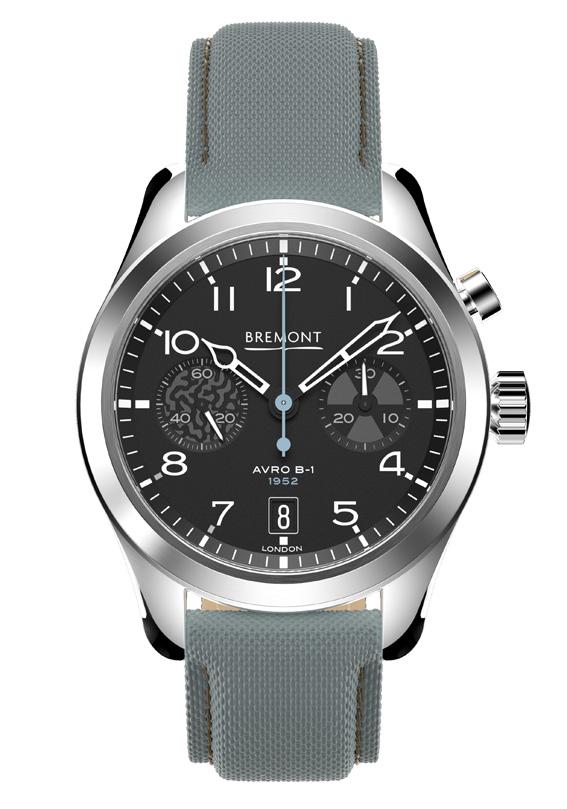
The new Bremont Vulcan is a shoe-in for history buffs and fans of iconic British aircraft from the Cold War. But it will also appeal for those looking for a military-inspired luxury chronograph that also happens to have one hell of a back story to tell.
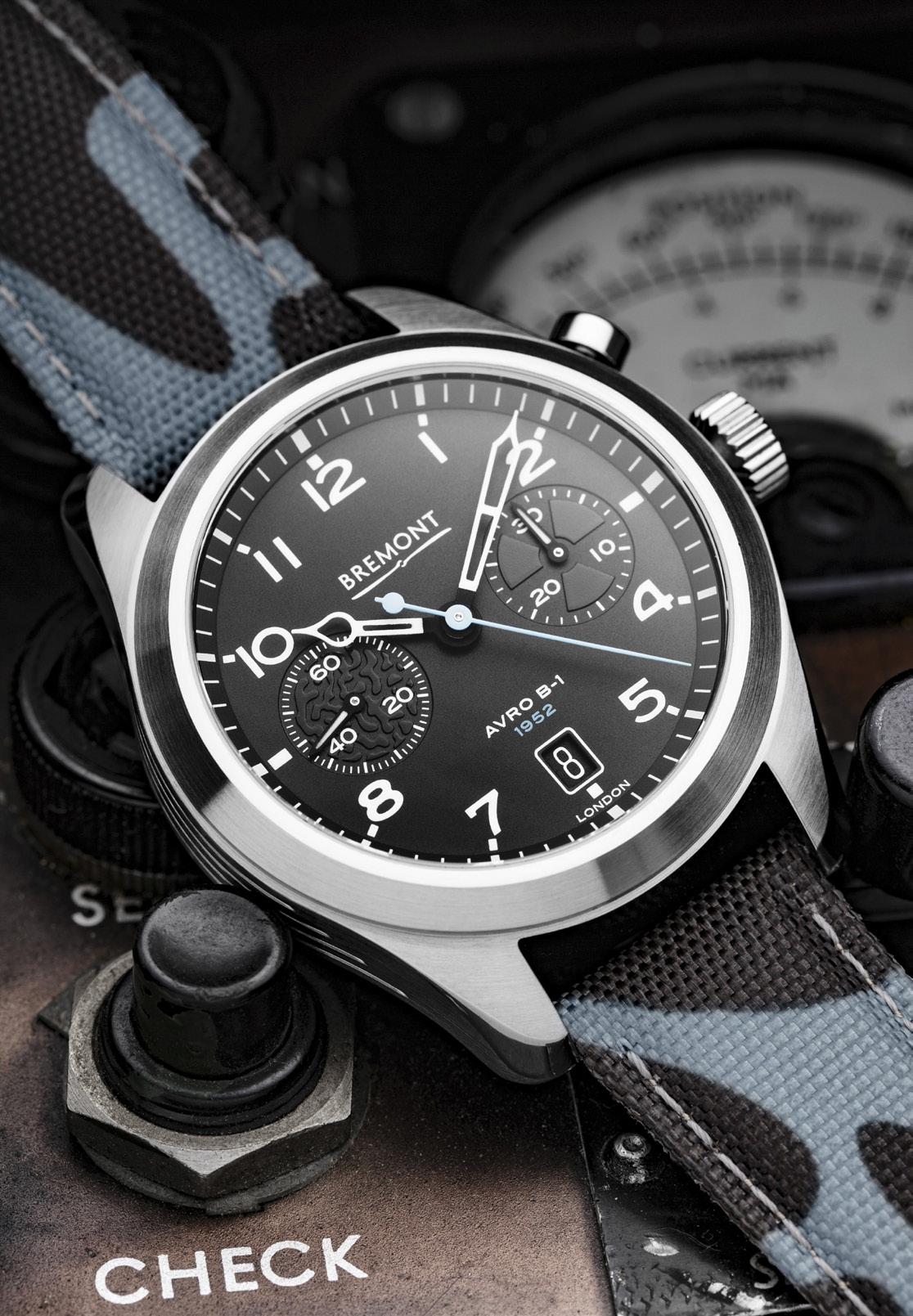


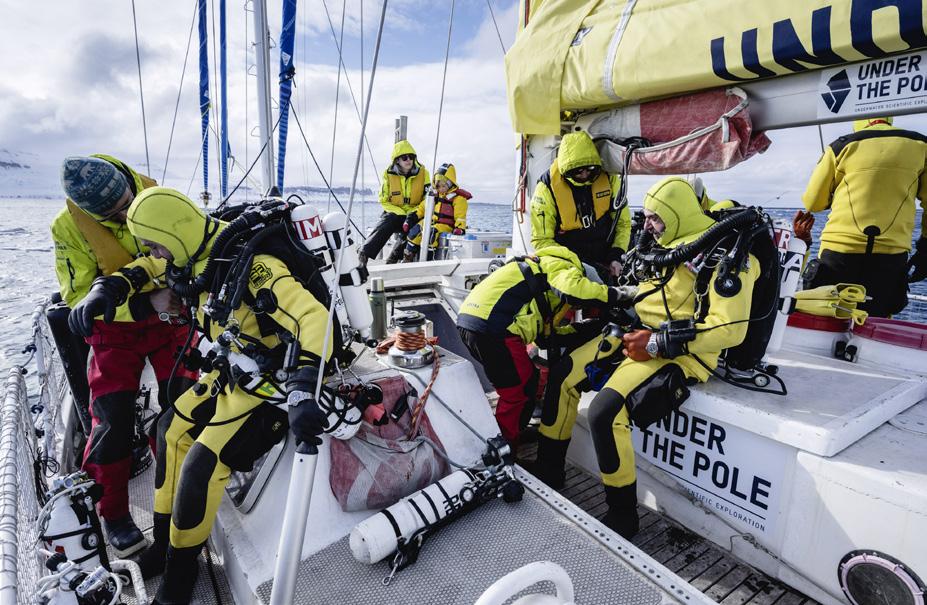










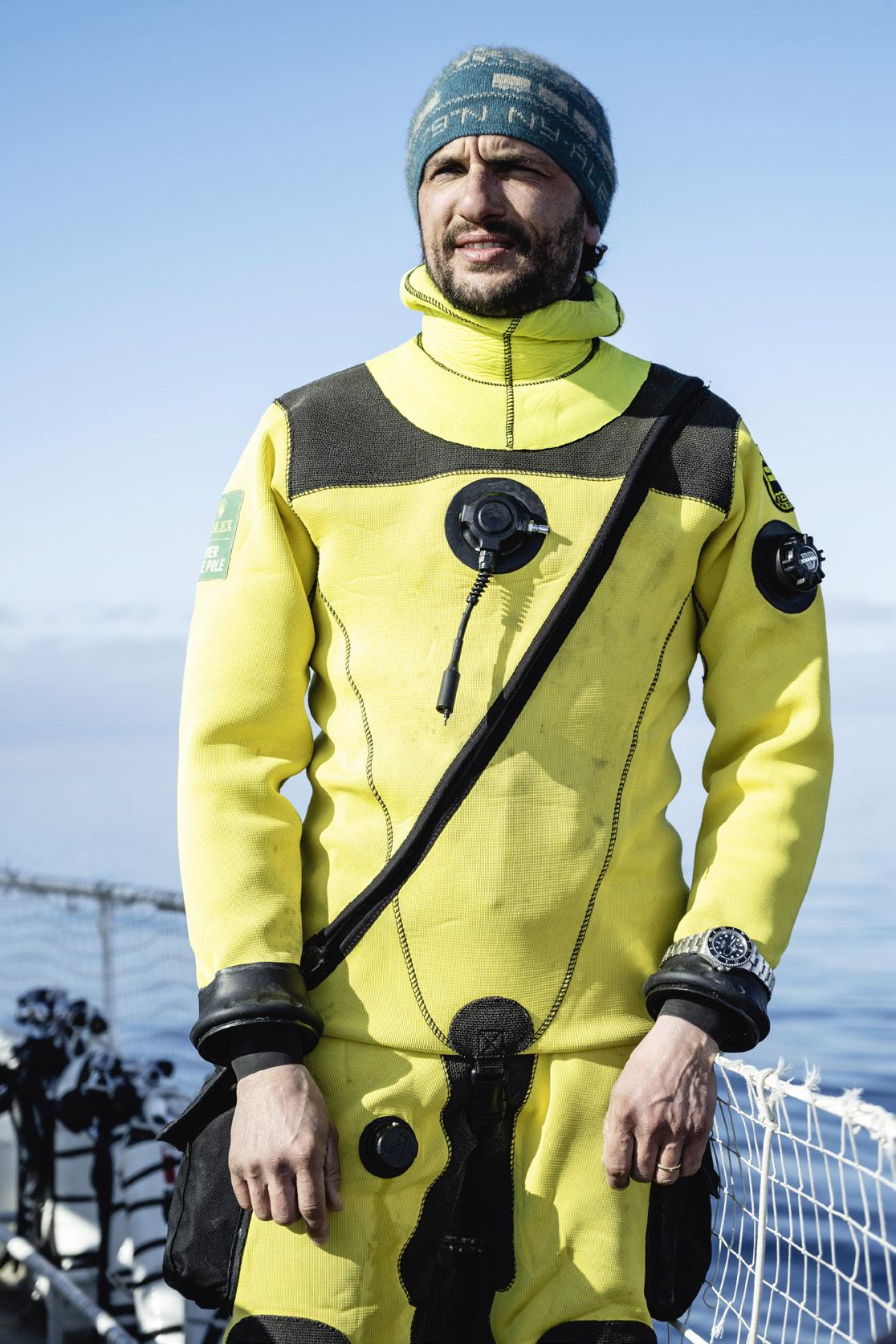
When most people hear ‘Rolex’ and ‘Perpetual’ in the same sentence, the mind often jumps to the Rolex Oyster Perpetual. The watch is a classic timepiece, often described as perfect in form and function, and has many models to choose from. Some are more subtle in style, while others have a brighter color palette.
‘Perpetual’ is defined as continuing forever, everlasting, unending. Rolex watches are built to be exactly that — they are meant to last forever. But Rolex the Brand looks beyond Rolex the Watch and sees the importance of true perpetuity of Earth, our planet, and our home. We would have less need for watches, and indeed, anything, if our home planet were to disappear.
Rolex has often supported and encouraged explorers and adventurers to seek what is out there, and see how far man (or woman) can take things. Respect for Mother Nature and all the extreme environments she has provided is evident in the programs they support and the watches they create to survive in the different environments.
In 1976, Rolex created the Rolex Awards for Enterprise in part to celebrate the 50th anniversary of the Rolex Oyster. The Awards were meant as a means of philanthropy for individuals who were involved in worthy causes, but did not always have easy access to funding and finances. Since the Awards began there have been more than 35,000 applicants and 155 laureates.
The Rolex Perpetual Planet Initiative was initially launched in 2019, and was seen by some as an extension or enhancement of the Awards. Focus was on those individuals and programs that safeguard our oceans, such as the Mission Blue and the National Geographic Society. The partnerships have expanded over the years, and now include programs that support protecting landscapes, transplanting corals to enliven reefs, exploring the major river basins, and similar nature conservation efforts.
One of the most exciting adventures supported by the Perpetual Planet Initiative is Under The Pole and their expedition series, Under The Pole IVDEEPLIFE 2021-2030. Co-founded by husband and wife team Ghislain Bardout and Emmanuelle Périé-Bardout, this long-term programme intends to document marine animal forests in each of the
planet’s oceans. Yes, forests in the oceans, deep in the oceans. The ultimate goal is to further understand and protect these forests. Choosing where to begin the exploration is a critical step. The expedition team studied records of ocean currents that registered a strong enough current to sustain marine animal life yet also carry in nutrients. The area in Svalbard archipelago had been identified, but they needed to narrow it down. Once the ideal locations were pinpointed, the team needed protective gear too, since the temperatures there often dropped t to -30° C. All this in search of the elusive underwater forests.
Known for rugged terrain and often described as ‘unspoilt, raw Arctic wilderness,’ the Svalbard archipelago off the northern coast of Norway is inhabited by (hopefully friendly) polar bears, reindeer, and Arctic foxes. Interesting to note, the Aurora borealis, or Northern Lights, are visible from this area during the winter. Much of the land is protected so it is an ideal location to view wildlife (did you see the mention of polar bears and reindeer?) in the natural habitat. And that habitat extends to below the water’s surface.
The seas off the Svalbard Archipelago, unfortunately, seem to be warming faster than elsewhere on the planet. Though much of the Arctic Ocean is still covered in floating sea ice, there is half than what there was 4 decades ago. Studying this rich environment now is of critical importance. Who knows what will be around to study if we wait another 4 decades.
Recreational divers usually dive to around 30 meters, or roughly 100 feet, to start; some more serious divers go a little bit deeper. But the Under The Pole IV divers planned to venture to even as deep as 200 meters to reach these underwater forests. The marine world at that depth is different, partly because of the lack of

sunlight. Corals and soft corals, also known as gorgonians, and sponges can thrive there even without sunlight.
Diving this deep takes more than courage, you also need really specific gear. Diving into the ocean always has the possibility of threat and danger, more so if you go into areas that have not been explored previously. The danger (and thrill) multiplies exponentially when you are in Artic waters, colder than imaginable. Because the divers go so deep, the usual SCUBA gear is not adequate. They needed specialized rebreather equipment that would recycle unused oxygen from what they had exhaled, allowing an extension of the air supply.
As Emmanuelle Périé-Bardout, Co-Director of Under The Pole, confirmed, “These are really rough, difficult dives and you need to have the passion for scientific discoveries to be able to go there. There is no room for error.”
Explorers need a combination of talents and skills in order to be successful. Having the technical know-how and expertise is important of course, but so is the ability to think outside the box and to be resolute in reaching your goal. Resilience is critical too, as the team found out in their series of dives. The first few dives, they came up with, well, nothing.
And here is where resilience paid off. On the final dive of that series, the expedition hit pay dirt. Or more accurately, marine animal forest dirt. They found hydroids between the 50- and 80-meter depth; hydroids are animals related to jellyfish and corals and they resemble bells and ferns, and even flowers. Yes, just like a real forest.
As Emmanuelle Périé-Bardout, Co-Director of Under The Pole, shared, “It’s very exciting to think that we have found the first underwater Arctic animal forest. We’ll be able to come back and see how it evolves, which is extremely valuable for science… If we succeed in revealing these forests to the world, and they are protected, that would be my greatest achievement.”
Rolex supports and encourages programs like Under The Pole, which benefits all of mankind. There is no telling how what they learn will transfer into knowledge for different industries.
As
GhislainBardout, Co-Director of Under The Pole, explains, “These underwater forests are exactly the same as the forests we have on the surface, on land. They are three-dimensional structures that will shelter life.” We should all be so dedicated to studying and preserving our home planet for the future.
Gray skies or sunny, Geneva is always interesting. Interspersed between modern buildings and older structures you can often choose your path to see the prettier stuff.


